Madagascar Travel: 33 Things You Need to Know Before You Go
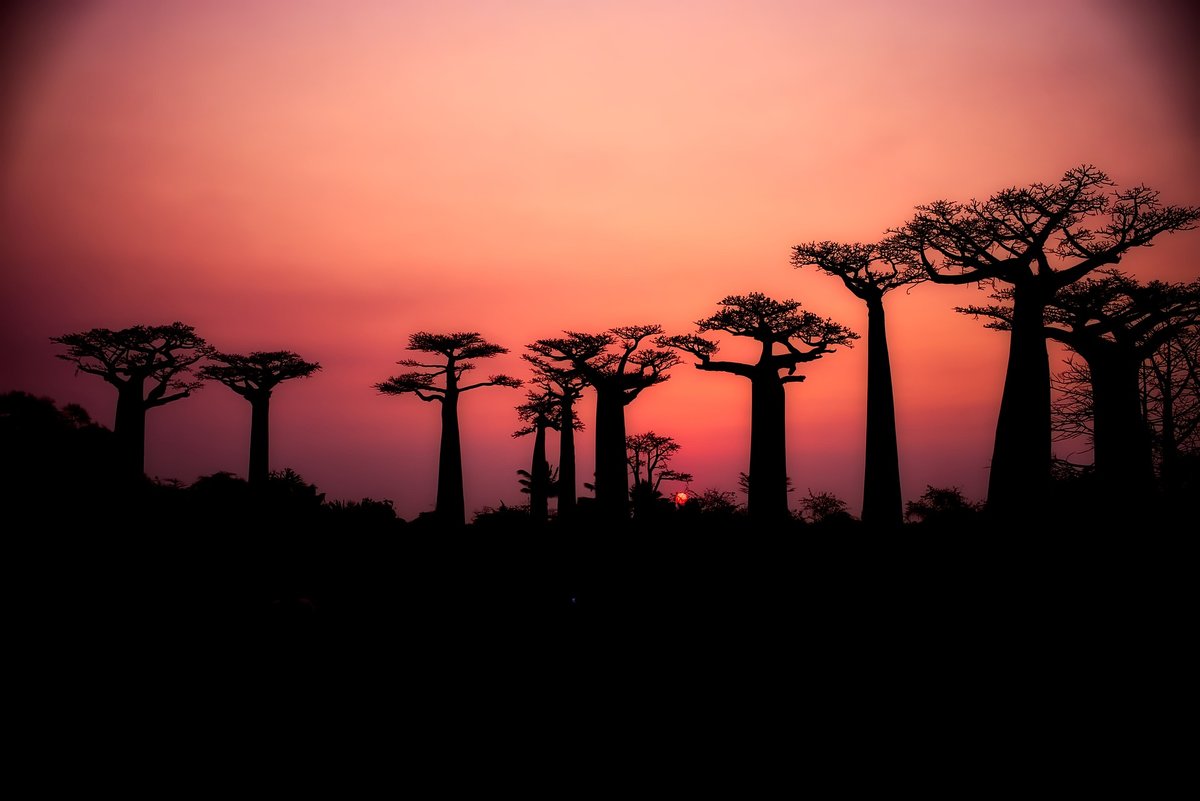

33 tips that will help you travel in Madagascar and make your time in this unique country so much more enjoyable.
Table of Contents
These travel tips are aimed to help you prepare for an unforgettable journey to this bizarre “ Red Island !” Written by an adventurer who’s spent more than a year in Madagascar, it’s the real deal.
The 33 recommendations below ( in violet ) are divided into 11 main sections ( in green ). This will make it easier for you to find the answers to a specific question.
HEALTH AND WELLNESS IN MADAGASCAR
Vaccinations to get before visiting madagascar.
- Visit a travel doctor well in advance. There are vaccinations you may need to be administered. These may take weeks to become effective. Refer to your vaccination records. Make sure you are up to date on the following: Typhoid, Hepatitis A, Hepatitis B, Meningitis, Polio, MMR, Tuberculosis (BCG) and/or Tetanus (DTP).
- You don’t need the Yellow Fever vaccine for Madagascar. However, if you plan to travel in mainland Africa on your way there, you DO need it. You will also need to provide proof of administration upon entering Madagascar if they see African countries stamped into your passport within the past 6 months.
Malaria Prevention
- You should discuss a Malaria prophylaxis prescription with your doctor. This is especially true if you are travelling between September and May. This is Madagascar’s warmer, rainier season.
- Take every day – tetracycline antibiotic.
- Pros : Least expensive, used to treat many bacterial infections (ex: urinary tract infections) and tick-borne infections. A double dose can be used to treat Malaria if someone in your group contracts it.
- Cons : Side effects may include sensitivity to the sun, increased likelihood of vaginal yeast infections, and weakened gut microbial health.
- Suggestions : Doxycycline is the prophylaxis I prefer. I just prepare for the side effects. I bring and use plenty of sunscreen and take probiotics to help my gut microbiome recover. Additionally, my doctor writes me a prescription for a burn cream (in case of sunburn), and treatment for yeast infections ( Fluconazole ).
- Take every day. It prevents the growth of parasites in red blood cells.
- Pros : Specific for malaria and also may be used for treatment.
- Cons : Relatively expensive. Its side effects may include mild stomach pain and diarrhea, headaches, difficulty sleeping, and vivid dreams.
- Take once a week. It prevents the growth of parasites in red blood cells.
- Pros : Don’t have to remember to take it every day.
- Cons : It. Has the most serious side effects. They include dizziness, severe anxiety, violent dreams, paranoia, hallucinations, depression. These nerve and psychiatric effects can sometimes last long after you stop the medication.
- Insect repellents. In addition to long pants/sleeves, they are the obvious methods of limiting mosquito bites. But they also help prevent flea bites. The bubonic plague is still present in Madagascar. It’s seasonal and rare but is transmitted through flea bites.
First Aid and Medications While Travelling in Madagascar
- You should have antibiotics , such as Ciprofloxacin. It will be useful in the event that you get a bacterial infection.
- If your burps begin smelling like sulphur and rotten eggs, you likely contracted Giardia parasites. Otherwise known as traveller’s diarrhea from contaminated water or food. Acquiring a Flagyl (metronidazole) prescription and taking this treatment once the burps start can prevent Giardia from becoming much of a problem.
- Useful over-the-counter medications – antibacterial ointment (ex: Neosporin / bacitracin), Anti-diarrheal drugs (ex: Imodium A-D / loperamide), allergy medication (ex: Benadryl ), anti-inflammatory drugs / pain relievers (ex: Ibuprofen ), antacids (ex: TUMS or Pepto-Bismol ) and rehydration tablets. Most cities will have pharmacies, but drug names and doses will likely be in French. It’s much easier to bring your own.
- You can never bring too much hand sanitizer ! Sometimes there won’t be soap available. Or you may make a bathroom stop on the side of the road. I also suggest rolls of toilet paper for the car. Our bodies aren’t familiar with the microbes in Madagascar. That makes it easier for us to get sick if we don’t remain mindful.
- Pack sunscreen and bug spray but check the ingredients list for harmful chemicals. If you’re planning to swim or snorkel in the ocean, please bring waterproof and “reef-safe” sunscreens that don’t include oxybenzone, butylparaben, or octinoxate that can bleach the corals!
- Menstrual supplies are limited and expensive in Madagascar. Women should bring their own.
Recommended Reading: The 33 Best Travel – Inspired Decor Ideas for 2021
Travel Insurance
- Invest in travel insurance. Be sure that it doesn’t just cover cancelled flights, lost or stolen items, and unexpected medical expenses. But also includes emergency medical evacuation . Madagascar’s road conditions are poor. And the health care isn’t generally what Westerners are accustomed to. Typically, being medevacked is your best option if it’s something serious.

TRANSPORTATION TO AND IN MADAGASCAR
Flights to madagascar.
- If travelling from the United States: Air France and South African Air are usually the best airlines to limit the number of layovers. However, I have also used Etihad Airways, Turkish Air, and Ethiopian Air. They typically cost significantly less money. However, expect multiple and longer layovers. Check out Skyscanner to compare prices.
- You will more than likely fly into Ivato Airport (TNR). It’s located 20 km north of the capital, Antananarivo (Tana).
- Air Madagascar is the domestic airline. It can save you a lot of driving time for long distance, internal travel.
Personal Vehicles in Madagascar
- If you don’t want to fuss with the scheduling and frequent discomfort of public transportation, it’s easy to hire a driver and guide for your entire stay.
- I don’t suggest driving yourself. However, if you have an International Driver’s License and nerves of steel, it’s possible to rent a car.
- You will not need a 4WD vehicle if you are going south on RN7. However, you will need a 4 wheel drive for travelling west on RN5 and north.
- Make playlists, download podcasts, charge your Kindle, and be ready to spend a lot of time in the car. Even though Madagascar is almost twice the size of the UK, it has only 1% of the paved road length that the UK has.
- Bring motion sickness medication , such as Dramamine (dimenhydrinate), if you have even the slightest tendency to get car sick! The roads can be quite twisty and bumpy.
- It’s not advisable to travel at night. Many drivers will refuse to continue much past sunset. Listen to your drivers. Bandits only strike at night for the most part.
Recommended Reading: Indian Decor That Will Make You Feel Like You´re Travelling in India
Public Transportation in Madagascar
- Hired Taxi – like most cities across the globe, there will always be a taxi cab eager to assist you. The fare is negotiable and you should haggle. The taxi drivers are known to charge tourists highly inflated rates.
- Taxi-Brousse are large vans with designated routes to almost anywhere in the country. They are the least expensive method of getting around. However, they generally aren’t comfortable, efficient, or particularly safe. It’s not uncommon to end up with a child or chicken in your lap. And if you’re carrying anything larger than a backpack, it will be tied to the roof.
- Taxi-Be are almost identical to taxi-brousse, except taxi-be is the term used for the organized minibusses within major cities. Whereas taxi-brousse are generally used for travel between cities.
- Cotisse – a transport company with minibusses similar to taxi-brousse. However, it’s higher end and much more comfortable. They always leave when scheduled instead of waiting until the car is full and packed. They also drive more carefully. And if you’re really lucky, you can connect to free WiFi.
- Trains – there are over 1000 km of railroads tracks in the RNCFM Malagasy rail system. But it’s primarily used to transport cargo. There are only 6 routes with passenger trains. While travelling by train in Madagascar is a lovely way to see the country, they run notoriously late.
- Cyclo-Pousse – a covered rickshaw cart fastened to a bicycle. They’re used in most major cities (though, not the capital). Pay the bike ‘driver’ a small fare (Ar 5000 or less), and they’ll bring you to your destination. With frequent traffic jams in major cities, they are often faster than a car .
- Tuk-Tuk – motorized three-wheeled rickshaws that hold three people and are almost always yellow. It is usually a flat fare, but the prices are quite reasonable (similar to cyclo-pousse).
- Charette – a wooden cart pulled by zebu cattle is the most common way of getting around in rural areas. There is no set price. Haggle for what you are willing to pay.
- In some coastal areas, especially the southwest and the northeast, the primary means of transportation is by cargo boats. Avoid them during rough seas and cyclone season (Jan-Mar).
Dugout canoes called pirogues are common for crossing rivers or for getting to the best snorkelling areas.
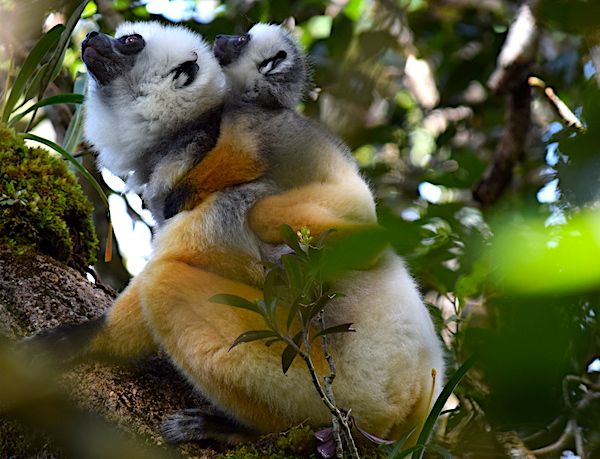
8. Flexibility is KEY When Travelling in Madagascar
Please remember to be flexible, patient, and respectful to your drivers and other Malagasy people you encounter.
Most Malagasy don’t like rushing. And in a country with limited resources, it’s easier to just go with the flow .
The Malagasy have a saying, “Mora Mora,” which translates to slow living and no worries.
They are going to be relaxed, and I promise that you will have much more fun if you relax too!

FOOD AND WATER IN MADAGASCAR
Filtered water.
- Lifestraw Go water filter bottles are legitimately a life saver. Especially if you are environmentally conscious or an avid hiker. If you don’t want to constantly be buying water bottles, you can fill your LifeStraw up with unfiltered tap water. Or if you’re on the trails … anywhere !This allows you to avoid starting hikes with 3+ litres of heavy water. I have even filled my Lifestraw in a warm and murky rice paddy during desperate times. I never felt any signs of sickness. Lifestraws are relatively prone to leaking and should be kept upright. But they are 100% worth the small investment!
- Avoid ice in your drinks unless you can guarantee that it was made with filtered water.
Food and Drink in Madagascar
- Sometimes there isn’t much variety in the cuisine. On the plus side, meals come at a fantastic value! The capital – Antananarivo – and touristy areas, especially along the coasts, will have more to offer. I’ve had some of the best meals of my life in Madagascar. Just be flexible during monotonous periods.
- Like with ice, avoid uncooked vegetables unless you’re certain they were washed with filtered water.
- I encourage everyone to try the “Ranonapango.” It’s essentially burnt rice tea. Although it’s not actual tea, it’s comforting and reminds me of popcorn… Rice is the cornerstone of the Malagasy diet. It’s the base of every meal, including breakfast.
- “Toka-gasy” is a Malagasy moonshine made with sugar cane. You could be offered a drink by a village King. It’s considered rude not to accept. However, do be aware that it is technically illegal. Though, not enforced because the alcohol content cannot be controlled. Some batches seem weak and others will knock you on your feet!
- It’s a good idea to bring protein bars . Especially if you have dietary restrictions (such as vegetarian or vegan) and/or plan on long hikes.
- Here’s some additional info on local food and what to expect.
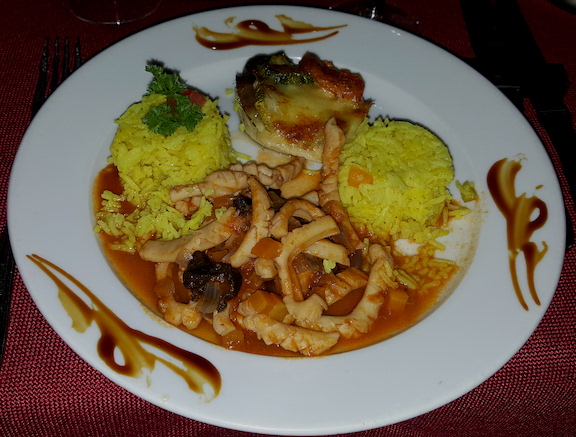
LANGUAGE IN MADAGASCAR
- Brush up on your French. Madagascar was once a French colony. French is still one of the official languages.
- Many signs and restaurant menus will be in French.
- Most prices will be told to you in French. It will be beneficial to at least learn your numbers .
- Try learning simple Malagasy phrases. The locals sincerely appreciate when you invest time and interest in their native language. For starters, “ Salama ” means hello. “ Veloma ” means goodbye!
- Malagasy people are more inclined to be open and friendly with people who aren’t from France. So don’t feel like you should become fluent in French!
- There are a few Malagasy/English handbooks available if you’re interested in languages. Malagasy is a tough language to learn until you’re immersed, especially the pronunciations! This short video of a few keywords in Malagasy with pronunciations will get you started.
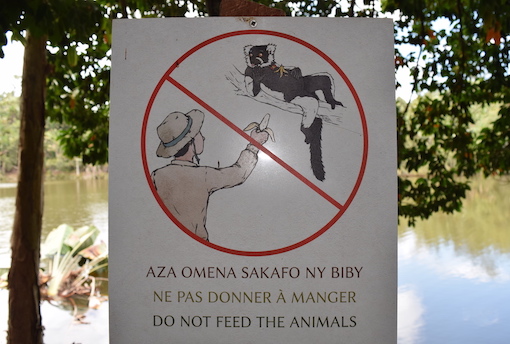
MONEY IN MADAGASCAR
Malagasy currency.
- The currency in Madagascar is called Ariary (MGA)
- Ar 4000 = 1 EUR
- Ar 4600 = 1 GBP
- Ar 2500 = 1 AUD
- Ar 250 = 1 ZAR
- The largest bill – Ar 20,000 – is equivalent to less than 6 USD. However, it’s considered substantial to most Malagasy. You’ll want a safe money bag or belt because you will be carrying many more bills than you are used to.
- The Ariary notes changed in 2017. Therefore, there are two designs for every bill, excluding the Ar 20,000. The Ar10,000 was the largest bill until 2017.
Access to Cash and Using Credit Cards in Madagascar
- To exchange your currency into Ariary, bring relatively large and new bills. They shouldn’t be older than 2010. It will be easiest for you to exchange your currency right at the airport. That way you’ll avoid the long lines and limited hours of banks. I find this to be the easiest way to access money.
- Credit and Debit cards. Some places in cities accept cards, but only VISA is reliable. Other networks like MasterCard and AmEx often won’t work. Honestly, it is best to carry cash !
- ATMs are only available in big cities. And there’s a limit to how much you can take out. Also, it’s not uncommon for ATMs to be out of order or empty.
Begging in Madagascar
- You will have people begging you for money. Especially children, mothers, the elderly, and the disabled. I would be lying if I said it wasn’t difficult to witness. But it’s unavoidable, especially in big cities.
- Everyone is entitled to their own opinions on how to handle these situations. But do acknowledge that your actions will impact more than just the beggar. Begging is not a sustainable way to make a living.
- If you decide to give, be tactful about it. Don’t flash large wads of cash. And understand that successful beggars often return with friends. To avoid being surrounded and causing a scene, wait until you are about to get back into your vehicle.
- I generally only give to those performing – sometimes people sing, dance, or play an instrument. And I never give to overly pushy people. I don’t want them thinking that’s the way they should approach all tourists.
- When giving money, I keep it discrete and politely urge them to use it for food.
Tipping in Madagascar
- Tips are generally well received and deeply appreciated. They’re sometimes it’s your biggest daily expenditures. Especially if you’re on a guided tour where most expenses are paid for ahead of time.
- When you can break large bills into smaller bills for tipping. Keep these tips in a separate pocket from the majority of your cash.
- To offer you a perspective, Malagasy people who are fortunate enough to be employed typically don’t make more than Ar 200,000 (~$56 USD) a month .
- If you want to keep your tips within the average range of other tourists, roughly follow the guide below. However, you are welcome to give more. Especially with guides and drivers. But only if they exceeded your expectations.
- Taxis and bars : Not expected or small bills.
- Porters : small bills, likely not over Ar 1000.
- Restaurants : 5% of the bill or less.
- Guides : 10% of the fee.
- Personal Drivers : Ar 5000 – Ar 20000 a day.

PACKING FOR MADAGASCAR
- Bring more warm clothes than you would think necessary. This includes thermals, hat, gloves, and fleece. Especially if you are travelling during Madagascar’s winter months (May – September).
- However, the climate throughout Madagascar changes rapidly . While the cool rainforest fog may send shivers down your spine in the morning, you can jump in the car and find yourself in a desert ecosystem by late afternoon. Therefore, you will want to pack a variety of clothing. Be sure to bring shorts, T-shirts, and durable sandals.
- If you plan on hiking , you should pack quick-drying field pants, sturdy hiking boots , wool socks, a baseball cap, and a rain jacket. While hiking in rainforests, I advise tucking your pants into your socks and your shirt into your pants to minimize leech bites. Leeches don’t transmit diseases, their bites don’t hurt, and they only remain attached for about half an hour. However, they do have an anticoagulant in their saliva. This causes you to continue bleeding even after they drop off. And these bites can itch worse than mosquito bites. Take precautions but don’t panic if you get a leech.
- I also recommend a substantial daypack with a supportive waist belt and chest strap. This could double as your carry-on luggage for the flight!
- Don’t forget bathing suits ! Beaches aren’t the only places to swim; some parks have natural swimming holes you can hike to.
Travel Documents For Madagascar
- Your passport cannot expire within 6 months of entry and must have at least 3 blank pages. They are strict about this!
- Carry your immunization records. They may not be requested if you haven’t been in countries with Yellow Fever.
- If you’re travelling with a large group, it’s beneficial to obtain your Madagascar VISA within your home country. Otherwise, it’s easy to purchase a tourist VISA upon arrival at the airport for 30, 60, or 90 days.
- I prefer to have paper photocopies of my passport and tourist Visa. The police will occasionally ask to see your passport, especially in cities and on the road, but I don’t like carrying it wherever I go.
Power in Madagascar
- Bring European plug adaptors if necessary: 220 Volt, 50Hz AC (Two circular metal pins).
- Charged power banks are invaluable, especially considering the amount of travel time. If you need your phone to stay alive for the entire day, I would bring a power bank or two.
General Equipment
- Pack binoculars for lemur and bird watching! If you’re concerned about them occupying souvenir space in your suitcase, donate them to a deserving park guide near the end of your journey. Malagasy guides are often in need of functioning binoculars.
- Bring a bright headlamp and/or flashlight for night hikes. There are nocturnal lemurs, chameleons, frogs, snakes, geckos and so many other creatures you don’t want to miss!
- Wristwatches are convenient for checking the time. I t might not always be a good time to pull out your phone.
- All sizes of Ziplock bags are precious. Smaller bags can organize your medications and chargers; medium bags can keep your electronics and books dry; large bags are perfect for wet or dirty laundry.
- I recommend silica gel packets and dry bags for your electronics and camera if you’re spending an extended time in humid, rainforest environments.
- Remember the items mentioned in previous sections : medications, hand sanitizer, sunscreen, LifeStraw water bottle , protein bars, bills to exchange, designated money bag, VISA credit/debit cards, etc.

THINGS TO BE MINDFUL OF IN MADAGASCAR…
Internet and phones.
- Most hotels have complimentary WiFi. However, even luxury hotels don’t always have internet or outlets in individual rooms/bungalows. Sometimes you have to sit in the reception area for internet access and charging. WiFi is available in some restaurants, but you will need to ask for the password.
- If you have an unlocked GSM cellphone, you may want to buy a local SIM card (Airtel, Orange, or Telma) and a 3G package. You can do this at the airport. If you don’t want to purchase a plan, you can buy phone credit at virtually any shop.
Cultural Awareness in Madagascar
- Avoid pointing with only your index finger extended. While it’s not considered offensive everywhere in Madagascar, it’s better to be safe than sorry. Pointing with your index finger is considered a “ fady ” or taboo in many regions of Madagascar. Especially when pointing directly at a tomb or grave. You can either gesture with your whole hand open, or bend your finger as you point.
- It is expected to haggle prices unless the price is already established, such as in tourist shops, restaurants, and hotels. It’s part of the culture.
- It’s respectful to dress fairly modestly . You’ll see everything in tourist areas. However, I personally avoid low cut tops, short skirts and shorts. And I only wear one-piece swimsuits.
- While difficult to ignore their puppy-dog stares, don’t feed street dogs . Malagasy people can view it as highly offensive that you took the time and money to feed a dog, but not their family.
- Most Malagasy actively avoid confrontation, especially with foreigners. Don’t take advantage of this.
Saying “Thank You” in Madagascar
- In Malagasy, “ Misaotra ” means thank you. Add “betsaka” if you want to say, “thank you very much.”
- If you anticipate any village visits, a gift that would be appreciated by everyone is a high-quality soccer ball . I always bring several deflated soccer balls and an air pump from the States.
- You’ll probably become close with your driver and guide. In addition to a tip, you may want to thank them with foreign gifts . A T-shirt representing your city or country, candy from abroad, or something else they wouldn’t find in Madagascar are the most cherished gifts.

PHOTOGRAPHY IN MADAGASCAR
Keep your camera close.
- If you have a DSLR camera, keep is safe, but don’t be afraid to bring it . There are countless sites and creatures to document that small cameras and phones just can’t capture.
- Keep all valuables close, especially in big cities like the capital of Antananarivo (Tana). I wouldn’t worry about being attacked. However, there are some skilled pick-pocketers. They can swipe your cash, phone, or other items without you even noticing.
- Just as you would back home, ask before taking someone’s picture. If you don’t speak French, saying “ Sary? ” (pronounced similarly to the English, “sorry”) – which means “Picture?” in Malagasy, should sufficiently get the point across.
- Adults will occasionally wave you off, but kids love to pose. You should show them their picture. But remember to wipe down your camera with a disinfectant afterward. The kids may excitedly grab your camera for a closer look with their cute, but dirty little hands.
Selfies in Madagascar
- NEVER pay to take pictures with wildlife kept at restaurants or hotels.
- Paying for these photos encourages the illegal and devastating pet trade. One of the reasons lemurs are endangered .
- Many of these animals, especially lemurs, don’t survive these conditions. If they don’t die from a poor diet, they may be killed when they display aggression as they become sexually mature. The “Magic of Madagascar Ecotour” will take you to one of the only rescue centers in Madagascar that confiscates pet lemurs and teaches them how to survive the wild.

SOUVENIR SHOPPING IN MADAGASCAR
Avoid purchasing….
- Carvings made from precious woods like Rosewood and Palisander
- Butterflies and other preserved insects
- Sea turtle shells
- Sapphires, other precious gemstones, and gold
28. Ethical Shopping
- Aim for sustainable gifts that don’t negatively impact wildlife or people while simultaneously expressing Malagasy culture.
- My main suggestions include… hand-dyed and spun silk scarves woven from sustainably farmed silk, items made out of recycled aluminium, and art constructed from repurposed zebu horns.

EXCLUSIVE TRAVEL EXPERIENCES IN MADAGASCAR
Places to visit in madagascar.
- RN7 is your best friend. This route starts at the capital and works its way south, then slowly west. It is accessible year-round and brings you through every incredible ecosystem Madagascar has to offer! That’s the route that we take on our Ecotour through Madagascar from July 1st – 12th, 2019!
- RN5 takes you west to see the “ Alley of Baobabs ” or possibly even the limestone forest of Tsingy ! This road is more difficult to navigate. It’s comical that it can even be considered a national route.
- The north is also beautiful, but similar to the west, the roads are very poor, especially as you work your way west.
- There are stunning places that are easiest to fly to, such as the rainforest peninsula of Masoala and the island of scuba-divers dreams – Nosy Be .
30. Wildlife You CANNOT Miss in Madagascar!
- “The Magic of Madagascar Ecotour” brings you to the largest species of lemur (indri) and the smallest lemur (mouse lemur), with many lemur species and sizes in between!

If you love Madagascar as much as we do, you’ll love our lemur t-shirts:

This meditating lemur t-shirt is the perfect gift for the animal lover in your life whether it be your wife, husband, sister, brother, best friend, son or daughter. It looks great with jeans and is perfect for a casual day out.

This t-shirt with words about lemurs is perfect for animal lovers – who want to show their love for ring-tailed lemurs and to raise awareness about this endangered species – see how many words related to lemurs you can find.
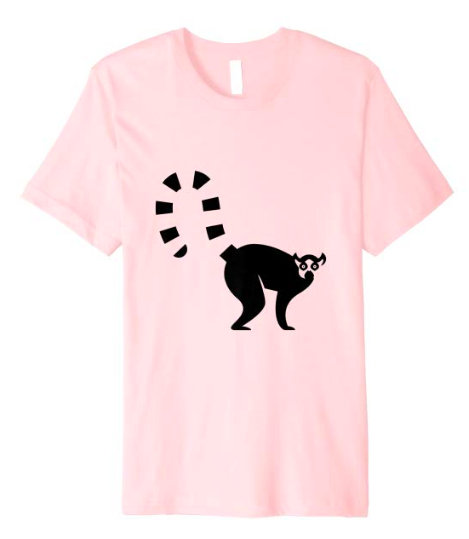
This ring-tailed lemur t-shirt will be a hit with animal lovers who want to show their love for these unique creatures while raising awareness about these critters from Madagascar who need our help.
ADDITIONAL MADAGASCAR INFORMATION
- Films and Books about Madagascar
- If you are keen to learn more about the creatures and culture before going or booking a ticket to Madagascar, I recommend either of the following films : Planet Earth II (on Netflix) and Island of Lemurs: Madagascar (IMAX) .
- Additionally, I recommend the following books : For the Love of Lemurs (Patricia Wright); Thank You, Madagascar (Alison Jolly); The Aye-Aye and I (Gerald Durrell); and Madagascar – The Eighth Continent (Peter Tyson).
- Field Guides for Madagascar
- There are good field guides available for most taxonomic groups in Madagascar. I have personally had the best luck with Lemurs of Madagascar: Third Edition and Birds of Madagascar and the Indian Ocean Islands . Note: if you can’t find that check out Lemurs of Madagascar: Tropical Field Guide Series .
- For travel guides, the Bradt Guides are probably the best guide I have come across. The author has been travelling to Madagascar for over 30 years! The Lonely Planet – Madagascar: 8 th Edition is also quite thorough.
- Online Info on Travel in Madagascar
- While this article provides a comprehensive list, you can’t fit everything into a single post! I recommend perusing additional online resources that can provide even more information about Madagascar. Be sure to check out 28 Interesting Facts About Madagascar !
- Continue researching and reading! The more you know, the better you can prepare for culture shock. And the more you will appreciate all the sights, sounds, smells, and tastes of Madagascar!

The long-ground roller is a bird species endemic to the spiny forests of Madagascar; Photo: Alicia Lamb.
Best of luck with your travels in Madagascar! Take care and enjoy, or as they say in Madagascar, “Mazotoa!”


Madagascar Travel Guide
Last Updated: September 2, 2023
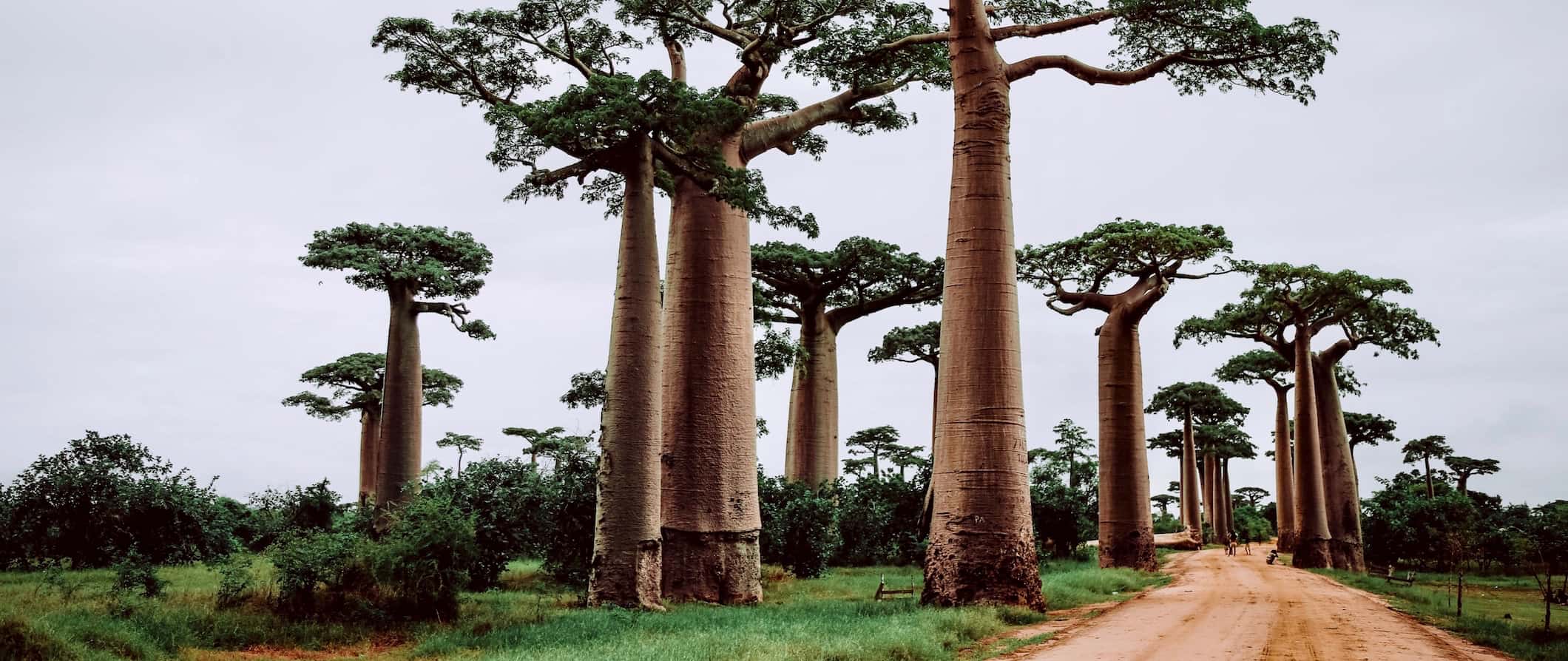
Madagascar, a country famed for its lemurs, massive baobab trees, birding, and jungles, offers visitors a rich playground to explore .
I was enthralled by the country’s beauty during my visit. There are sweeping canyons and gorges, grand waterfalls, and a diverse landscape that spans the entire island. One day you’re in a tropical jungle, the next you’re in an arid plain, and a few hours later you’re on a pristine beach. The scenery here is unlike any other destination I’ve been to. Plus, there really are a seemingly endless variety of cute lemurs!
Located 400 kilometers (250 miles) off the eastern coast of Africa, Madagascar is nearly the size of France and is the fourth largest in the world. It has a population of over 20 million but sees only 300,000 tourists a year.
While traveling Madagascar is challenging , it’s also incredibly rewarding. The travel trail here isn’t well-worn, which means visitors get a much more rugged, unique experience.
This Madagascar travel guide will help you plan the trip of a lifetime, save money, and ensure you make the most of your time in this off-the-beaten-path destination.
Table of Contents
- Things to See and Do
- Typical Costs
- Suggested Budget
- Money-Saving Tips
- Where to Stay
- How to Get Around
- How to Stay Safe
- Best Places to Book Your Trip
- Related Blogs on Madagascar
Top 5 Things to See and Do in Madagascar
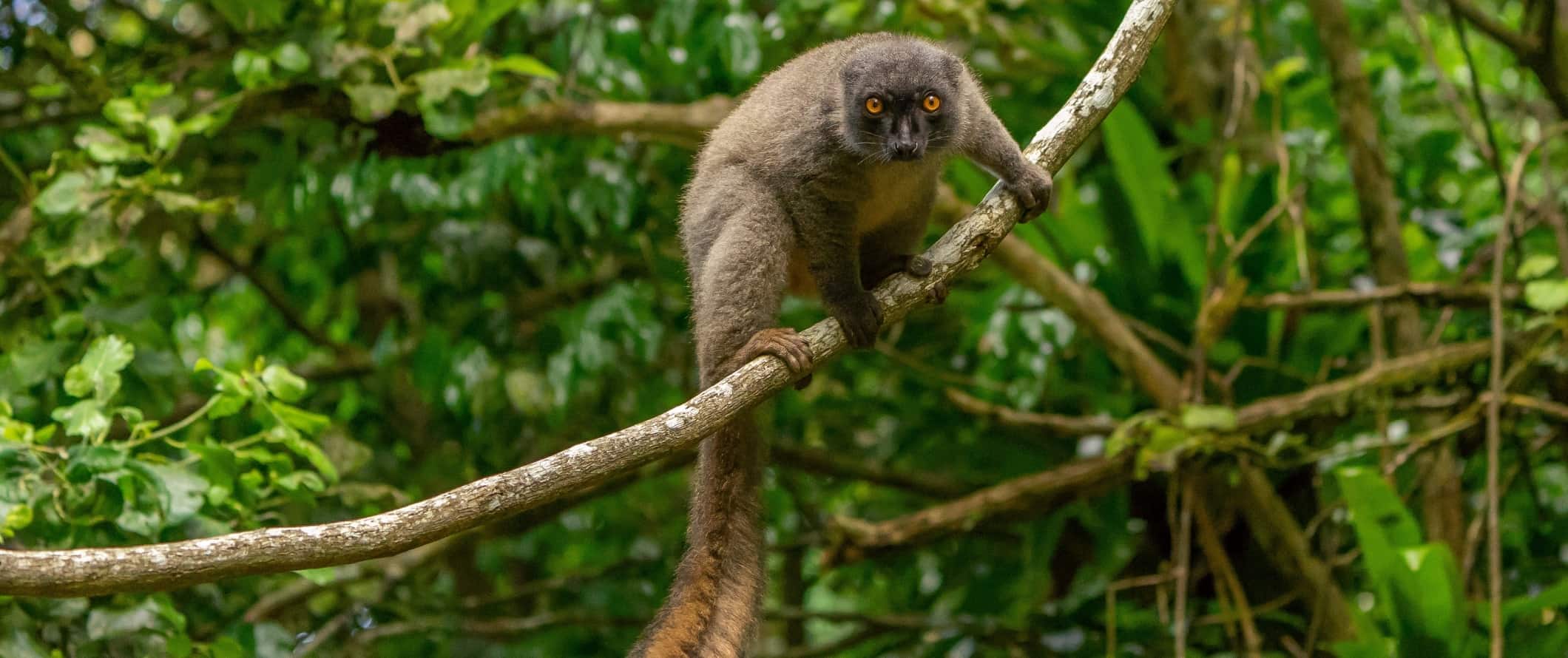
1. See the Avenue of the Baobab
Baobab trees are massive trees that can grow 30 meters (98 feet) tall, 11 meters (36 feet) wide, live up to 1,000 years, and are completely unique to Madagascar. While the trees can be found throughout the country, this road lined with them is one of the most iconic images of Madagascar .
2. Visit Tsingy
This park, near the western coast, is really two parks: Great Tsingy and Little Tsingy. It’s not an easy place to visit (it takes a full day via 4WD on very rough terrain to get here) but the views are worth it. The rock formations here are amazing and otherworldly. Admission is 55,000 MGA.
3. Explore Isalo National Park
Featuring multiple rugged hiking trails, cliffs, ravines, gorges, canyons, and plentiful fauna, this Westworld-like park blew me away. You are required to hire a guide before you explore though (they are found at the entrance). Admission is 65,000 MGA and guides cost between 80,000-100,000 MGA.
4. Relax at Nosy Be
Nosy Be is the place to go for Madagascar’s trademark beaches. Located 8 kilometers (5 miles) off the coast, this small island is home to white-sand beaches, expensive restaurants, and upscale resorts. Beach parties erupt each Sunday and there’s some amazing snorkeling, diving, fishing, and whale watching.
5. Explore Lemur Island
Lemur Island is a wildlife refuge that has four species of lemurs that have been rescued from being pets. They are also released back into their natural habitat when ready. If for some reason they can’t make it alone in the wild, they stay in the park. Admission is 12,000 MGA.
Other Things to See and Do in Madagascar
1. relax at île sainte marie.
While everyone goes to Nosy Be for the fancier resorts, if you want something a little more local, cheaper, and more relaxed, check out Île Sainte Marie. Located off the eastern coast, this former pirate capital (the 17th-century pirate Captain Kidd’s ship sank nearby) is a funky, relaxed island full of little coves, a pirate graveyard, and delicious seafood. The beaches aren’t as good as Nosy Be but there’s a beautiful white-sand beach in the south of the island that few people visit. This is also the best part of the country for whale watching. Round-trip flights here cost around 810,000 MGA. (Don’t take the boat, it’s slow and terribly inconvenient).
2. See Ranomafana National Park
This is one of the best spots in the country to see lemurs as it’s home to twelve different species of them. Besides lemurs, there are the famous giraffe beetles as well as lots of birds, chameleons, over 130 species of frogs, and other wildlife to see. Of the multiple trails available, I would do the morning hike, then the afternoon and night hikes at the secondary entrance (a guide is required for these). The majority of tours skip the latter hikes, so if you do them, you’ll get more of the park to yourself. Due to the park’s popularity, there’s a daily limit on the number of people who can visit so it’s best to go in the low season. Admission is 22,000 MGA per day and guides cost between 80,000-120,000 MGA.
3. Visit Toliara
This small west-coast town is famous for its expats, pizza (a seriously popular dish in the country), and for being a launching pad for diving excursions to the Great Reef offshore. There’s not much else to do except sit by the beach and relax. Driving here on the N7 (the only north-south highway) is also pretty amazing as you can take in Ranomafana National Park, Isalo National Park, and other stunning vistas along the way! A single dive costs 180,000 MGA.
4. Explore Antananarivo
The capital of Madagascar, known as Tana for short, it’s a gritty city with terrible traffic — but there’s a lot of history and culture here that make a short visit worthwhile. See the lemur park and the Rova (the old palace), get a sense of the international scene in the city and use it as your launching pad for stops further afield.
5. Try zebu
Zebu is a type of cow with a large hump on its back. It’s more of a work animal, like an ox, and you’ll see them all over the country (they are even used as dowries in weddings). It’s the only kind of beef here, and it is always on the menu (along with healthy portions of rice). The meat is really tough (thanks to all the work the animals do in the fields) and so it’s best in a stew. Be sure to try it while you’re here!
6. Drive the N5
Heading north along the east coast from Toamasina to Maroantsetra, this road — and I use the word “road” loosely — is a potholed-filled expedition through some of the rawest and most pristine areas of Madagascar. It’s also your best chance to see the famous aye-aye lemur (which kind of looks like a possum). The road weaves through dense jungle, across rivers, and through tiny towns in one of the most undeveloped parts of the country. Stretching 400 kilometers (250 miles), Route Nationale 5 (N5) is arguably the worst road (in terms of its condition) in the country. Many sections are often impassable so budget lots of time to drive it (they say it takes over 24 hours to drive the entire “road”).
7. Go whale watching
Between June and November more than 7,000 humpback whales migrate from Antarctica to Madagascar to breed, meaning the whale watching here is some of the best in the world. While we were taking the boat to Île Sainte Marie, we saw a couple breach the water and it was absolutely stunning to see. Plus, with so few tourists here, you aren’t stuck in a horde of boats vying for a photo. Adult humpback whales grow up to 16 meters (52 feet) and weigh over 30 metric tons (66,000 lbs.). You can also see the less-common Omura whale (dwarf fin whale) around Madagascar as well. Tours cost 135,000 MGA.
8. Enjoy Mantadia National Park
Located 160 kilometers (100 miles) east of the capital, Mantadia National Park is a protected area spanning 155 square kilometers (60 square miles). It’s home to 14 species of lemurs as well as over 115 types of birds and 84 kinds of amphibians — many of which are endangered. The landscape is a stunning mix of old-growth forest and rainforest, and you’ll see lemurs almost everywhere you go! Admission is 45,000 MGA and the required local guide is 60,000-80,000 MGA. There are also lodges in the park where you can stay overnight for 57,000 MGA per night.
9. Visit Lokobe National Park
Situated on the southeastern tip of Nosy Be, Lokobe National Park is one of the Sambirano region’s only remaining forests. Black lemurs, panther chameleons, and several endemic species of birds all make their home here. To get to Lokobe National Park, you’ll need to take one of the park’s pirogues (rowboat) from Nosy Be, which takes roughly 20-40 minutes. Admission is 55,000 MGA. Lokobe is one of the few national parks in Madagascar where a local guide is not needed.
10. Relax on Nosy Mangabe
Nestled deep between the coastal hills of Helodrano Antongila Bay as it carves its way inland on the north-eastern edge of Madagascar, this small island is famed for its booming populations of bug-eyed aye-aye lemurs. Huge fig trees wrangle around groves of palms, ruffed lemurs meet Mantella frogs in the undergrowth, and the green hills crash down into secluded bays of bright yellow sand. It’s a stunning landscape to say the least. Boats to the island and all the necessary permits are available in Maroantsetra. Admission is 45,000 MGA.
11. Visit Ambohimanga
The sacred royal hill of Ambohimanga, located 24 kilometers (15 miles) from the capital, was the one-time home of the country’s kings and the modern country’s first capital. Expanded throughout the 1700s, the walled complex contains a mound of palaces and burial grounds, crumbling fortifications, and regal tombs. King Andrianampoinimerina launched his now-famed campaigns to reunify the country from here, following more than seven decades of civil war in the 18th century. Admission is 10,000 MGA and you can also get a guide to show you around for free (just be sure to tip them).
12. Go to Antsirabe
Perched high up in the Central Highlands, Antsirabe is the third-largest city in Madagascar and the premier destination for the French who came here during the height of colonialism. They built elegant Parisian-style mansions, raised Gothic cathedrals, and laid wide boulevards with plane trees casting shade. The dusty city retains some of that charm and is one of the most aesthetically pleasing cities in the country. Antsirabe, a name that means “place of much salt” in Malagasy, is home to multiple natural thermal springs, making it a popular healing retreat. It’s also one of the best food spots in the country.
Madagascar Travel Costs
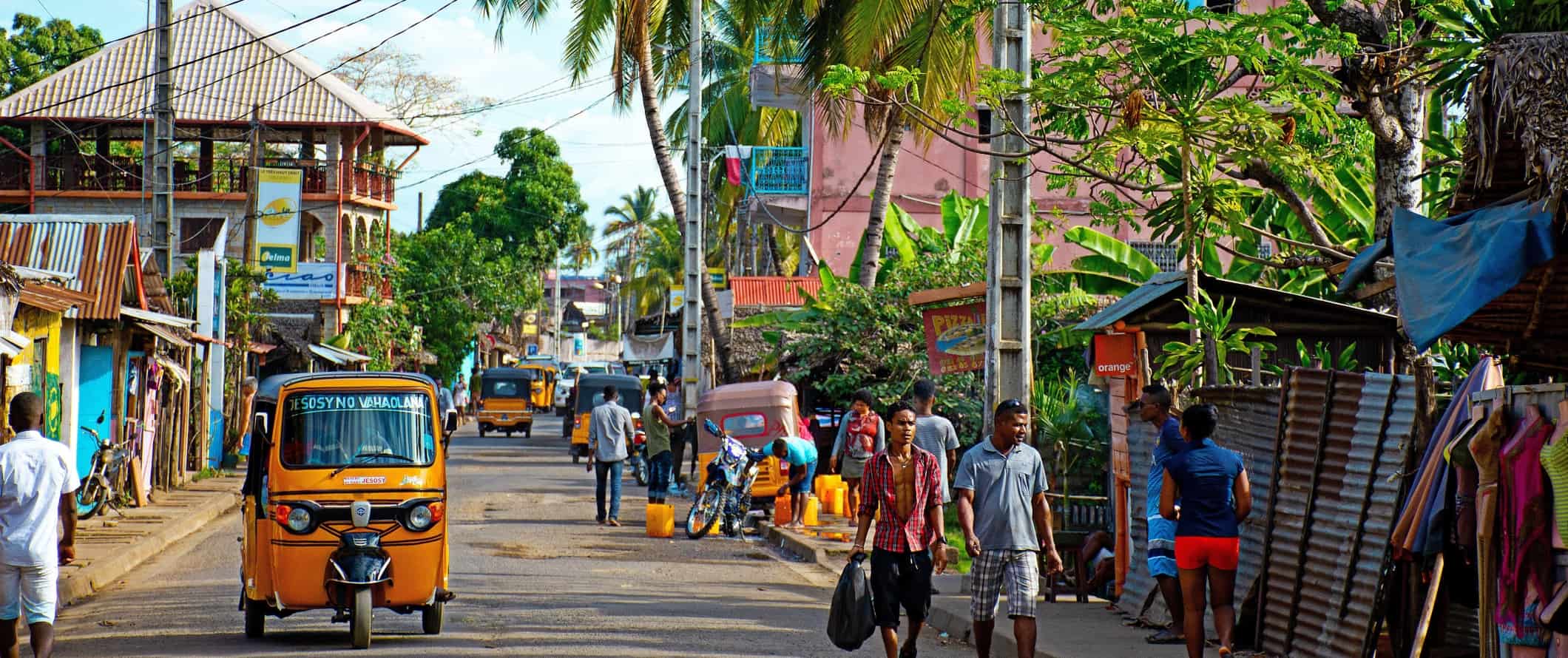
Accommodation – There are only a few hostels in the entire country and a bed in a dorm costs around 35,000 MGA, though sometimes you can find beds for as low as 20,000 MGA. For a private room, expect to pay at least 50,000 MGA. Free Wi-Fi and self-catering facilities are standard, though free breakfast is not.
Camping is available around some of the national parks. Wild camping is not recommended.
Budget hotels start at 60,000 MGA per night for a twin or double with a shared bathroom. For a room with a private bathroom in a hotel with more amenities (such as a pool), expect to spend at least 75,000 MGA per night. Free Wi-Fi is common but not included everywhere. A few hotels also offer free breakfast.
Airbnb is available around the country in larger towns and cities. You can find private rooms for 48,000 MGA per night and entire homes/apartments for around 100,000 MGA per night.
Food – Malagasy cuisine reflects the trading and colonial history of the island, with French, Southeast Asian, African, and Middle Eastern flavors all making their way into the country’s dishes. Tomato, ginger, turmeric, garlic, and onion are the commonly used spices in Malagasy cuisine.
Food in Madagascar is based around the country’s main staple: rice, usually accompanied by seafood or zebu. Rice is so central to food here that the Malagasy term for “to eat a meal” literally means “to eat rice.” Any side that comes with rice is called laoka . Some examples of sides include tomato salsa, stewed leafy vegetables, or beans.
Since zebu is quite tough, it’s often stewed (which is the best way to have it in my opinion), such as in romazava , which contains braised meat, tomato, garlic, ginger, and anamalao flowers, and is often considered the national dish.
Beef or prawn skewers are another common offering. For food on the go, be sure to try the nem (spring rolls) and mofo (fritters). They are cheap (usually around 50-200 MGA) and delicious!
Dining out is very inexpensive here. For a meal of traditional cuisine at a casual sit-down restaurant, expect to pay around 7,700 MGA.
Meals at restaurants that cater to tourists are the most expensive, offering Italian food or crepes for 25,000-28,000 MGA for a meal with a drink. For a pizza (which you can find almost everywhere), prices start at 10,000-15,000 MGA. A fast-food combo meal costs 20,000 MGA.
A beer costs 3,000 MGA while a latte or cappuccino costs 4,500 MGA. Bottled water is 1,500 MGA.
Cooking your own food won’t really save you any money since restaurants here are so cheap. However, if you do want to buy your own food, expect to pay around 77,000 for a week’s worth of groceries including staples like rice, pasta, seasonal produce, and some meat.
Backpacking Madagascar Suggested Budgets
On a backpacking budget of 110,000 MGA per day, you can stay in hostels, take shared or self-guided excursions, take buses between destinations, enjoy a couple of beers, eat street food for all your meals, and do mostly free activities like hiking and enjoying the beach.
On a mid-range budget of 240,000 MGA per day, you can stay in a private hostel room or Airbnb, take some guided tours, visit some islands and national parks (with the required guides), eat out at traditional Malagasy restaurants for all your meals, drink more, and take minibusses between cities.
On a “luxury” budget of 575,000 MGA per day, you can stay in a hotel, eat out at any restaurant, hire private drivers, do as many excursions as you want, and take taxis everywhere. This is just the ground floor for luxury though. The sky is the limit!
You can use the chart below to get some idea of how much you need to budget daily, depending on your travel style. Keep in mind these are daily averages – some days you’ll spend more, some days you’ll spend less (you might spend less every day). We just want to give you a general idea of how to make your budget. Prices are in MGA.
Madagascar Travel Guide: Money-Saving Tips
Looking to save money while you’re traveling Madagascar? Here are some of the best ways to save money during your trip:
- Travel during the off-season – Flights to Madagascar are cheapest during the low season (October-April). While it’s not the most ideal time to visit, your flight is your biggest expense (assuming you’re not booking a multi-day tour). Visiting during the shoulder season can go a long way to saving you money.
- Take local minibusses – When traveling between towns, take public minibusses. Fares are 20,000-50,000 MGA. Exercise patience, as you’ll rarely show up to your destination on time — but you’ll save money over hiring a driver and they are better than the regular bus.
- Skip the car rental – Car rentals cost the same as renting a car and driver. Skip going solo and hire a driver — they’ll not only be more familiar with the driving conditions but most drivers know a lot about the country and landscape too.
- Avoid the hotel restaurants – Food at hotels is cheap, however, it’s usually double the price of a restaurant elsewhere in the city.
- Get a local SIM card – Local SIM cards cost 4,000 MGA, and around 30,000 MGA per gig of data. A local SIM is much cheaper than your data plan from home.
- Bring a reusable water bottle – The tap water in Madagascar is not safe for drinking. Avoid single-use plastic by bringing a bottle and filter like LifeStraw . You’ll save money, stay safe, and help the environment!
Where to Stay in Madagascar
Hostels are few and far between in Madagascar. Here are some suggested budget-friendly options in the country:
- Madagascar Underground (Antananarivo)
- Le Karthala (Antananarivo)
- Coucher de Soleil (Nosy Be)
How to Get Around Madagascar
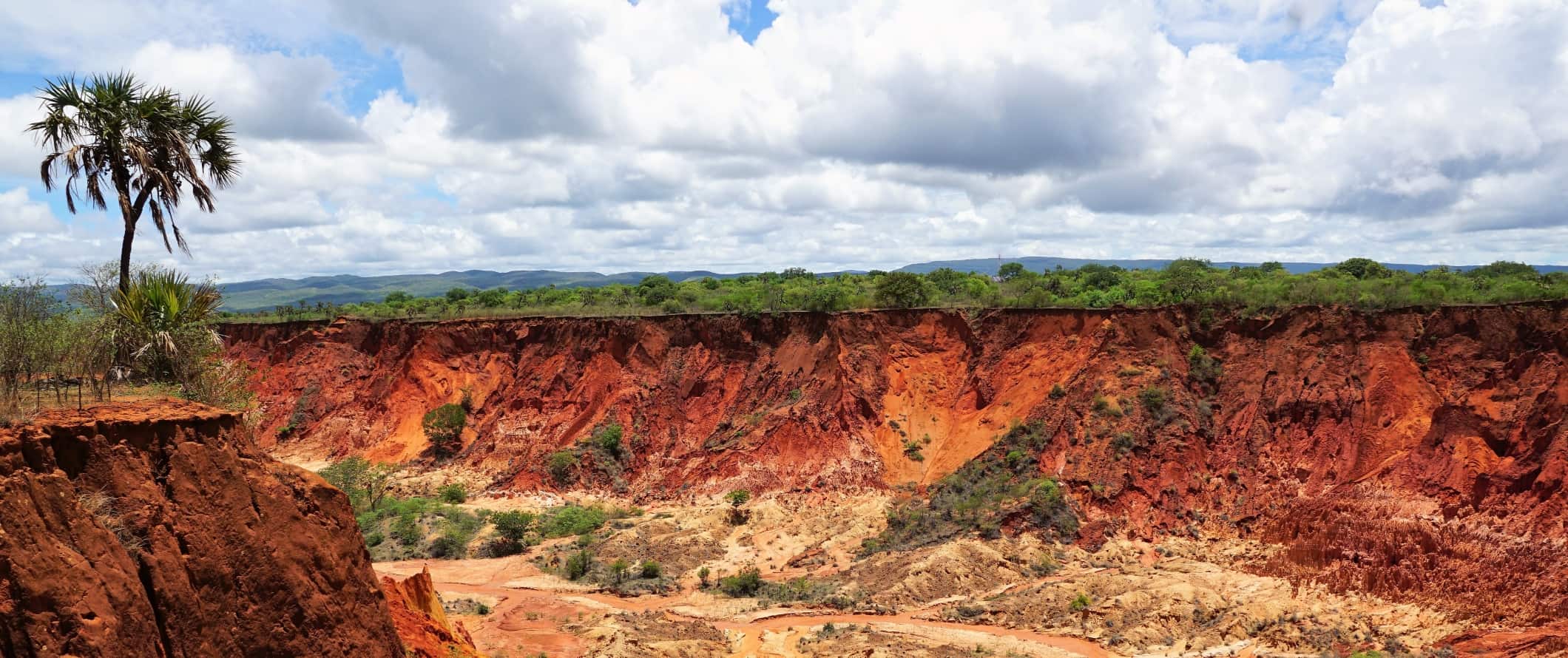
Tours – Multiday tours are the most common way to get around Madagascar. It’s a hard destination to navigate on your own, especially if you don’t want to hire a driver or speak a lot of French. Tours are the most popular choice for anyone looking to experience the country. I met travelers of all ages on my tour with Intrepid Travel .
Tours usually range from 11-24 days. A 14-day tour is around 9,000,000-17,000,000 MGA.
Bus – Buses here are slow, crowded, and unreliable. They don’t leave on a set schedule and often break down due to the terrible road conditions. However, they are the most affordable and best option to get around.
The 350-kilometer (217-mile) journey from Antananarivo to Toamasina takes around 7 hours and costs 30,000 while the 570-kilometer (355-mile) trip from Antananarivo to Mahajanga takes 12 hours and costs 40,000 MGA.
For shorter distances, most minibusses cost between 10,000-20,000 MGA.
Air – There’s only one domestic airline here (Air Madagascar and its subsidiary Tsaradia) and one-way tickets cost at least 350,000 MGA. If you’re on a budget, flying isn’t feasible.
Additionally, flights run on limited schedules, and flights are often canceled without notice, so make sure your plans are flexible if you’re flying.
Train – The train is only available between Fianarantsoa and Manakara. It’s a 300-kilometer (186 mile) trip and it usually takes around 10 hours (often much longer due to dilapidated railway lines and trains). Tickets are 70,000 MGA.
Car Rental – Car rentals can be found for around 280,000 MGA per day. However, it’s uncommon that rental agencies rent cars without a driver. Having a driver is recommended since the roads here are quite challenging and you’ll need a local to help in case anything goes wrong. I’d avoid driving here as the roads are hectic and in poor condition.
When to Go to Madagascar
April-December is the best time to visit Madagascar. You’ll avoid the rainy season as well as the cyclones that often occur. This is the most popular time to visit, however, Madagascar doesn’t see a huge influx of tourists so it doesn’t really get crowded here.
July-September is the best time to see the migrating humpback whales, while October and November are best for seeing baby lemurs. If you want to beat the “crowds” then visit in April, right at the end of the rainy season. It won’t be as hot, but the jungles will be lush and the beaches quiet.
Expect temperatures around 21-24°C (70-75°F) during the peak months of June-August.
How to Stay Safe in Madagascar
Madagascar is a relatively safe country, however, due to the extreme poverty here theft can occur. Don’t flash money or valuables and keep an eye on your belongings if taking a bus or if in large crowds. Keep your wallet and phone secure at all times, just to be safe.
While most cities and towns are safe, avoid walking around at night in Antananarivo.
Solo female travelers should generally feel safe here, though some precautions apply (avoid walking around alone at night, never accept drinks from strangers, dress appropriately so you blend in, etc.).
The roads here are terrible and accidents are common. Always wear your seatbelt (if you have one).
If exploring a city or rural area and you come across wild dogs, act with caution and don’t provoke them.
There are a lot of beggars here, especially kids, and you have to just keep saying no and walking away. Be polite but firm.
There aren’t many common scams here, but if you want to learn which to be on the lookout for, here are some common travel scams to avoid .
As always, keep your wits about you at nighttime, particularly in the capital. Ask your hotel to call you a taxi if you need one (always negotiate the price before getting in the car). Your hotel/hostel staff can write down directions and help you with the fare estimate so you don’t get ripped off.
If you do experience an emergency, dial 117 for assistance.
Always trust your gut instinct. Avoid isolated areas at night, and be aware of your surroundings at all times. Make copies of your personal documents, including your passport and ID, before you leave on your trip. Forward your itinerary along to loved ones so they’ll know where you are.
The most important piece of advice I can offer is to purchase good travel insurance. Travel insurance will protect you against illness, injury, theft, and cancellations. It’s comprehensive protection in case anything goes wrong. I never go on a trip without it as I’ve had to use it many times in the past.
Madagascar Travel Guide: The Best Booking Resources
These are my favorite companies to use when I travel. They consistently have the best deals, offer world-class customer service and great value, and overall, are better than their competitors. They are the companies I use the most and are always the starting point in my search for travel deals.
- Skyscanner – Skyscanner is my favorite flight search engine. They search small websites and budget airlines that larger search sites tend to miss. They are hands down the number one place to start.
- Hostelworld – This is the best hostel accommodation site out there with the largest inventory, best search interface, and widest availability.
- Booking.com – The best all around booking site that constantly provides the cheapest and lowest rates. They have the widest selection of budget accommodation. In all my tests, they’ve always had the cheapest rates out of all the booking websites.
- Get Your Guide – Get Your Guide is a huge online marketplace for tours and excursions. They have tons of tour options available in cities all around the world, including everything from cooking classes, walking tours, street art lessons, and more!
- SafetyWing – Safety Wing offers convenient and affordable plans tailored to digital nomads and long-term travelers. They have cheap monthly plans, great customer service, and an easy-to-use claims process that makes it perfect for those on the road.
- LifeStraw – My go-to company for reusable water bottles with built-in filters so you can ensure your drinking water is always clean and safe.
- Unbound Merino – They make lightweight, durable, easy-to-clean travel clothing.
- Top Travel Credit Cards – Points are the best way to cut down travel expenses. Here’s my favorite point earning credit cards so you can get free travel!
Madagascar Travel Guide: Related Articles
Want more info? Check out all the articles I’ve written on backpacking/traveling in Madagascar and continue planning your trip:
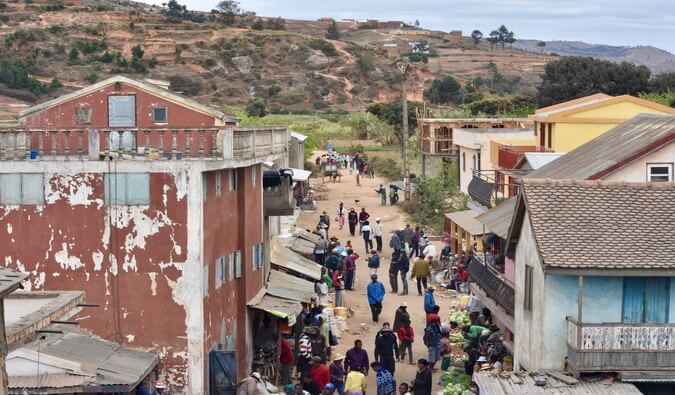
A Journey Through Madagascar: Notes on the Privilege of Travel
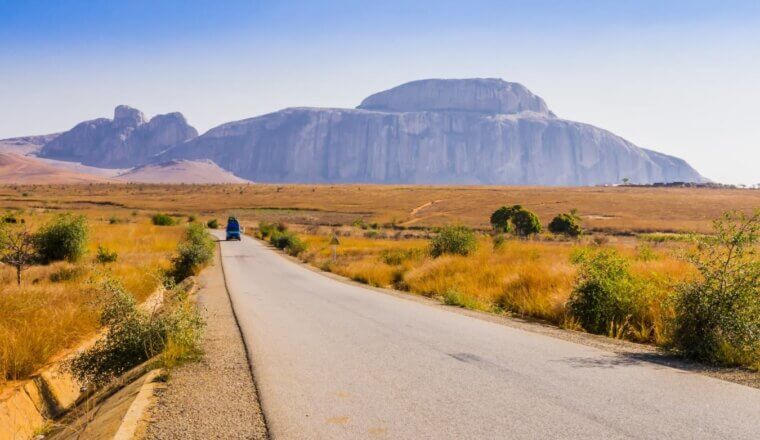
How to Travel Around Madagascar
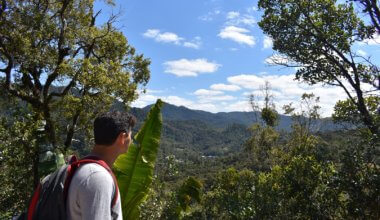
The Top Things to See and Do in Madagascar
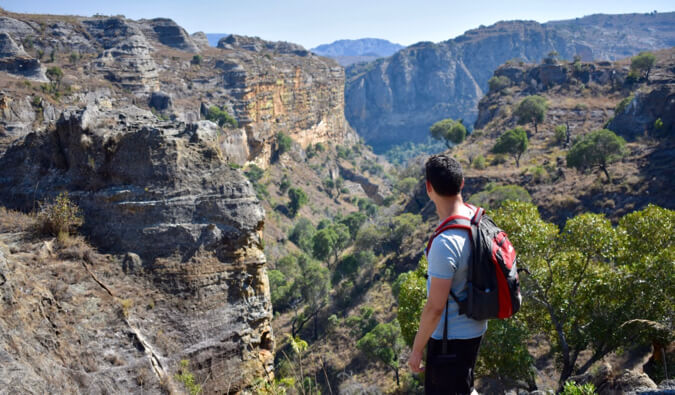
30 Epic Photos From My Trip to Madagascar
Get your free travel starter kit.
Enter your email and get planning cheatsheets including a step by step checklist, packing list, tips cheat sheet, and more so you can plan like a pro!

- Where To Stay
- Transportation
- Booking Resources
- Related Blogs

Madagascar travel guide | 3-week Itinerary
- August 2, 2023
Welcome to Madagascar travel guide, a 3-week itinerary to this magical island of natural wonders.
We recently visited the Red Island of Madagascar, which proved to be one of the most challenging, adventurous, and unique destinations we have ever travelled to. Planning our trip was tough due to the notoriously bad roads, and it often took us days to get from one place to another. We couldn’t risk driving at night, as it was considered highly dangerous. Therefore, we had to rely on daytime travel, which made our journey even more challenging.
It was really hard for us also to decide which places we will pass on or which we will invest in long hours and sometimes days of driving.
When in Madagascar, communication can be tricky for English speakers as the main languages spoken are Malagasy and French. Ordering something as simple as water can be difficult, and it was a big challenge to express ourselves effectively.
However, despite all these challenges, Madagascar has rewarded us with stunning views, spectacular untouched nature, amazing tropical beaches, rich wildlife, and experiences.
As one of the megadiverse countries in the world, we got to see unique animals in their natural habitats and flora that can be found only on the island.
Madagascar is also one of the poorest countries on the planet, which exposed us to the harsh poverty of the locals. But also allowed us to experience a place that hasn’t been touched by time or progress, where people still live with the old traditions and lifestyle.
Do you want to know more about what are the best places to see in Madagascar? What not to miss in Madagascar? How to plan your Madagascar trip? Here are our experiences and tips for Madagascar travelling.

Is Madagascar a safe country to travel? – Madagascar travel guide
As always, before we go travel, especially to third-world countries, we hear a lot of scary stories. Madagascar wasn’t exceptional. We heard about gangs with axes lurking on the roads, evil mosquitos with malaria, and poor street kids who will rob our phones in a flash of an eye.
Luckily for us, we didn’t experience any of the above. During our 3 weeks in Madagascar, we didn’t see any kind of violence or felt threatened. Having said that, we always consulted the locals, on which places are dangerous, where not to go, and what to expect. Most of the time we were advised not to walk or drive at night, and in the big cities to take extra watch for our valuables.
Visa + Vaccinations + Water – Madagascar travel guide
All foreign visitors to Madagascar require entry visas. For tourism purposes, you can get a tourist visa with a validity for staying in the country of 30 to 60 days maximum. The requirement for the visa is a valid passport with a validity of more than 6 months and a flight ticket showing the dates of entry and exit to Madagascar. You can apply for an entry visa online or at the Antananarivo airport after departure. The procedure is very simple and will cost you around 35 euros.
It is recommended to be vaccinated against yellow fever.
Water in Madagascar is considered not drinkable for foreigners, it is advised to strictly drink from sealed water bottles. We recommend also avoiding tap water when brushing the teeth and being careful in the shower, not to get water in the mouth. Also, be careful with washing the fruits.

When to travel to Madagascar? Madagascar travel guide
The best time to visit Madagascar is during the dry season, between April and November. During the dry season you can enjoy comfortable temperatures of an average of 20 to 25 Celsius, and most important avoid heavy rains. During this season the roads are more accessible, and daylight is longer.
Between December and March, which consider the wet season, heavy rains and typhoons are expected, roads will become inaccessible, and fewer opportunities to watch the wildlife.
We went at the early beginning of December and still enjoyed good weather and to our surprise barely saw rain. We also enjoyed cheaper prices as the main tourist season was over. For us it was perfect, but we wouldn’t recommend going any further than that.
Money in Madagascar – Madagascar travel guide
The official currency of Madagascar is ‘Ariary’. The money banknotes vary from 100 to 20,000 bills. There are almost no ATMs and exchange offices in Madagascar. We recommend withdrawing extra money during your stay in the capital of Antananarivo.
Exchange rates at the airport are very high, so we advise you to just cash out from ATMs (which can be found at the airport) as much as possible. Credit cards are rarely excepted, but can be used in some hotels and fancy restaurants.
Where to stay in Madagascar – Madagascar travel guide
We booked some of our accommodation in advance through Booking. Most of our rooms were basic and budget-friendly, but we also spoiled ourselves with fancy places, especially at the beach areas.

The biggest accommodation problem in Madagascar was that many places that we visited didn’t exist on Booking. We had to help ourselves with guidebooks and tips from the internet.
Transportation in Madagascar – Madagascar travel guide
As backpackers, we usually like to explore and experience the place we travel to by public transportation. To feel the vibe of the locals and mingle with them. Unfortunately in Madagascar (unless you are a masochist) this is out of the question. The roads in Madagascar are so bad, you can spend days getting to your destination even if it is considerably close.

The public transport is also quite a mess, you can’t rely on the timetables, and the drivers will fill people in the vans with no consideration for comfort or logic.
Like most of the travellers, we met or talk with, we rented a 4X4 jeep with a driver, which was a bit pricy (35 € a day). But worth every penny! Not only for the comfort and safety but also for having a local with us, who served also as a guide which enriched our experience.

Due to the massive size of Madagascar, there are also domestic flights. We used it once from West Madagascar (Toliara) back to Antananarivo to save some time and avoid driving back. Unfortunately, most of the flights are quite expensive and were off our budget.

Food in Madagascar – Madagascar travel guide
Most food of Madagascar revolves around rice, the main agricultural crop of the island. The Malagasies eat rice during all meals of the day in different variations and flavours. The main protein of their diet comes from local beans and the ‘Zebu’. A humped-look-alike cow that can be seen throughout all of Madagascar.

Along the coasts of the Island is common to find fresh fish and seafood. For more about food in Madagascar click here.
Madagascar travel guide 3-week Itinerary
Antananarivo (days 1-2) – madagascar travel guide.
The capital of Madagascar was our first introduction to the island. Even though we are experienced travellers, who’ve spent a long time in India and South America… Nothing has prepared us for this crazy hectic city.
As we started exploring the town and got to the centre, both of us got into a culture shock. Seeing the masses of people, the smells, and the noises.
Everywhere we looked something was happening. The eyes of the locals were scanning us with curiosity and poor beggar kids were following us asking for money in a language we did not understand. Not for the faint-hearted.
The main attraction of the city for us was the Analakely Market. A huge and chaotic shopping area, covered with vendors, stalls, and shops offering colourful food and products of Madagascar.

We were multiple times warned to keep our phones as many pickpockets are waiting for the grab. To escape a bit from the crazy crowd we hike to one of the hills, where we got a nice panoramic view of the city. The capital city was a good place to exchange our money and arrange through the agency a driver for our travel.
CLICK HERE and read more about Antananarivo.
Antsirabe (day 2-3)
After getting introduced to our driver, we started driving towards our second destination. As we exit Antananarivo, we started to witness the beauty of Madagascar’s nature and views. Passing endless green rice fields, dark red soil, and bright blue skies. The construction of the colours was amazing.
We got to Antsirabe around noon and went to explore the third-biggest city in Madagascar. The city is packed with rickshaws drivers, some on bicycles and some on foot and it’s one of the main attractions of the place. After being offered a ride by endless people, we took a short drive along the city’s main road and enjoyed the unique vibe.

Even though it’s a city, it was so different from what we are used to in Western countries. It was a first glimpse of an African town, with dirt roads, small houses, and basic stalls and shops along the roads. At night time, the city was in complete darkness and we spent the evening at our hotel.
Ambositra and Ranomafana National Park (day 3-5)
In the morning, we started our journey toward the tropical Ranomafana National Park. After a few hours of drive passing small villages and more of the majestic nature of Madagascar, we stopped in Ambositra where we had lunch and went for a short hike around the city. We enjoyed checking out the many stores that offer wood-carving arts which is what the place is known for.

After Ambositra we continued the journey to the Ranomafana Park, passing many villagers along the roads, offering bananas, lychee, and plums. The more we got closer we notice the change in nature, becoming more and more green, tropical, and a true jungle feeling.
As we went up also the climate changed and for the first time we experience rain in Madagascar. We arrived afternoon at the park and went to our quite fancy accommodation, just a 5-minute drive from the main entrance.
Our spacious wooden hut was equipped with a huge bed and all the comfort accessories a room can have. We also got an amazing view of the jungle just in front of us.

This accommodation was one of the highest we spent on a room. Later we discover a small village close by that offer much cheaper prices but wasn’t on booking so we couldn’t know.
The next day we got up early and went to explore Ranomafana National Park. The park is famous for its many species of lemurs, mushrooms, plants, and flora.
We took the long hike which was around 6 hours, passing through rain forest full of life. We were lucky enough to spot 8 different kinds of lemurs in their natural habitat.

In the evening we went for a night walk with a guide to spot the cute mouse lemurs and many chameleons.
To read more about Ranomafana National Park click HERE .
Ambalavao and Anja Park (days 5-7) – Madagascar travel guide
As we were heading more towards the South of Madagascar, we notice a change of nature. From the green rain forests to more dry scenery with impressive huge rocky mountains and massive scattered boulders. Ambalavao was our base point to visit the much anticipated Anja Park.
On the first day, we walked along the only main road of the city. We mingled with the curious locals who were not used to seeing foreigners and admiring the mountains that surround the town.

The next morning we drove to Anja Park which turned out to be one of the highlights of the trip. The park is evolved around massive mountains and cliffs and offers different hikes to choose from with various difficulties.
During our hike, we had the chance for a close-up meeting with the beautiful ring-tail lemur’s pack, huge sleepy chameleons, and exotic birds. We also walked through caves, and cliffs and got almost to the top of the mountain with an amazing view of the area.

A must-visit in Madagascar!
For more about Anja Park CLICK HERE .
Isalo National Park (days 7-9)
The more we were heading toward Isalo, the more we got the feeling of complete wilderness. There was nothing on the roads but endless dry white fields, the blue sky, and our car. Occasionally we saw lone shepherds hoarding their Zebus on this wasteland and sometimes even a burial ceremony of the local villagers.
We got also to see the infamous Sapphire mining areas with its pop-up towns, where u can see how rich foreigners take advantage of the poor locals.
When we arrived at the Isalo National Park area around noon, it was the only place we haven’t booked accommodation in advance. The reason was, we knew about wild camping options inside the park, but couldn’t find any detailed information online. Second of all, around the park several resorts are quite expensive (and not just by Madagascar standards).
After consulting with our driver, we decided to go to Ranohira, the closest town to Isalo. There we found a lovely friendly budget hotel with cute clay huts and a panoramic view of the park.

Visit the park
The next day we got up early and headed to the park entrance where we paid the fees and local guide for the hike. We walked for about 8 hours, admiring the sandstone landscape of cliffs, canyons, plateaus, and natural swimming pools. Our guide was extremely knowledgeable and showed us many unique plants, insects, and flora of the park. He also explained to us the history of Isalo and the local community.

Towards the end of our hike, we arrived at one of the camps (there are 2 different camping sites) of the park and felt a bit of regret not staying for the night. The camp is located in the middle of one of the canyons and it’s probably quite an experience to sleep there. Close to the camp we also saw for the first time the cute sifaka lemurs, and spend at least half an hour taking pictures and enjoying their company.

At the end of our Isalo experience, our guide took us through an amazing water stream path towards 2 beautiful pools where we could splash in the water and cool down from the heat.
Isalo National Park blew our minds, and if we had more time we sure stay more in this Malagasy gem. After the hike, we learned about the camps and prices and the hiking options the park has to offer. We highly recommend giving this place at least 3 days if not more.
CLICK HERE to read more about Isalo Madagascar.
Mangily (days 9-11)
After spending hasty days driving from one place to another, exploring the mainland of Madagascar, it was our time for some relaxing beach time. Our original plan was to stay at Toliara, the capital of the SouthWest coast region. But the city looked very crowded and hectic which wasn’t what we envision for our chill-out.
Our driver suggested we go to Mangily, which is about 25 km from Toliara. This cute fisherman village was exactly what we were looking for. Beautiful huts located on the shore, spacious hammocks, and green palm trees.

During our three-day stay in Mangily, we relaxed and indulged in fresh seafood and cold beer to rejuvenate our fatigued bodies from the tiring journey. One morning, we decided to go on a snorkelling excursion to explore the coral reefs nearby. However, the experience turned out to be a letdown as the reef was devoid of colours and life, likely because of overfishing and climate change. Moreover, the activity was excessively expensive.
In Mangily we also had to deal with quite annoying souvenir sellers who just didn’t leave us to be even after politely saying no. But having said that, we loved Mangily very much and highly recommend it if you travel to the area.
To read more about Mangily CLICK HERE .
Antananarivo (day 11-12)
To save time, we took a 45 min domestic flight from Toliara airport back to Antananarivo. There we spent 1 night before starting our journey towards ll Sainte-Marie island. On the next morning, we headed to the Taxi-Brousse station, where we took a shared van to Toamasina.

Toamasina (day 12-13)
We arrived in Toamasina after a brutal drive of more than 10 hours, passing quite bad bumpy roads and traffic jams. Not recommended will be an understatement.

Toamasina is a port city where most tourists come to take a boat or ferry to the Island of Nosy Boraha (ll Sainte-Marie). There is nothing special about the city besides its hectic vibe and crowded roads of rickshaws, cars, people, and farm animals running free.
Nosy Boraha – Ile Sainte Marie (days 13-18)
At 4 am, we reached the ferry agency in Toamasina and waited for three hours before being transported to the beach in vans. The journey was uncomfortable and lasted over two hours, made worse by the drivers cramming more people into the already-packed vans along the way.
The boat ride was also around 3 hours and when we arrived on the island we were completely exhausted. All these hard 2 days and journeys on the roads and the sea took the wind out of our sails. However the reward was well worth it, Ile Sainte Marie was revealed to be paradise on Earth.
Arriving at our Accommodation – Madagascar travel guide
From the port of the island, a driver of our resort came to pick us up and brought us to one of the most beautiful and welcoming accommodations we ever experienced. As we arrived, immediately all the stress and pain of the long travel dissolved.
We were greeted with fresh coconuts and delicious sandwiches and got escorted to our amazing spoiling bungalow one step away from the water.

During our stay on the island, we rented a motorbike (the main transport) and drove along the beautiful coastline of Nosy Boraha. Stopping from time to time for a quick deep in the sea. For watching waterfalls and seeing the local vibes of the islanders.
The island culture is quite different from Madagascar. We could see that people are more chill and happy with their life. One day we saved to go and check out Île aux Nattes, an even tinier island on the South of Nosy Boraha.
From the South point of the island, we took a small taxi boat towards the island, and what can we say it was just getting more and more pretty. The uniqueness of the island is in its natural state, u could almost feel Robinson Crusoe. Besides some very few hidden restaurants and resorts, there is nothing but palm trees, white sand, and the most crystal turquoise water.

Toamasina (day 18-19) – Madagascar travel guide
Boat number one.
Returning to Toamasina proved to be a great adventure for us. We woke up at 3 in the morning and headed to the port to catch our ferry back to the Madagascar mainland. Unfortunately, upon arrival, we found out that the boat was delayed due to bad weather and wouldn’t be departing until the following day. We felt frustrated and unsure of what to do.
At last, a stranger came up to us and proposed to sell us a boat from another port on the island at a reasonable cost. With limited options, we accepted the offer. However, the boat we ended up with was incredibly tiny and navigating through the rough waters and stormy conditions proved to be quite terrifying.
Dirt Bike Ride
After one hour we arrived at an abandoned beach, thinking a van will pick us up to Toamasina, but no van was in sight. People with motorcycles came to us and offer a ride to the next village. Without any other choice, we went on the bikes and drove with them at crazy speeds through dirt roads and rural villages.
2 More Boat Rides
Eventually, we got to a river and had to change to canoes, to take us further. We cruised on a beautiful backwater, surrounded by green nature listening to the local radio of the canoe captain.
A Horrible Endless Van Ride
Once we passed the backwaters, we made our way to Tanambao village to look for a taxi van that could take us to Toamasina. However, we were taken aback when the driver informed us that the journey would take more than 8 hours. The ride turned out to be even more unpleasant than the one from Antananarivo. We had never before been in such a cramped van with so many people that we couldn’t even move a finger.
We arrived in Toamasina at 9 pm. Destroyed, tired, dehydrated and hungry. It was probably the hardest journey we had in Madagascar and probably in all our travels.
In conclusion, we don’t recommend doing what we did. If Ile Sainte Marie is a must for you, please invest extra money and take the direct plane from Antananarivo.
Antananarivo (day 19-20)
Like the road toward Toamasina, also the drive back was long and exhausting. We arrive only at dark to the capital. The next day we just chilled in our hostel. We hung out with other travellers and ate some Italian food after so long time of basic rice.

We also wanted to do our shopping but unfortunately, it was Christmas Day and also Sunday so everything was closed. We had to go home empty-handed. In the evening we took a taxi to the airport and flew home. Exhausted, but happy.
Madagascar – travel for real adventurers
Madagascar is not a ‘walk in the park’. The roads can drive you to insanity. Without knowing at least a bit of French you will find yourself lost in this huge island.
But, Madagascar will give you thrilling adventures, majestic nature, out-of-this-world views, and unique animals you won’t see anywhere else. After traveling for so long and so many countries Madagascar will defiantly enter our top 5 destinations in the world.
You Might Also Like

Ranomafana national park Madagascar

Anja nature reserve Madagascar | Anja park

Guide to Isalo National park Madagascar
Leave a reply cancel reply.
- Search Please fill out this field.
- Newsletters
- Destinations
- Africa & Middle East
Madagascar Travel Guide: Essential Facts and Information
:max_bytes(150000):strip_icc():format(webp)/anoukmarrakech-56a373305f9b58b7d0d20299.jpg)
Madagascar is undoubtedly one of Africa's most fascinating countries, and certainly one of the continent's most unique. An island nation surrounded by the crystalline waters of the Indian Ocean , it's most famous for its incredible flora and fauna - from its charismatic lemurs to its towering baobab trees. Much of the country's wildlife is found nowhere else on Earth, and as such eco-tourism is one of Madagascar's key attractions. It is also home to unspoiled beaches, breathtaking dive sites and a colorful kaleidoscope of local Malagasy culture and cuisine.
The fourth-largest island on the planet, Madagascar is surrounded by the Indian Ocean and situated off the east coast of Africa. The country's closest mainland neighbor is Mozambique , while other islands in the nearby vicinity include Réunion, the Comoros and Mauritius.
Madagascar has a total area of 226,660 square miles/587,041 square kilometers. To put that into perspective, it's just less than twice the size of Arizona and similar in size to France.
Capital City:
Antananarivo
Population:
In July 2017, the CIA World Factbook estimated Madagascar's population at just over 25 million people.
French and Malagasy are the official languages of Madagascar, with various different dialects of Malagasy spoken throughout the island. French is generally spoken only by the educated classes.
The majority of Madagascans practice either Christian or indigenous beliefs, while a small minority of the population (around 7%) are Muslim.
The official currency of Madagascar is the Malagasy ariary. For up-to-date exchange rates, check out this helpful conversion site .
Madagascar's weather changes dramatically from region to region. The east coast is tropical, with hot temperatures and plenty of rain. The highlands of the central interior are cooler and less humid, while the south is the driest region of all. Generally speaking, Madagascar has a cool, dry season (May to October) and a hot, rainy season (November to April). The latter brings frequent cyclones.
When to Go:
The best time to visit Madagascar is during the May to October dry season, when temperatures are pleasant and precipitation is at its lowest. During the rainy season, cyclones can be a threat to visitor safety.
Key Attractions
Parc National de L'Isalo
Parc National de L'Isalo offers more than 315 square miles/800 square kilometers of breathtaking arid scenery, complete with fantastic sandstone rock formations, canyons and crystal clear pools perfect for swimming. It is one of Madagascar's most rewarding destinations for hiking.
The shores of this idyllic island are washed by clear turquoise waters and the air is fragrant with the scent of exotic blooms. It's home to many of Madagascar's most exclusive hotels, and is the destination of choice for wealthy beachgoers wishing to go snorkeling, sailing and scuba-diving. Nosy Be is also one of the best places in Africa to swim with whale sharks .
Avenue of the Baobabs
In Western Madagascar, the dirt road that connects Morondava and Belon'i Tsiribihina is home to a rare botanical spectacle, comprised of dozens of giant baobab trees. Many of these magnificent roadside trees are several hundred years old and over 100 feet/30 meters high. Because the avenue isn't yet part of a national park, you can view the trees for free.
Parc National d'Andasibe-Mantadia
Parc National d'Andasibe-Mantadia combines two separate parks, which together provide one of the best opportunities for a close encounter with Madagascar's largest lemur species, the indri. A total of 13 lemur species live in the park, as well as over 100 bird species, many of them endemic (including the Madagascar yellowbrow and the Madagascar serpent eagle).
Fondly referred to as "Tana", Madagascar's capital city is busy, chaotic and well worth a few days' visit at the beginning or end of your trip. It is a hub of Malagasy culture, known for its colonial architecture, vibrant art scene and surprising number of high-quality gourmet restaurants. Top attractions include the Rova palace complex and Analakely Market.
Tsingy de Bemaraha National Park
Located in the remote northwest, Tsingy de Bemaraha National Park is famous for its astonishing karstic plateaus. These petrified forests are crafted from razor-sharp spires of limestone and can be explored via a series of suspension bridges. Keep an eye out for 11 species of lemur or endemic mammals such as the fossa and falanouc.
Getting There
Madagascar's main airport is Ivato International Airport, located 10 miles/16 kilometers northwest of Antananarivo. The airport is home to Madagascar's national airline, Air Madagascar. From the United States, most flights connect via Johannesburg's O.R. Tambo Airport or Paris, France.
Non-nationals need a tourist visa to enter Madagascar; however, these can be purchased upon arrival at all international airports or harbors. It is also possible to organize a visa in advance at the Madagascan embassy or consulate in your home country. Check the government's visa information page for more information.
Medical Requirements
There are no compulsory vaccinations for travelers to Madagascar, however the Center for Disease Control and Prevention (CDC) recommends certain vaccines including hepatitis A, typhoid and polio. Depending on the region you plan to visit, anti-malaria medication may be necessary, while visitors travelling from a yellow fever country will need to carry proof of vaccination with them.
This article was updated by Jessica Macdonald on August 27th 2018.
Related Articles
More related articles.
Travel Guide Madagascar
Book your individual trip , stress-free with local travel experts
Select Month
- roughguides.com
- Travel guide
- Itineraries
- Local Experts
- Travel Advice
- Accommodation
Plan your tailor-made trip with a local expert
Book securely with money-back guarantee
Travel stress-free with local assistance and 24/7 support
Travel to Madagascar and discover an extraordinary storehouse of natural and cultural riches. Separated from Africa and Asia at the time of the dinosaurs, Madagascar's animal life has evolved in a startling myriad of forms, with endemic species found nowhere else on earth.
Madagascar travel facts
Where to go in madagascar, best time to go to madagascar.
- How to get to Madagascar
How to get around Madagascar
Best places to visit in madagascar, itineraries for madagascar, accommodation in madagascar, food and drink in madagascar, activities in madagascar, travel visa requirements for madagascar.
Humans first colonized this huge island less than 2000 years ago. Before then, Madagascar was a primal Eden, inhabited only by its bizarre and marvellous zoological cornucopia. As biologists continue to discover more about this remarkable place, calling Madagascar the eighth continent barely does it justice: second planet seems more appropriate. Read our Madagascar guide for everything you need to know before you go.
- Size: Madagascar is the fourth-largest island in the world. Measuring 587,040 square kilometres, it is more than double the size of Texas and nearly two-and-a-half times the size of the UK.
- Population: At the last official estimate in 2011, Madagascar’s population was just under 21 million, with a population density of 35 per square kilometre.
- Language: The country’s official languages are Malagasy and French, though English is increasingly important.
- Conservation: Madagascar has more than 40 national parks and reserves, managed by Madagascar National Parks.
- Religion: Traditional religious beliefs are still widely upheld in Madagascar, with some 4 million Roman Catholics, and 3.5 million members of the FJKM (the Church of Jesus Christ in Madagascar).
- Politics: Madagascar’s independence was returned to it, from France, on June 26, 1960. After years of chaotic dictatorship, the country now has a presidential, multi-party democracy.
- Biodiversity: Dozens of new species are discovered in Madagascar every year: more than 100 species of lemurs are now recognized and nearly 80 species of chameleons are endemic to the island.
- Leaping ahead: While Andasibe-Mantadia National Park’s most famous resident is the lemurs, the forests are also home to at least a hundred species of frogs – a figure that makes this the most frog-rich area on earth.
- Exports: Madagascar is associated with vanilla or rum and sugar cane, but the national crop with no equal is rice (vary in Malagasy), with the highest consumption per capita in the world – around 150kg per person (400g) or a pound of rice a day.
Madagascar has an entrancing tableaux of landscapes: dripping emerald rainforests, baobab trees like giant windmills towering over the savannah, and crazy outcroppings of limestone pinnacles, like a million wonky Gothic church spires.
The human landscapes are equally captivating. In the highlands, a thousand shades of green dazzle from the terraced rice fields, framed by dykes of red earth; water-filled nursery paddies reflect a cerulean blue sky and towering granite mountains, daubed by the pastel images of rows of multicoloured Hauts Plateaux houses.
On the east coast, you’ll find golden beaches framed by huge boulders and palm trees, lapped by the bath-warm Indian Ocean.
Out to the west and south, rolling plains of dry savannah and range lands intersperse with dense and alien spiny forest and carved by broad meandering rivers.
Here are some of the best places to visit in Madagascar :
Antananarivo
There’s no other capital in the world like Antananarivo (Tananarive to the French, “Tana” colloquially to everyone). A necklace of emerald rice paddies trails around lakes, canals and jagged hills, while a huddle of pastel-coloured houses crowds the still-partly cobbled streets of a crumpled central lattice. Even the sprawling shanties seem somehow prettier than the average urban slum: still largely built in the traditional manner, using fired-clay bricks, they blush radiantly pink in the afternoon sun, packed together between the glimmering rice fields.
Central Madagascar
The highlands of central Madagascar stretch from north of Antananarivo far towards the south of the island, undulating wildly across dramatic granite mountain ranges, lava ridges and outcrops. While there’s very little indigenous natural forest left, the human landscape is captivatingly beautiful. Deep valleys are filled by terraced rice fields and traditionally built towns, from the busy provincial agricultural hub of Antsirabe to the historical city of Fianarantsoa. Explore towns by horse-drawn buggy and immerse yourself in cultural traditions such as Malagasy crafts and famadihana (reburial) ceremonies. Beyond these urban centres lies the Réserve Villageoise Anja, where you can hike through the home territories of delightful ring-tailed lemurs, and rugged Parc National de Ranomafana, whose rainforest conceals the rare golden bamboo lemur.
Southern Madagascar
Southern Madagascar has some of the island’s most compelling attractions, from the gaunt sandstone plateau of Parc National d’Isalo to the towering mountain fastness of Parc National d’Andringitra. Elsewhere, you’ll discover spiny forests and glorious beaches, surfing and diving in the dry southwest, and the seductive rolling landscapes and scalloped bays wrapping around the port of Fort Dauphin in the far southeast. This is also Madagascar’s poorest region, however, and more prone to lawlessness – generally manifested in cattle rustling and highway banditry – than the rest of the country.
Western Madagascar
Way off the tourist trail, the vast region of western Madagascar has some unexpected surprises for those who slog to this barely visited backcountry. Western Madagascar may not be blessed with interesting towns or picturesque beaches, but its weird and wonderful natural spectacles make up for it. Hikers can strike out among the giants at Morondava’s Allée des Baobabs, where 300-plus baobabs loom above scattered bush and farmland, some reaching heights of 20 metres. After dark, seek out the exhilarating nocturnal animal life of Kirindy Private Reserve, whose rich wildlife includes fossas. But, without a doubt, the region’s crowning glory is Tsingy de Bemaraha, an extraordinary expanse of otherworldly limestone pinnacles, cut through by winding rivers.
Northeastern Madagascar
The rainforests of northeastern Madagascar are some of the most biodiverse areas on the planet. These hilly landscapes support a riotous display of jungle trees, lianas and other flora, which shelter extraordinarily rich wildlife, from minuscule chameleons to weighty indri lemurs. While the northeast’s natural vegetation is dense forest, the majority of trees had been cut by the time of independence, and today rice paddies, sugar-cane fields and plantations of vanilla and fruit trees account for much of the more level ground. The sizeable remaining pockets of forest are major strongholds of Madagascar’s natural heritage, now flagged by UNESCO as the “Rainforests of the Atsinanana” group of World Heritage Sites in Danger.
Off the sheltered west coast lies the fabled island of Nosy Be , with smaller and even more alluring islands dotted around the warm waters of the Mozambique Channel. Madagascar is swathed in largely deciduous dry forest, interspersed with pockets of highland and lowland rainforest – a biome known as the Sambirano ecosystem. The southeast corner of Nosy Be is still shrouded by a cloak of primary rainforest sheltering a number of rare and endemic species. The majority of those who visit Madagascar make a beeline here, lured by the balmy weather and warm seas, plus regular charter flights from France and Italy. Diving and snorkelling are popular pursuits, and kite- and windsurfing are big around Diego.
Far out on the west coast, the town of Morondava has some compelling assets nearby that draw visitors from across the globe. Foremost among these is the iconic Allée des Baobabs, or Avenue of the Baobabs, just a short drive out of town. As you arrive by plane, you’ll see the big baobabs as you descend, looking like stumpy wind turbines on the flat plain among the fields of sugar, cotton and rice. Further north is the lesser-known Kirindy Private Reserve, the only place you can travel in Madagascar with the near-guarantee of seeing a fossa – a ferocious puma-sized creature that looks like a cross between a cat and a mongoose.
Ambatolampy
Ambatolampy was a traditional Merina iron-smelting and forging town, and is still associated with metalwork and crafts – and nowadays souvenirs. Clusters of craft-sellers gather along the roadside, selling basketry and raffia-ware, brightly painted metal toys, even statues of the Virgin Mary. The stalls of musical instruments are particularly appealing, with nicely made local violins, banjos and other instruments on offer for around 20,000–40,000ar. South of Ambatolampy, you can trace the meandering Onive River by car, passing picturesque rural scenes of verdant emerald-tinted rice paddies; rust-red hillsides brimming with iron oxide; and rows of colourful houses.
Up to the west of Ambatolampy, you can see the looming mountains of the Massif de l’Ankaratra. This ancient volcanic range is occasionally dusted in snow and still bubbles with a little activity in Antsirabe’s hot springs. Antsirabe was founded in 1869 by Norwegian missionaries attracted by the curative powers of its mineral-rich thermal springs, and today is Madagascar’s third-largest town – and one of its most prosperous. Relatively clean and quiet, this is a town where many Tananariviens aspire to live, and where a few have holiday pads. The thermal baths are currently closed, but there’s no shortage of good hotels, restaurants and interesting crafts and jewellery shops.
Vehicles arriving from the north plunge down the road to Ambalavao, with the valley spread out beyond and the peaks of the Massif d’Iandrambaky poking up dramatically on the horizon. The town makes a good base from which to stock up if you’re heading into the Parc National d’Andringitra. Otherwise, you don’t need to stop here for long, but the town’s crafts workshops are accessible and worthwhile, and its famous old Betsileo houses, with their ornate verandas known as lavarangana, are very photogenic.
Andasibe-Mantadia National Park
The country’s most famous national park, Andasibe-Mantadia is located in the eastern rainforest and is home to twelve species of lemurs, including the largest – the wonderful, wailing indri. The otherworldly chorus of a family of indris, reverberating through the misty early-morning forest, is an unforgettable sound. Two hundred species of orchids bloom magnificently here, and the forests are also home to around 110 species of birds, over seventy species of reptiles and at least a hundred species of frogs – a figure that makes this the most frog-rich area on earth.
Isalo National Park
One of the best places to travel in southern Madagascar is Parc National d’Isalo. Midway between Fianarantsoa and Tuléar, this 810-square-kilometre sandstone plateau is a dramatic spectacle; its towering mesas and sculpted pillars creating a Monument Valley-style landscape. It is especially striking at its southern extremity, where the tarmac highway twists past the cliffs. The whole region, however, is a hiker’s mecca, cut by streams and springs into countless, forest-filled canyons, dotted with alluring natural swimming holes of crystal-clear water.
Tsingy de Bemaraha
The huge Parc National de Bemaraha and its far-flung northern extension, the Réserve Naturelle Intégrale du Tsingy de Bemaraha, are located on Madagascar’s largest plateau of tsingy (limestone) karst pinnacles. It’s a region that competes for remoteness with the most inaccessible parts of the island, incorporating a spectacularly strange landscape that is home to a host of endemic plants and animals. In recognition of its uniqueness, it was the first region in Madagascar to be designated a UNESCO World Heritage Site.
Sheltered on what were once mud and sand flats behind straggling stands of mangroves, the port of Tuléar (also known as Toliara or Toliary) is not the most prepossessing place to visit in Madagascar. This former slaving port has been sidelined by recent history – a fact reflected in the rebellious political stance often taken by the townspeople to matters being decided in Tana. As you wander around, look out for the town’s zebu carts, sometimes painted with bright, symbolic imagery derived from popular culture – typically music and film stars. The best attraction in Toliara is the Arboretum d’Antsokay, a 25-acre patch of spiny forest heavily planted with the flora from a lifetime’s botanical collecting by its Swiss founder, Hermann Petignat.
Discover more places in Madagascar

- Western Madagascar Travel Guide
- Antananarivo and around Travel Guide
The best time to visit Madagascar depends on where you are going and your interests. A hot, wet summer, from November to March, drenches the eastern slopes and highlands in heavy rain. Ferocious cyclones hit the east coast and ravage their way inland, making travel extremely difficult. However, down in the southwestern semi-desert, rain barely spatters the parched earth. From April to October, Madagascar experiences a dry, cool season, which is overall the best time to travel to Madagascar for bright, warm days and mild nights.
However, if you’re travelling to Madagascar for the wildlife, whale-watching is best from June to September when the creatures pass the east coast during their northerly migration. November is often recommended as the best time to visit Madagascar for wildlife, with the first rains bringing out an explosion of courting, mating and spawning among amphibians, reptiles, birds and the fabulous fossa. August to October are ideal months for diving and snorkeling.
Read our guide on the best time to travel to Madagascar .
The only practical way to travel to Madagascar is by plane. There are no direct flights from the UK or Ireland to Madagascar, but you can fly to Nairobi or Paris and connect onwards. Similarly, visitors from the east coast of North America will have to fly via London or Paris, but from the west coast it may be cheaper to fly via Bangkok. From South Africa, there are direct flights to Madagascar from Johannesburg. There are various options for travelling to Madagascar from Australia and New Zealand, notably flying via Johannesburg or Nairobi, or hubbing through Bangkok; however, the best-value route is via Mauritius and/or Réunion.
Read more in our Madagascar travel guide .
In this section, we’ll look at how to travel around Madagascar .
When considering how to travel around Madagascar, the most important thing is to give yourself time. It’s a big country, and most of the roads (such as they are) radiate out like spokes from the capital, so getting around needs planning, you’ll probably need to include some internal flights.
Most transport, however, is by road, and the road network is steadily improving. There are various options for getting around by car, the easiest (but most expensive) of which is hiring a vehicle and driver – many of whom double up as local Madagascar guides.
Budget travellers are better off using the slow and cheap shared taxis brousse (bush taxis, or taxi-be in Malagasy). These are privately or cooperatively owned minibuses running regular services to a vague timetable. Urban transport varies from town to town, but the main options are car taxis (t axis-ville ), Bajaj motorized trishaws (tuk-tuks), cyclo-pousses (cycle rickshaws) and pousses-pousses (handcarts).
Fianar’s hilltop old town is one of Madagascar’s most picturesque, with narrow lanes and views across the modern city and its rice fields.
The best place to visit in Madagascar for lemur-watching, including troops of habituated indris. Night walks and decent hotels make this as easy diversion, just a three-hour drive from Antananarivo.
This beautifully unspoiled island is quieter than Nosy Be, with the jewel of Île aux Nattes at its southern tip.
Heaven on a plate for beach-bum natural-history buffs, with leaf-tailed geckos camouflaged obligingly on every other branch and a glorious golden beach.
The real-life version of your local rainforest experience, complete with tumbling streams, buttress-rooted forest giants and thousands of life forms.
Madagascar’s most developed concentration of tourist resorts is low-key by global standards. Get away from the beach hotels and out to the offshore reefs or up to the hilly interior.
Two of the finest places to visit in Madagascar, these are worth the special journey for the towering “tree-elephants” and the exhilarating nocturnal animal life of Kirindy, including fossas.
Hard to get to, but worth every ounce of effort for the extraordinary expanses of weirdly eroded limestone pinnacles, cut through by winding rivers.
A park of big landscapes, lush canyons and wide horizons in the dry savannah. Plus, it’s easy to access and has good hotels and camping.
- Sainte Luce Reserve Moist coastal forest and creeks, home to lemurs and chameleons, with glorious beaches and onshore whale-watching, as well as some excellent Madagascar guides.
Our Madagasca r travel guide wouldn’t be complete without mentioning our Madagascar itineraries . These routes will take you to every corner of the island – and you’ll learn plenty about the country no matter where you want to go or what you want to do. You’re unlikely to complete the list, but it will give you a flavour of how to travel around Madagascar and a deeper insight into the country’s natural and historic wonders.
Travel ideas for Madagascar, created by local experts

Wild Madagascar
This trip is a tour of Wild Madagascar: discover dusty desert canyons, lush rainforests teeming with wildlife and trek through national parks. Explore the bustling capital Tana, then stop by the beach at Ifaty where you'll encounter forests of baobab trees and wandering tribesmen.
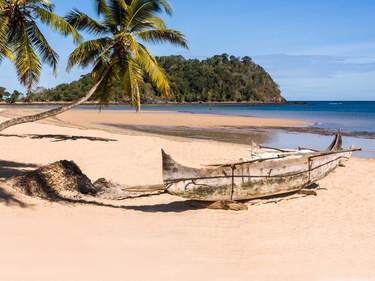
Dreaming of Madagascar
Tropical island beaches, lush rainforest, stunning wildlife, and the bright red clay houses of Antananarivo await you as you arrive on the beautiful island of Madagascar. Get your fill of culture in the capital Tana, snap beguiling wildlife, and revive and reboot on stunning white-sand beaches.

A Taste of Madagascar
An unforgettable journey through Madagascar's enchanting landscapes and cultural treasures. From the lush rainforests of Andasibe to the vibrant streets of Antananarivo, this adventure combines wildlife encounters with rich history, creating a diverse and immersive experience.
Want some help with the travel planning? Speak to us about our Tailor-made itineraries , where a local expert can plan your route and transport for you.
Itinerary 1: The North – parks and beaches
Almost all Madagascar trips start and end in Antananarivo. Allow 3–4 weeks to cover the north by a mixture of road and air travel, or skip half these stops and do it in 10–14 days.
- Antananarivo Give yourself a couple of days to visit the Rova palace compound and the old royal capital of Ambohimanga.
Get up early to walk into the indris’ territory and hear their extraordinary call. Then plan a night walk looking for chameleons and mouse lemurs.
Fly or ferry out to this old pirates’ hideaway, then rent a scooter and explore its jungle paths, clean beaches and limpid waters.
Organize a boat and local Madagascar guide to this fabled, forest-stacked island. You’ll discover aye-ayes, leaf-tailed geckos and a host of other species, some almost certainly still to be discovered.
The steep paths of the Masoala rainforest start at the doorstep of Nosy Mangabe, with every minute of every hike yielding wonderful sights and discoveries, from vangas to boas, from tenrecs to sportive lemurs.
Diego Suarez is the perfect rest stop between national parks, with its picturesque views and superb watersports.
Much easier to explore than the other rainforest parks, and still bursting with life, the Amber Mountain and the little town of Joffreville are worth a day and a night.
If you don’t have time to take a boat trip to the Tsingy de Bemaraha, then this fascinating eroded plateau is the next best thing. Lemurs and plenty of reptiles inhabit this rocky fortress.
Nosy Be’s beaches are beautiful, the resort trappings pretty tame and the interior well worth exploring. Don’t forget a trip to the wonderful Lokobé reserve.
Deciduous dry forest meets lakes and erosion gulleys in this enjoyable and accessible park between Majunga and Antananarivo.
Madagascar has no shortage of hotels, and on the whole they offer good value, certainly by international standards. There’s only a handful of top-end options scattered across the island, from urban city hotels to beach resort hotels through to national park lodges and tourist safari camps. The highest concentrations of luxury accommodation are in Tana and on Nosy Be and Île Sainte Marie. A good step down in standards will give you mid-range places, stretching from charming and extraordinarily good value to very ho-hum and rather overpriced. The budget accommodation in Madagascar is plentiful and typically great value; mostly consisting of a group of wooden, thatched bungalows; some en-suite, some with the option of air-conditioning.
Madagascar’s food culture is built around the country’s national staple, rice ( riz , or vary in Malagasy), and even enthusiastic rice lovers tend to tire of it eventually. Happily, there are plenty of interesting flavours to accompany it.
The main options for eating out in Madagascar are hotelys (local Malagasy restaurant with a simple menu of staple favourites); your hotel dining room; and foreign imports. These range from pizzerias and crêperies to Italian, French, Indian and Chinese specialist restaurants. Street food can be very good and very cheap, and may include rice and sauce, brochettes of beef, fish or prawns, roasted or baked plantains, bananas, cassava or sweet potato, stews and vegetable fritters.
Madagascar’s two great drink offerings are spiced and flavoured rum in an almost infinite variety of flavours, known as rhum arrangé, and THB beer pronounced “Tay-Ash-Bay” (short for Three Horses Beer).
Read our Madagascar guide to food and drink .
Though most travellers visit Madagascar for its wildlife – lemurs and chameleons in particular – the island has so much more to offer besides curious critters. If it were only for its landscapes, beaches and warm seas, the island would still be one of the world’s most alluring destinations, and there’s plenty here to please adrenalin junkies and outdoor enthusiasts. This part of our Madagascar guide will look at the best activities on offer.
Walking is the default way in which to explore the national parks dotted across the island. Multi-day park hikes, with a local Madagascar guide and porters, are not difficult to arrange, especially in the national parks of Andringitra, Marojejy and Masoala.
Rock climbing
With its many sheer granite and sandstone rock walls, Madagascar is full of excellent climbing opportunities. Standout areas include the Montagne des Français near Diego Suarez, and the Isalo and Andringitra national parks.
Mountain biking
Mountain biking is only allowed in some areas of the national parks but cycling can be a great way to get around remoter areas where the rewards combine a mixture of culture, nature and landscape, rather than providing a more purely wildlife experience. Many hotels also have a few mountain bikes to loan or rent for short trips, but for something longer, check out Rando Raid , based in Antsirabe who also offer horse riding, or VTT Madagascar who organize bike tours in remote parts of southeast Madagascar.
Snorkelling and diving
If you’re travelling to Madagascar for underwater adventures, the easiest diving and snorkelling is around Nosy Be. The best options are less from the main island itself, and more from some of its smaller neighbours – Nosy Tanikely, Nosy Mitsio and Nosy Radames are particularly good. The reefs of southwest Madagascar, between Andavadoaka and Anakao, are also spectacular, and the waters around Diego Suarez have numerous wrecks to explore.
Watersports
Most larger beach hotels around Madagascar can offer windsurfing, or organize it for you. Surfing tends to be a speciality of the south, notably the areas around Tuléar and Fort Dauphin. The other key spot for kitesurfing is the Mer d’Émeraude, near Diego Suarez. Kayaking and rafting can be pursued on larger rivers such as the Namorona, Tsiribihina and Manambolo.
Spectator sports
Several traditional sports are still popular with visitors to Madagascar. Moraingy, a bare-fisted combination of boxing and kick-fighting, comes from the Sakalava country of western Madagascar and can be seen on weekends in the dry season.
Travel advice for Madagascar
From travel safety to visa requirements, discover the best tips for traveling to Madagascar
- Eating and drinking in Madagascar
- Getting around Madagascar: Transportation Tips
- National Parks in Madagascar
- Travel Tips Madagascar for planning and on the go
For visitors to Madagascar, staying healthy should not be a big issue. You need to be aware of malaria but generally, so long as you take sensible precautions, you should have no problems beyond the occasional stomach upset.
Despite warnings from some official government travel advisories, most people visit Madagascar without incident. However, you should certainly heed warnings about night-time travel and avoid it if you can, particularly the lonely dirt roads in the south, which are prone to banditry. Also be aware of pickpocketing, muggings and hotel thefts (especially your hotel has no safe), avoiding late arrivals in towns or taking a taxi.
Lastly, if you’re travelling Madagascar during cyclone season (December to March) and a storm is forecast, cancel any boat trips, get yourself as far inland as possible and take shelter on the ground floor of a solid building.
A few items to avoid when shopping are timber products, which often have a dubious source, and anything with a wildlife origin, which is likely to get you in trouble when leaving Madagascar. Other items on the banned exports list are all items connected to the country’s many funerary customs, including grave posts.
Read more advice and tips to make your Madagascar trip stress-free and safe.
This section will look at travel requirements for Madagascar. Visas are required by all nationalities. Non-immigrant visas are currently granted free on arrival for most nationalities at Ivato airport for stays of up to thirty days, and it’s generally easier to get one there than in advance (which usually requires photos and possibly a processing fee). If you want to stay longer, the fees are €55 for up to 60 days or €77 for up to 90 days. Longer than that, you’ll need to leave the country in order to re-enter (Réunion is the cheapest place to fly to and an overseas French département so part of the EU and the Eurozone). The only health requirement is a yellow fever certificate if you’ve been visiting a country in the yellow fever transmission zone.
Top image © Ava Peattie/Shutterstock
The Rough Guides to Madagascar and related travel guides
In-depth, easy-to-use travel guides filled with expert advice.

Find even more inspiration here

Planning your own trip? Prepare for your trip
Use Rough Guides' trusted partners for great rates

written by Andy Turner
updated 26.04.2021
Ready to travel and discover Madagascar?
Get support from our local experts for stress-free planning & worry-free travels.
- Where to stay
- Travel advice
Madagascar: an island unlike any other
Apr 18, 2017 • 16 min read

Lying in the Indian Ocean off the southeast coast of Africa, the island of Madagascar has evolved in splendid isolation for more than 80 million years; the result is a unique and startling world full of upside-down trees, stone forests and, of course, lemurs.
Join us on a journey through a wildlife-rich destination that never fails to surprise.

Kirindy and the baobabs
Start your trip in the west with wildlife encounters and a walk among iconic trees
Jean Baptiste strolls cheerfully through the forest, arms swaying, flip-flops flapping. For the past hour, he has led the way through a tangle of paths that each looks identical to the last, pausing to point out brown creatures hidden in the brown undergrowth: a twig-like pencil snake here, a fist-sized land snail there.
It takes some time to locate the lemur he spotted with barely a glance, but after much gesticulating (‘To the left of the fork, down from the second branch, no, not that branch, down further’), there it is: a sportive lemur, its teddy-bear head and goggly brown eyes poking out of a tree hollow. The sighting opens the floodgates to an embarrassment of encounters in the forest of Kirindy.

A few steps on, a black-and-white Verreaux’s sifaka appears far above, swinging between the treetops with the elegance of a trapeze artist, the tiny head of her baby peeking out from the fur of her belly. In a clearing nearby, Jean-Baptiste’s guttural ‘whoop-whoop’ is catnip to a family of red-bellied lemurs, and they soon make their way down from the canopy to inspect their human visitors.
The residents of Kirindy have made their home in the remains of the last dry deciduous forest on Madagascar’s west coast. It supports eight species of lemur – and the one creature in the country whose belly starts to rumble when it spots one. The forest is one of the best places to see the lemurs’ only predator: the endangered fossa.

Three of the animals have spent the day in the camp at Kirindy’s ecological research centre. One by one, they slink out from beneath a cabin, stretching and yawning in the sunshine, before hunching down in the dirt. They look like some terrible genetic mix-up between a dog and a weasel, with grey-brown fur, yellow eyes and a tail as long as their bodies. Mamy Ramparany, who manages the centre, would rather they didn’t feel so at home here. ‘One of the major issues for them,’ he says, squatting to check for other fossa beneath the cabin, ‘is the destruction of their habitat through farming and logging. Maybe they come here because they don’t have enough food.’
Mamy watches as the creatures rise and stalk into the forest. ‘That is the challenge of conservation in Madagascar, to work out how people profit from the forest without destroying it,’ he says. ‘But it is an exciting challenge. As long as there are animals left, there is hope.’
The broad-trunked, spindly-topped trees that rise incongruously through the scrubby thicket of Kirindy give some clue to the nature of that challenge. These are baobabs – ‘mothers of the forest’ in Malagasy – and the region was once full of them. Lost to deforestation and agriculture over the centuries, they now commonly stand alone, trunks thick as houses, towering over scorched earth cleared by slash-and-burn.

Some 25 miles south of Kirindy, the Avenue des Baobabs is a proud reminder of what has been lost. At dawn, a thick mist has settled over the road, and the 20 or so baobabs lining it – some 600 years old – are reduced to murky silhouettes. Farmers emerge through the fog, carrying scythes and axes, and leading zebu cattle, who stop to scratch their flanks on the gnarly bark of the trees. Fires are lit outside mud houses along the road, blackened pots placed over them, ready for a day's cooking. As the sun rises, the mist seeps away. More traffic appears on the avenue: jeeps on their way to the main town of Morondava, motorbikes with mattresses balanced on the handlebars. By the roadside, revealed for the first time in the morning light, are 10 small enclosures. Inside are frail baobab saplings barely a centimetre thick and half a metre tall – dwarfed by the old trees around them, but a sign of a brighter future nonetheless.
The road to Tsingy
Travel is all part of the adventure in Madagascar, and never more so than on the colourful journey along the bumpy 8a road from Kirindy to the north
‘Apart from its unique biodiversity, Madagascar is also known for its bad roads.’ So says local tour guide Dennis Rakotoson, climbing into the jeep. He is not smiling.
With less than 20 per cent of its road network asphalted, getting from A to B in Madagascar is rarely straightforward. Google Maps will tell you that it’s a three-hour journey from Kirindy up the 8a road to Bekopaka, some 100 miles north. Google Maps is wrong – very, very wrong – but neither does it tell you that a day travelling the route is at least as exciting as a day in the forest with a family of lemurs.

For the most part, the 8a is more rutted mud track than road. It soon leaves behind the paddy fields surrounding the Avenue des Baobabs, their neat, green lines ploughed by zebu, trailed by squabbling ducks. The landscape becomes drier, the bushes lining the verge covered in sand thrown up by passing vehicles, as though someone has dumped a bucket of orange powder over them. Large patches of blackened earth still smoulder from recent forest clearings.
In the early morning, kids idle along the 8a on their way to school, kicking footballs in the dust. Women in bright skirts march between villages, bundles of maize or firewood balanced on their heads, and their faces covered in a paste made from tamarind bark, to keep off the sun. Families do their laundry in shallow streams, their clothes drying on the banks, or bump along on wooden carts, behind the camel-like humps and long horns of slow-plodding zebu.

‘The Malagasy are very attached to their zebu,’ says Dennis, leaning on the dashboard as the jeep negotiates one of many potholes the size of paddling pools. ‘They are used for transportation and in the fields, of course, but also in rituals, burial ceremonies and medicine. If you rub the oil from their humps into your skin, you will get very strong.’
At the midway point of the journey, the road stops, cut off by the great brown slug of the Tsiribihina River. Jeeps are manoeuvred gingerly down planks onto Heath Robinson-style ferries, seemingly made from random bits of metal roped together. Everyone on board, they chug past people in hand-carved wooden canoes on the hour-long journey to Belo sur Tsiribihina on the opposite bank. By the early afternoon, the town's market is in full swing, and traders sit beside piles of sweet potatoes, sugarcane, dried red chillies, fried shrimps and fatty zebu humps, waving large flies away from their goods with their hands.
‘The road gets a little worse from here,’ says Dennis, as the 8a heads out of town. It is partially collapsed in places, weaving and dipping a new course around fallen trees and waterlogged craters.

As the intense heat of the day starts to fade, activity is stepped up in the roadside villages. Men cut earth into bricks, or scythe reeds for building, while their wives rhythmically pound rice with poles in giant mortars, turkeys waiting expectantly beside them. Children race out to every passing vehicle and peer inside, practising their foreign-language skills with polite requests for pens or bonbons.
By the time the jeep pulls in to the last stop at Bekopaka, via a final river crossing and many stops to let a brightly coloured giant coua bird, herd of goats or nervous chameleon cross the road, the sun has started to set through the mangrove trees. The journey along the 8a has taken over 11 hours, but, perhaps, it wouldn’t be so bad to turn around and do it all again.
Tsingy de Bemaraha
Strap yourself in for a couple of days’ climbing and clambering in Madagascar’s most unusual national park
In Bekopaka, three small boys are attempting to knock mangoes out of a tree with a stick. Around them, jeeps park up beside zebu carts, their passengers leaping out to stretch their legs before heading off to a small office in the village. They are here to book tickets to Tsingy de Bemaraha National Park, the reason most people travel up the 8a road from Morondava.
The park is split into two sections, Petit and Grand, and the smaller bit lies just beyond the office. Guide Charles Andriasy leads the way in, squeezing through a narrow passage, before issuing a warning: ‘This area is very sacred. There are many tombs in here; you must be respectful to the dead.’ Indeed, the three mango-bothering boys would be discouraged from entering, from the local belief that children might be more likely to encounter a ghost in here.
Some 150 million years ago, the entire region was under the sea; when the water receded, it left behind an otherworldly landscape of limestone spikes and caves, the fossils of long-lost marine animals still visible on their surface. The passing centuries have added new decoration to the rocks: the vines of strangler figs wrap around them and reach into crevices; dark pools of water hide eels and crabs; and the giant cobwebs of golden silk orb-weaver spiders stretch between pinnacles.

A series of ropes, ladders and bridges take the visitor through, following a path that twists up, round and over the rocks – from deep hollows that have never seen the sun, to viewing platforms balanced precariously on limestone peaks. Madagascan hoopoes and fish eagles swoop over this spiny grey forest, and Von der Decken’s sifakas, black faces peeking out of white furry coats, bound in, rather more at home among the sharp rocks than their human cousins.
For all the scrambling required to get around Petit Tsingy, it is merely practice for the main event, some 10 miles away in the second part of the park. At Grand Tsingy, Charles adjusts his climbing harness and checks his carabiners before starting off down the trail. It starts, misleadingly, with an easy climb up through the forest, with the calls of far-off sifakas echoing through the trees, and black parrots sailing overhead.
The path comes to an abrupt halt at a cliff, whose summit cannot be seen from the ground. A series of nails is hammered into the rock face all the way up, thick wire strung between them. Charles clips his carabiners to the first wire and pulls himself on to a narrow ledge. It’s a long, slow 60 metres up, attaching and reattaching the carabiners, finding firm footing on slim stone steps hewn into the limestone, and edging across ladders that span fissures in the rock. ‘If you go slowly, slowly, you need not be afraid,’ calls Charles from ahead. ‘Slowly, slowly, and you can see the way in front of you.’ The scale of Grand Tsingy is revealed at the top, with views out over the pinnacles stretching far into the forest. It takes several hours to navigate through the rest of the park, slithering around the rocks, inching over comically creaking rope bridges, descending into vast caves and crawling through tunnels.
Emerging back into the forest with the sun at its highest and fiercest, all is quiet. In the fork of a tree, a lemur fidgets in its sleep, perhaps disturbed by a dream. A female sifaka, arms resting on her knees, long tail hanging through the branches, stares down. She watches for a while, then her orange eyes slowly close. ‘The forest has the right idea,’ says Charles, wiping his brow from the day’s exertion. ‘Siesta time.’
Andasibe-Mantadia National Park
Get up close and personal with a host of lemurs in the mist-clad rainforests of eastern Madagascar
It’s cold up on the central plateau of Madagascar. Patches of cloud float across hills swathed in eucalyptus, American sweetgum, azalea and magnolia. Hanging from their branches are bloated water droplets, ready to fall with a satisfying poink onto the damp floor. Tree frogs croak and chirp and peep their presence through the drizzle, keeping leaf-tailed geckos and long-limbed spiders company beneath the canopy.
Luc Rajeriosa pushes his way through the undergrowth, stepping through the vines of assorted plants and brushing aside the canoe-sized branches of giant tree ferns. He pauses, pushes his straw hat to the back of his head, and stares into the treetops.
‘They are very far away,’ he whispers, frowning. ‘But still we must be very quiet.’ He plunges into a thicket of bamboo. With every step, his feet sink into the sticky mush of rotting foliage. At the top of a steep hill, he stops again. Within minutes, a high-pitched wail rises up, falls and rises again. More wails join it, as though an orchestra of musicians with broken trumpets has set up within the forest.

‘Now you hear the song of the indri,’ says Luc, and looks once more into the treetops. Three silhouetted balls are coiled in the upper branches. Limbs appear from furry bodies, and the indri take shape: black feet and hands, white legs and arms, round ears framing a black face, and a long black tail. The three creatures – a male, female and their baby – start grooming in the fine rain, picking at each others’ coats with bony fingers. The male launches itself into a neighbouring tree, and his family soon join him. They swing off through the branches, and disappear.
‘The local people here will not harm the indri,’ says Luc, moving off in slow pursuit. ‘It is taboo. We call them babakoto – father of man. The belief is that one day, long ago, the indri saved a small boy lost in the forest. For that, we will always care for them.’
The indri is the largest primate in Madagascar (the giant lemur, the size of a silverback gorilla, has been extinct for some 600 years). Up to 70 family groups live in Andasibe-Mantadia National Park, and the rainforest regularly sings with their territorial calls, the sound travelling for more than a mile. It is somewhat trickier to see them, but Andasibe has other distractions should a sighting prove elusive.

There are fuzzy-faced, ginger-limbed diademed sifakas, which can only be found in this part of the country; the alien forms of giraffe weevils, heads carried on spindly necks four times the length of their red bodies; fluffy bamboo lemurs stripping leaves off their namesake plants; and Malagasy tree boas wrapped around the trunks of palisander trees, blue tongues flicking beneath black eyes.
Luc is not a man to be swayed from his almost reverential search for the babakoto though, despite several hours scrambling through the forest. ‘I am like the indri,’ he says, emerging briefly into sunlight at the banks of a small lake. 'I need to be in the forest every day.’ He turns back into the undergrowth, and is soon lost from sight.
Pangalanes Canal
Time to wind down with a lazy meander along leafy canals and beach-lined lakes, looking out for the elusive aye-aye
The half-moon casts a silver light through the forest. Fireflies blink amongst the trees, their branches casting black shadows that warp and wave in the wind. There is no sound but for the faint shushing of the Indian Ocean hitting the shore nearly a mile away. There is a sudden rustle, and a dark shape appears on a nearby tree. The torch beam swings up and reveals a tree rat. It looks back in surprise, then scuttles off.

Tree rats are not why people come here. There is a long wait in the darkness for the main attraction. When it comes, it comes silently, a monster creeping out from the shadows in a nightmare. One second it is not there, the next second it is: a strange mess of red, crossed eyes; patchy fur; enormous, scruffy black ears; crooked teeth; and rasping breath. Its long fingers scrabble into a coconut, scraping out flesh and noisily poking it into its mouth.
The unfortunate-looking aye-aye was once so rare it was thought to be extinct. The species is still on the endangered list, and is protected here, on a small island reserve in eastern Madagascar. ‘People used to kill the aye-aye,’ says skipper Faro Razafimanantena, pushing off from the island in his long boat. ‘They believed if you saw one in the wild, it was a sign of danger. People thought they would not live long afterwards.’

The wild appearance of the aye-aye does not in any way match the decidedly un-creepy surroundings of its home in the Pangalanes system, a series of natural and man-made waterways that stretches for 400 miles along the coast. Built in the 19th century, the canals still hum with activity. At dawn, wide-bottomed cargo boats travel up to the main town of Toamasina laden with charcoal, wood and the leaves of the fan-shaped ravenala tree. Fishermen paddle out to their traps in wooden pirogues, pulling up nets to check for tilapia fish. A flash of orange and blue reveals competition for one catch in the form of a Madagascar kingfisher.
‘To get anywhere, to do anything, you go by boat,’ says Faro, his hand on the outdoor motor as his craft skims along the smooth waters of a narrow channel, the vegetation on its banks perfectly mirrored below. ‘All business here is done on water.’ He shouts hello to women sitting in the shallows, scrubbing tin pans while their kids splash about nearby. Smoke drifts through the trees from the villages behind them, where freshwater shrimps are roasted over the fire.

‘I like exploring,’ continues Faro, as he steers the boat down another passage, its banks bursting with prehistoric-looking screwpine trees. ‘Nothing is better than the freedom of being outdoors.’ The canals give way to wide rivers, the water turning choppy, and eventually to broad lakes, their banks lined with sandy beaches. Lemurs sometimes come to the edge to drink, but there’s no sign of them today; only a heron that launches off from the stump of a eucalyptus and up over the trees. The skies are preparing for a showstopper of a sunset, throwing pinks, mauves and golds onto the waters of the lake.
If, as local superstition supposes, a glimpse of an aye-aye means death is soon to come, it feels very far off tonight.
This article appeared in the April 2017 edition of Lonely Planet Traveller magazine . Amanda Canning travelled to Madagascar with support from Natural World Safaris ( naturalworldsafaris.com ). Lonely Planet contributors do not accept freebies in exchange for positive coverage.
http://shop.lonelyplanet.com/madagascar/madagascar-travel-guide-8/
Explore related stories

Feb 22, 2021 • 5 min read
First time traveling to La Réunion? Here are some of the best things to do. You are in for a colorful adventure!

Oct 30, 2020 • 1 min read
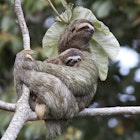
Apr 9, 2020 • 2 min read

Sep 27, 2019 • 6 min read

Jun 13, 2019 • 5 min read

Aug 21, 2018 • 6 min read

Oct 18, 2013 • 6 min read

Aug 17, 2010 • 3 min read

May 21, 2022 • 6 min read

Apr 28, 2022 • 6 min read

Madagascar Travel Guide (Everything You Need To Know Before You Visit)
By Author Christian L.
Posted on Published: May 21, 2020 - Last updated: June 28, 2021
Categories Africa , Destinations , Madagascar
Madagascar is the perfect destination for the adventurous traveler and those who want to get away from mass tourism – but traveling around the 4th biggest island in the world will require a lot of time, and will push your patience to breaking point. That being said, this Madagascar travel guide will make the journey a whole lot easier.
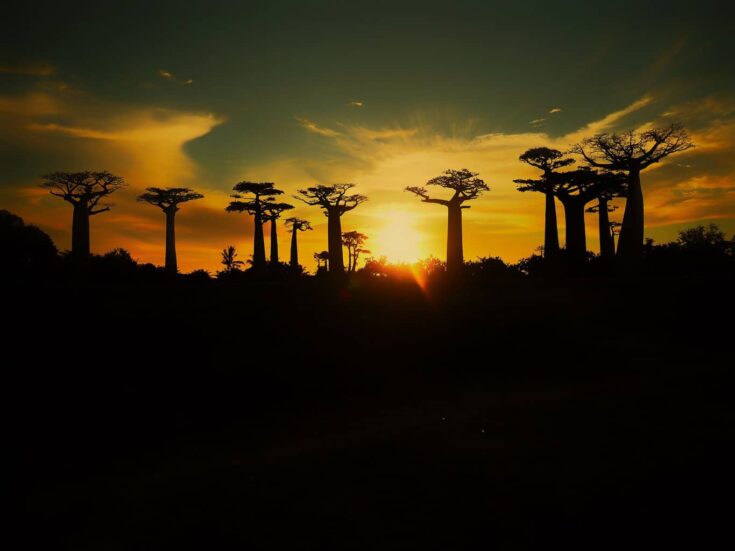
But if you’ve got time and patience, you will be rewarded with one of the most biodiverse destinations in the world.
Madagascar is home to thousands of species of flora and fauna of which almost 90% cannot be found anywhere else in the world, including the famous lemurs which are only found in Madagascar.
That’s actually a lie; there is only one species of wild lemurs on Comoros.
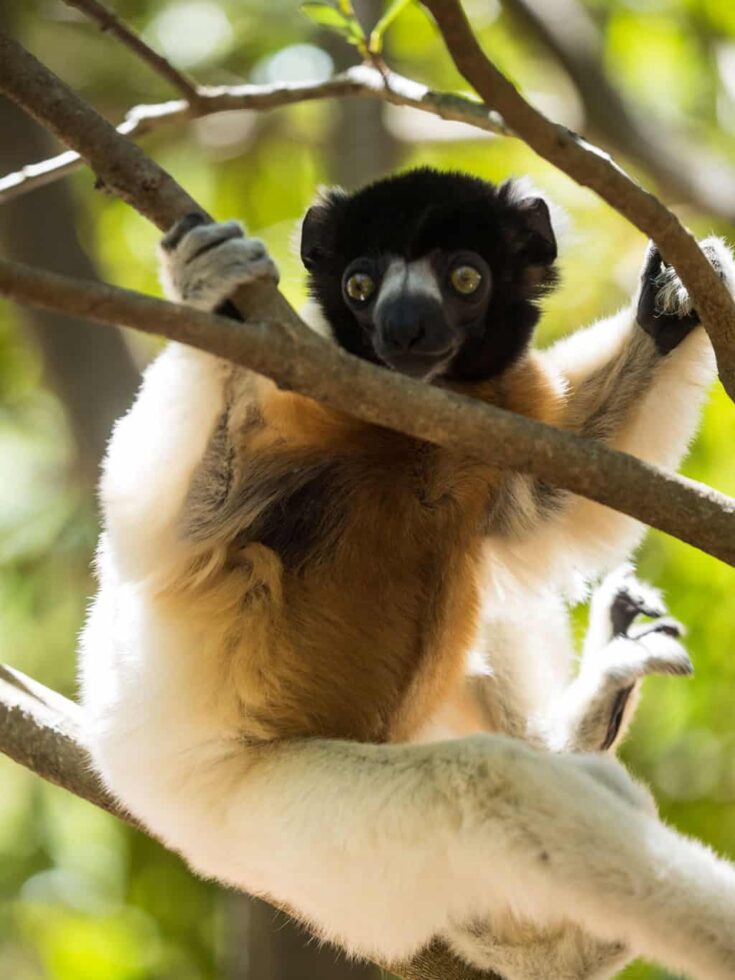
Madagascar is also home to some of the best and most underrated beaches in the world together with some breathtaking nature and scenery, making it a perfect travel destination. But if you’re still on the fence, here are ten bullet-proof reasons you should visit Madagascar .
Need to know how to travel to Madagascar? It can be tricky going it alone if you’ve never ventured onto a remote island before. Keep reading to find out exactly how to travel to Madagascar.
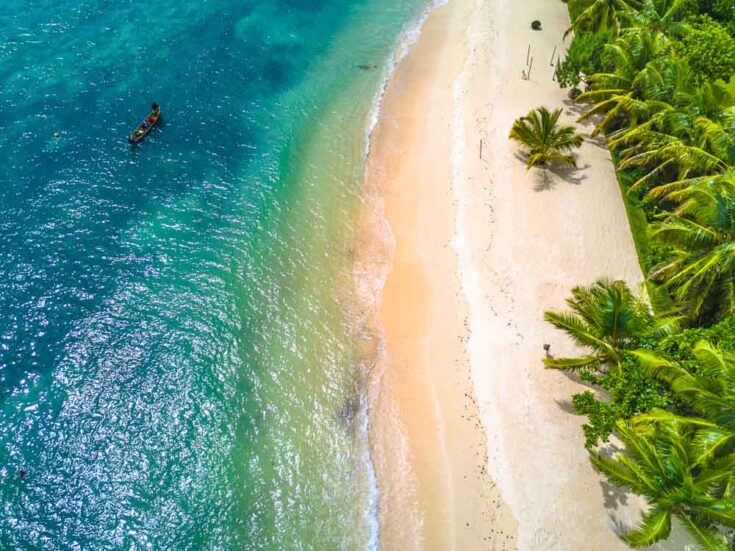
Madagascar Tourism | What You Need to Know
All the information provided here is from my experience traveling around Madagascar in April 2017, but has been updated to reflect the latest pricing and information.
Visa For Visiting Madagascar
Visas are required for everyone visiting Madagascar. You can obtain a 30 days or 60 days visa at all international airports. Despite what the guidebooks say, the 30-day visa is NOT FREE. A 90-day visa is no longer available! 30 days 35 Euro / 37 USD 60 days 40 Euro / 45 USD Or you can apply in advance for an Evisa to Madagascar , this will save you a lot of time when arriving at the airport.
There are no ATMs or money exchanges before immigration and customs, so be sure to bring cash with you to pay your visa fee.
No passport photos are required, but a Yellow Fever vaccination certificate is (depending on your travel history and the countries you’ve visited).
The visa sticker takes one full page of your passport.
Arriving At Ivato International Airport (TNR) When You Travel to Madagascar
The main airport in Madagascar is located 20 km northwest of Antananarivo, the capital of Madagascar.
BNI Madagascar and Bank of Africa are both located after immigration and customs, and they both offer currency exchanges and ATMs. Unlike lots of airports, the exchange rate at Ivato is pretty good, so it’s fine to change up money here.
There are also three small mobile-phone shops selling local sim cards for the three main providers in the country, Orange, Telma, and Airtel. The shuttle bus between the airport and the capital is NOT running anymore, so the only way to get to town is by taking a taxi or arranging an airport pickup via your hotel.
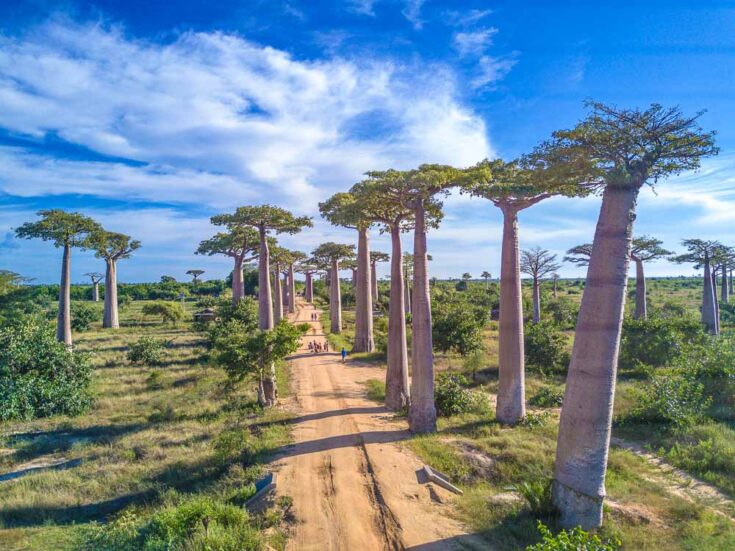
Because of traffic, the drive from the center could take anywhere from 40 minutes to almost 2 hours if you get stuck in evening or morning traffic. The price to the center of Antananarivo is circa 40 000 Malagasy Ariary in the day, but remember to bargain. And at night it will set you back 50 000 Ariary.
NB. The local currency is NOT accepted after immigration on departure. Only USD/Euro are. So be sure to get rid of your local Ariary before you go through immigration on departure. If not, you will be stuck with your Ariary like me.
Money in Madagascar.
The local currency of Madagascar is called Malagasy Ariary (MGA), just called Ariary.
1 USD: 3788 Ariary
1 Euro: 4523 Ariary.
British sterling didn’t seem to be a popular currency to exchange.
Every city and decent-sized town has numerous ATMs these days, and the two main banks are BNI Madagascar and Bank Of Africa. Both accept Visa, Visa Electron, and MasterCard.
None of the banks charged me bank fees when withdrawing money.
The maximum withdrawal at once is 400 000 Ariary (117 Euro / 125 USD)
Every bank seems to be able to exchange USD and Euro, but you will need your passport. But what you really want to know is, is Madagascar expensive? The answer is no. Although the flights can be pricey, that’s usually the most expensive part of the trip. The rest of your Madagascar trip should be relatively cheap.
Internet in Madagascar
Wifi is available in most mid-range hotels and guesthouses around the country, but the speed is slow outside the big cities. 4G mobile connection is available in Antananarivo and Tamatave. In smaller cities a 3G/2G connection is available.
There is rarely an internet connection in smaller towns and on the road between most places.
Orange, Telma, and Airtel all sell sim cards for 40 USD with a 3GB data package on arrival at the airport.
How To Travel Around Madagascar
Traveling around Madagascar takes time and is very slow even by African standards.
Of the now 101 countries I have been to, I will go so far as to say that Madagascar is one of the slowest and most uncomfortable countries to travel around in the entire world.
The only other country I have visited that can be compared to Madagascar is Mongolia.
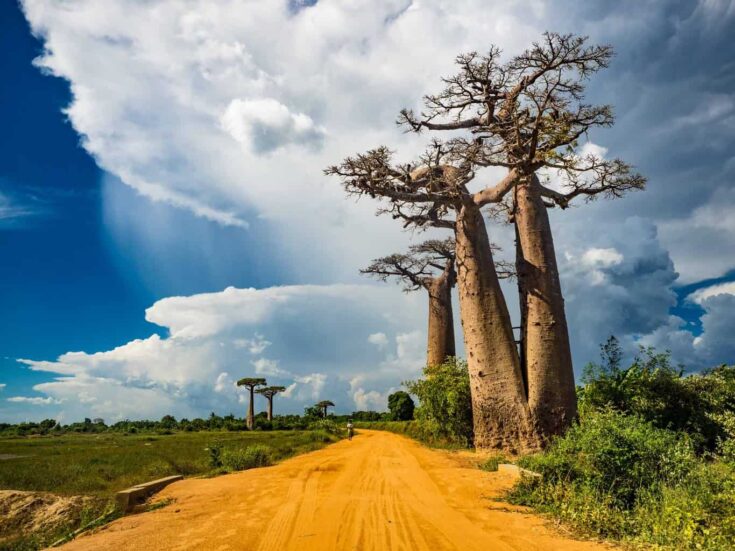
Update: Good News, While flying domestic inside Madagascar used to be ridiculously expensive, there is now a new local budget airline in Madagascar.
Air Madagascar has created a subsidiary just for a domestic flight, and it’s called Tsaradia ( Air Madagascar + Air Austral + Ewa Air). Domestic flight now costs 100 to 115 EUR one way to 400 EUR before.
So if you find traveling around South East Asia, India, or mainland Africa uncomfortable, Madagascar is definitely not for you. But if you like a bit of adventure and have plenty of time, Madagascar is definitely the place to go.
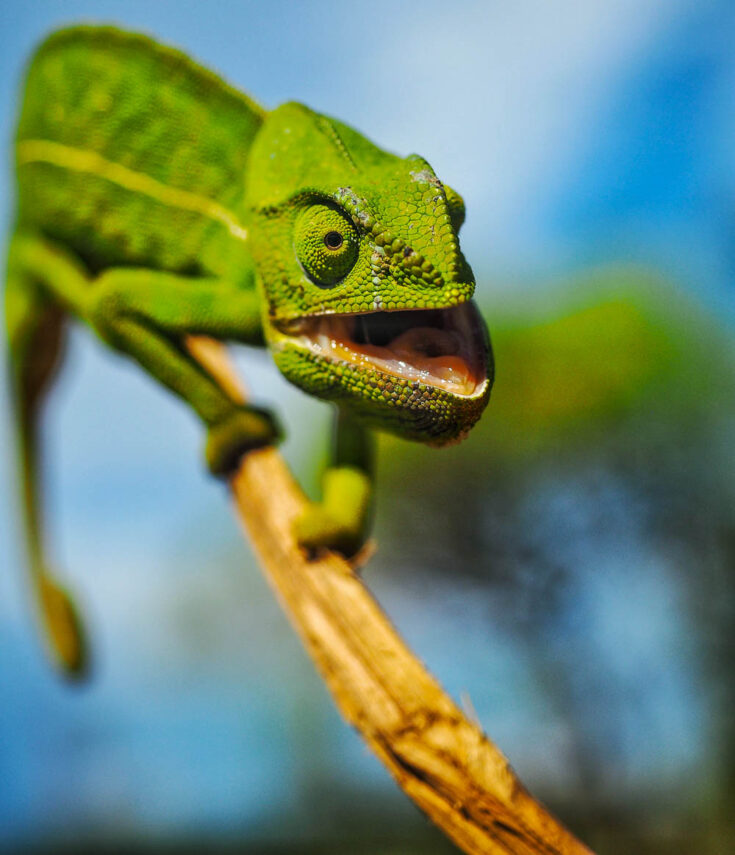
I stayed 16 days in Madagascar and traveling around the island took A LOT more time than I was expecting, so I wasn’t able to visit even half the places I wanted to before I left home. Even the famous Avenue of Baobabs is a national road in the country.
Don’t expect to be able to visit big parts of the country if you only have two weeks and are taking local transport.
If you want to cover big parts of the country in a small amount of time, the only way is to rent a 4WD car with a driver for 65 USD + fuel a day.
The usual way to get around Madagascar is by taxi-brousse, which are usually old Mercedes minibusses that can never be too crowded, stop every time someone wants to get on or off, and only depart when full. So there are no scheduled departures and arrival times can vary by up to 12 hours depending on when it left.
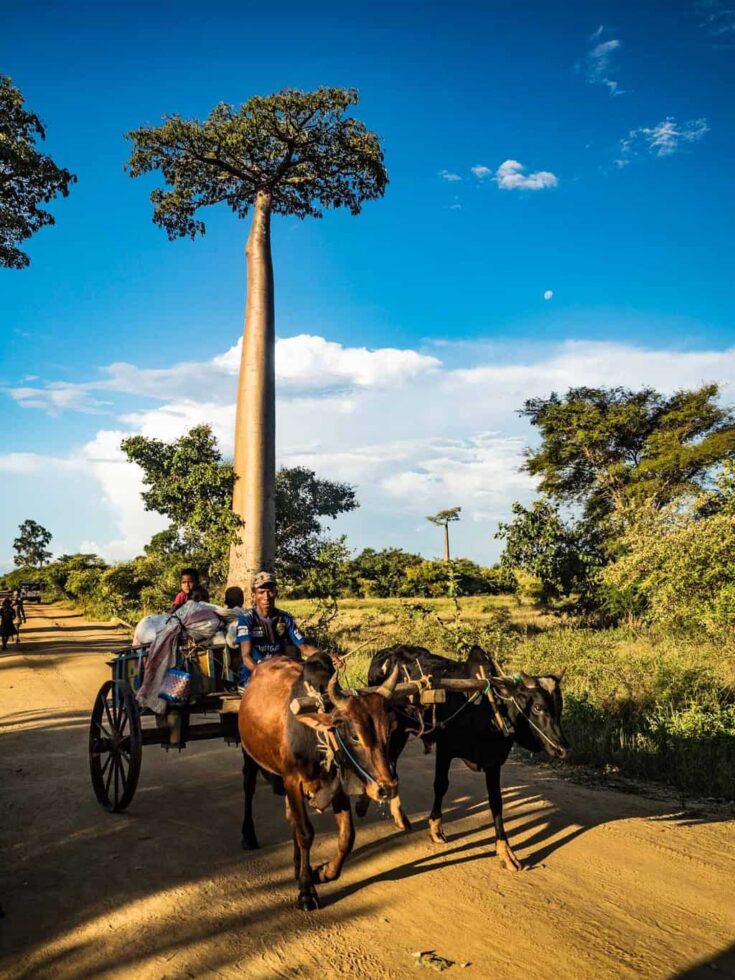
On a taxi-brousse, you’ll get chickens, ducks, and local people falling asleep on your shoulder.
Taxi-brousses are OK for shorter distances, but when you’re 180 cm+ tall like me, your knees and back will be done after hitting the seats in front of you for hours.
But things are improving with Cotisse Transport. This is a new local transport company that leaves on time, so if you’re 5 minutes late, they will have left already. They even offer wifi on board and only one person to each seat instead of 3 as on a normal taxi-brousse.
Cotisse Transport doesn’t offer online booking, but you can book your ticket in advance by going to their office.
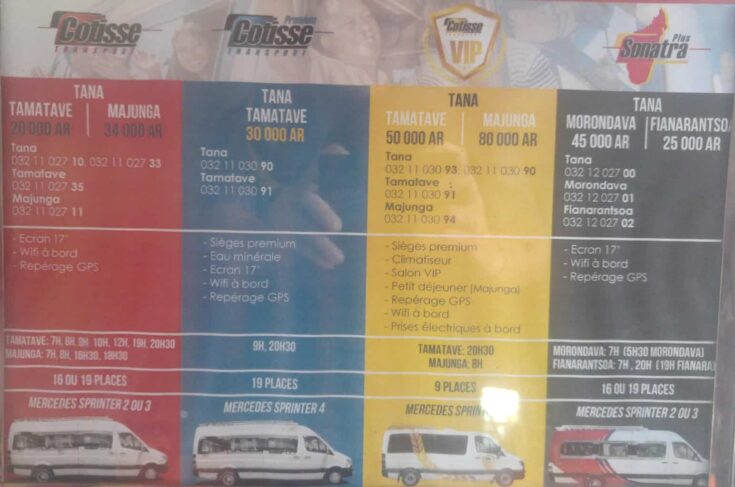
It’s also important to show up a MINIMUM of 30 minutes before departure to register that you are using your ticket and going on your trip and to load your luggage if you have it.
When traveling around Madagascar, you’ll have to pass through and most likely spend the night in Antananarivo each time you want to head to a different part of the country.
During my trip here, I transited the capital three times, and each time I had to spend the night there.
Madagascar, the perfect destination in Africa for the adventures traveler and travellers that want to get away from mass tourism and want to see wildlife and nature, here´s a complete guide to everything you need to know
Is Madagascar safe?
I personally didn’t have any problems in Madagascar, but a lot of travelers I met had been pickpocketed or had stuff stolen from their luggage when taking a taxi-brousse.
There are A LOT of beggars in Madagascan cities, and most of them are young children. Most of them will respect your “no,” but you do come across a few young “pricks” who go straight for your pockets.
You are required by law in Madagascar to carry your passport with you all the time.
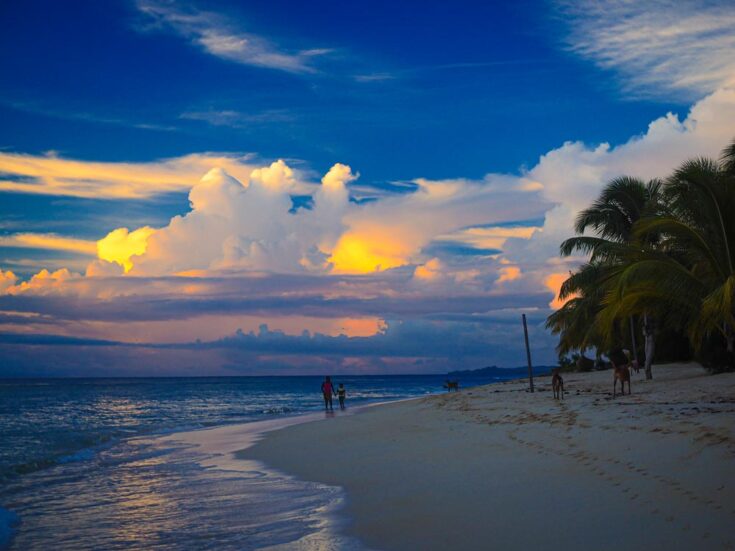
If you don’t have it on you and get stopped by the police/military, you are required to pay an unofficial “safety fine” of around 10 000. If walking around after dark, there is a higher chance of getting stopped.
This is especially true in Antananarivo and around Place de l’Indépendance, where I was stopped four times during my visit. As a single white male walking around, you do get some hassle from local women, especially if you’re going out drinking.
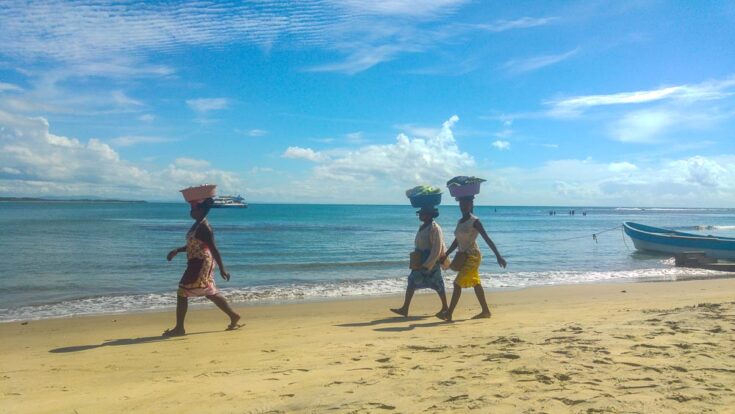
You will see a lot of older white men with young local girlfriends in Madagascar, similar to what you see in Thailand or the Philippines. On the other hand, solo western women shouldn’t face too much unwanted attention, but you shouldn’t walk around on your own after dark at all.
Language in Madagascar
The main language in Madagascar is Malagasy . It’s spoken by everyone. French is the second official language, but every French tourist I met was surprised how FEW locals actually spoke French outside the big cities. VERY few people speak English in Madagascar
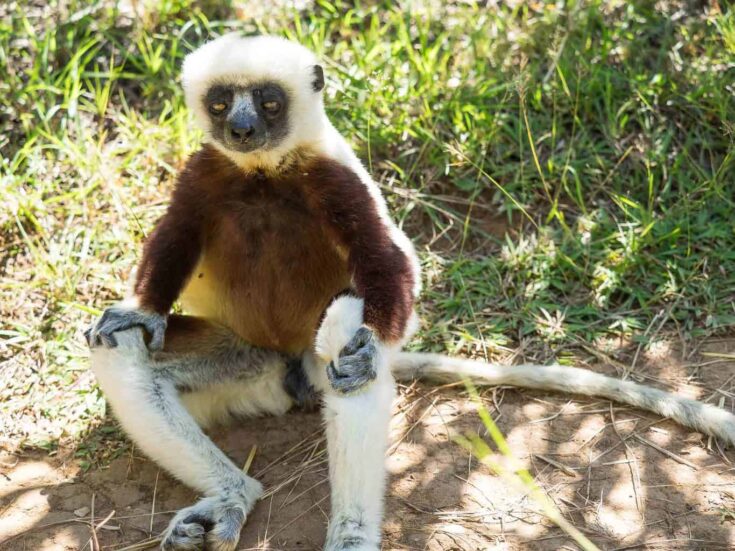
I don’t speak either Malagasy or French, but I still found traveling around Madagascar easy.
The locals were always accommodating and eager to help you out even when we couldn’t speak the same language.
Sunset over the famous Sunset over the Baobabs in western Madagascar.
Guidebook to Travel Madagascar
The newest edition of Lonely Planet Madagascar is pretty accurate and helpful when it comes to transport. But it seemed like EVERY hotel and restaurant (as always) had increased their price since the book came out.
For example, La Banane hostel on I’ll Sainte Marie is priced in the book at 5000 Ariary for a dormitory but the price in April 2017 is 18 000.
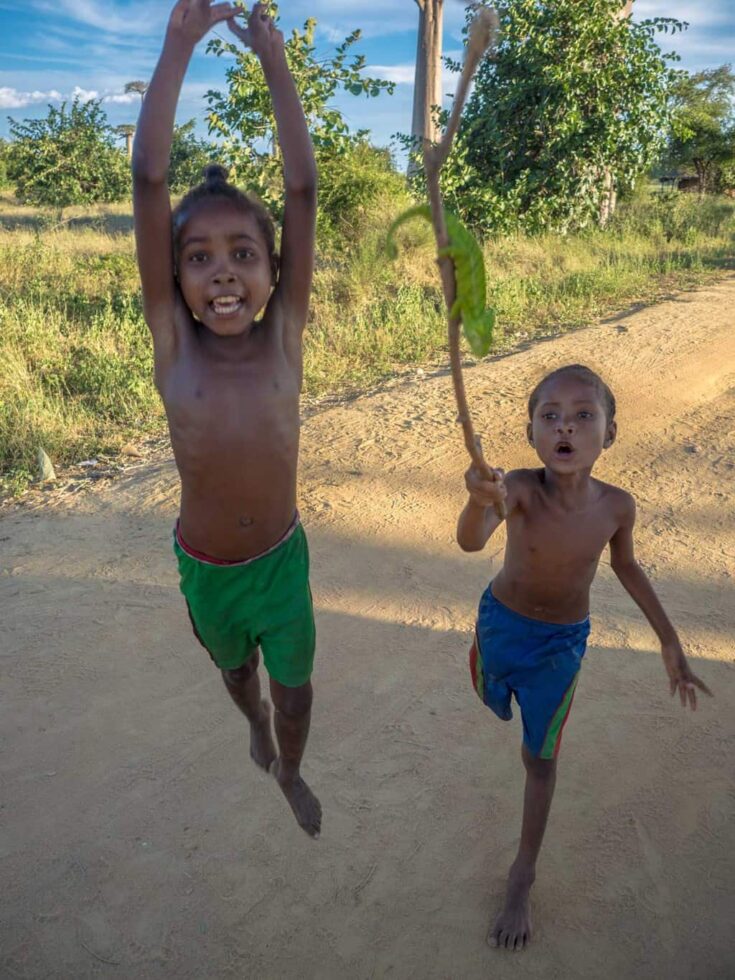
Hotel Eden in Tamatave is 16 000 in the book, but the price now is 28 000. All the restaurants in the book seem to have increased the price by about 5000 for each meal. A few of the hotels in the book have been shut down for years like Hotel Frederic in Tamatave, which is just a pile of ruins.
The boat service Melissa Express recommended in the book to get to Isle Sainte Marie from Tamatave doesn’t run anymore either. It was very evident that Madagascar tourism really changed the place.
Food in Madagascar
Malagasy cuisine is heavily meat-based, and every meal seems to come with rice.
The most popular dish in Madagascar is zebu meat (the local breed of cattle). Almost every restaurant, even small local ones, served zebu steak or a zebu stew. Chicken, duck, and seafood are also always available.
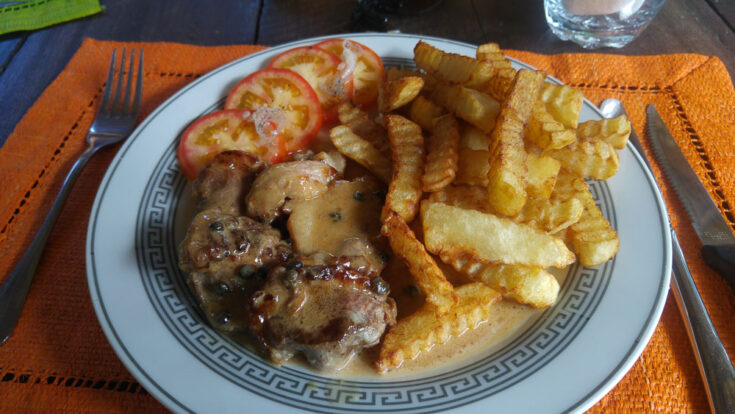
For vegetarians, fried rice with vegetables or noodles with vegetables are the most common dishes. But there is always a vegetable-based accompaniment to go with some rice and lots of eggs available, so being a vegetarian (or even vegan) in Madagascar isn’t a problem.
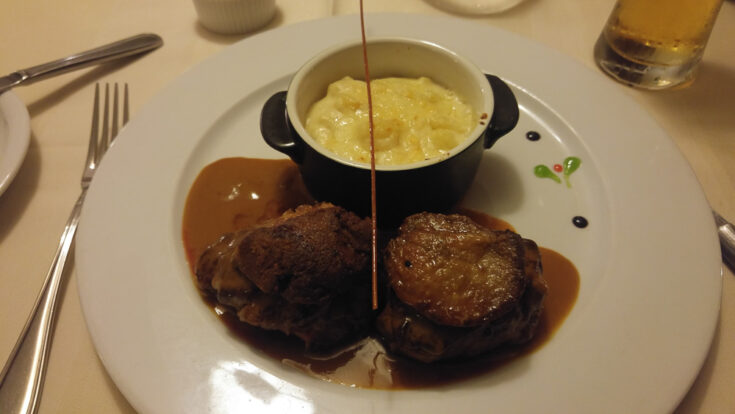
What a 35 000 Ariary Zebu Steak will look like in one of the restaurants in the country.
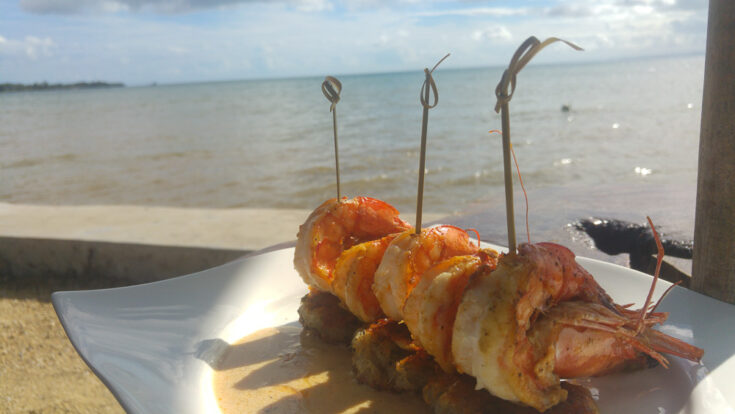
Beer And Alcohol in Madagascar
Only drink bottled water. Bottled drinking water is available everywhere together with coca-cola, Fanta ananas (it’s excellent), and alcohol too – especially the local flavored rum (Rhum arrange) or the local beer brands like Three Horses Beer (THB), Castel, Queens, and Skol.
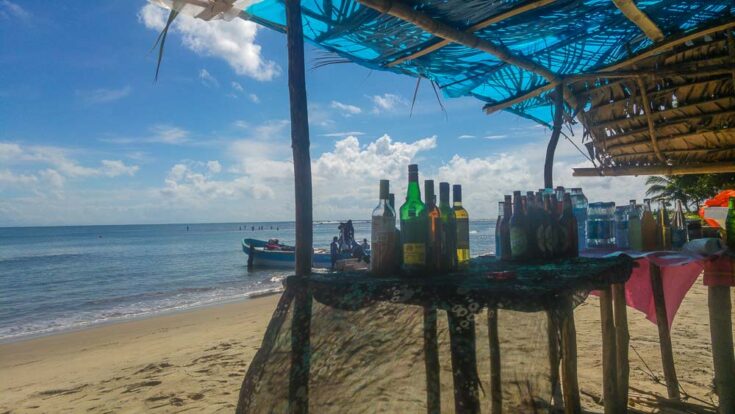
While the locals often drink rum because it is much cheaper than beer, the quality of beer in Madagascar is one of the best in Africa.
At a restaurant, a big bottle of beer is often the same price or even cheaper than a bottle of water.
Budget for a Trip to Madagascar
Madagascar can be done pretty cheaply if traveling on a budget, but you will have to be traveling very rough and taking local transport.
Hostels with dormitories are only really in the capital and very few other destinations.
So traveling with a friend will bring the cost down A LOT.
For EVERY national park, you are required to pay a daily entrance permit and to have a guide.
National park tickets are between 55 000 (17 USD) – 65 000 (20 USD) a DAY. Guides are normally around 15 000 (5 USD) a day.
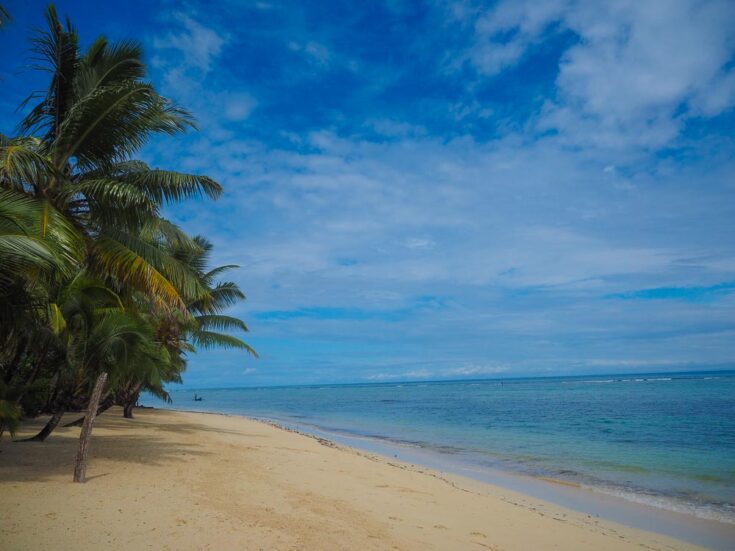
If you want to go to remote places and some national parks, hiring a 4WD car with a driver is often (always) the only option.
Check out the most popular hotels for people who want to share:
The standard price is 65 USD +fuel a day.
Cheap: Around 20 USD a day.
Transport: Local taxi-brousse – 15 000 (5 USD) between big cities.
Accommodation: back hotels with own bathroom, normally with fan: 25 000 (8USD) / 30 000 (10usd)
Food: Local street food and local restaurants. 2000 (0.6 USD) for eggs and toast with coffee for breakfast. Dinner at a local restaurant, 7000 (2 USD) for rice with zebu steak.
Midrange: 45 USD a day.
Transport: Cotisse Transport – 20 000 (6 USD) to 30 000 (10 USD)for Premium.
Accommodation: 90 000+ (30 USD) room with aircon, usually an excellent standard.
Food: 15 000 (5 USD) a meal, a great meal in a typical restaurant.
Flashpacker: 150 USD+ a day.
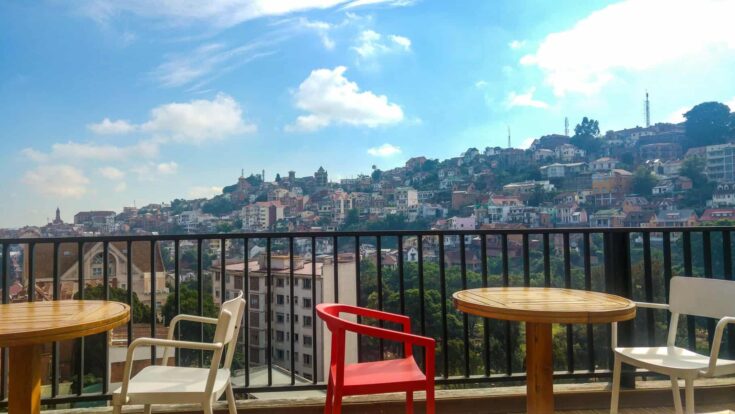
Transportation: Private 4WD with a driver, 65USD + fuel.
Accommodation: 70 USD a day. Great hotels to a high western standard often with breakfast buffets. My recommendation for a paradisiacal beach resort in Madagascar would be Ile aux Nattes .
Food: 35 000 (11 USD) A great meal in some of the best restaurants in the country.
What to Pack for Your Madagascar Visit
Except for the typical gear you would usually pack, you should also definitely pack:
Flashlight: There is almost no street light in Madagascar – even the big cities have no light after dark. Power blackouts are widespread outside the main cities.
Powerbank: It is common to only have electricity for a few hours a day in remote places in the country. Some days there is no electricity at all.
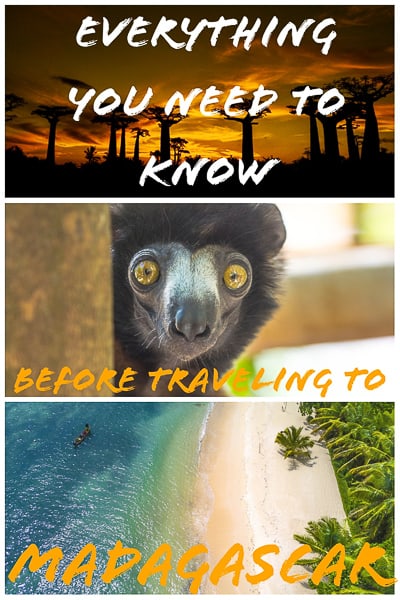
Bug spray: There are tons of mosquitos and other annoying biting bugs in Madagascar.
Waterproof: Something waterproof for your bag.
Your backpack or suitcase will be put on the roof while taking local transport and it rains a lot in Madagascar.
High-factor sunscreen: Difficult to find and expensive to buy when you do, so bring plenty if you burn easily.
If you plan on backpacking for an extended period of time, check out my backpacker’s packing list .
Electricity In Madagascar
The power plugs in Madagascar are the standard European standard 220V dual-pin power plugs. Everyone except mainland Europeans will have to bring a power adapter for your trip here.
Overall Experience Of Traveling to Madagascar
Overall Madagascar is a great country to travel around. But you will need more time to explore Madagascar than you would typically need for other countries.
I was able to see A LOT less in my 16 days on the island than I would be able to do in most other countries in the world at the same time.
You will also have to spend more money on Madagascar for a comfortable trip than you would have to do in other countries.
But if you have the time and are up for an adventure, Madagascar is a fantastic destination. I’d definitely like to come back in the future, but I will be sure to have more time next time.
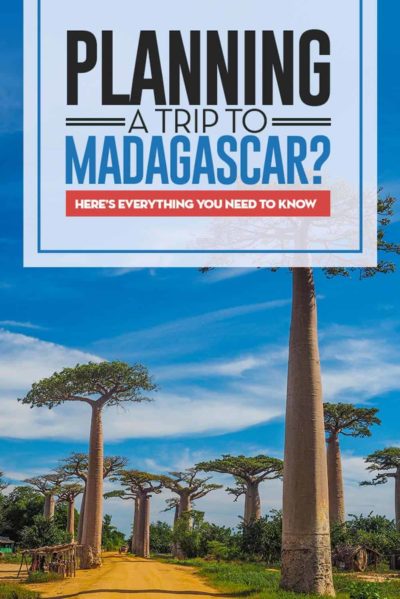
Tuesday 4th of October 2022
What a great article! We're currently dreaming of going to Madagascar again - we've been there before and we love, love love it! Here's to a year with loads of travel plans and new experiences!
Monday 22nd of June 2020
I decided to go to Madagascar next year. Looking for information I got your very informative page. Thanks so much. Do you know of any place I can get info about traveling there after Covid19?
Friday 29th of May 2020
Dear Christian, Thank you for this informative Post. I am a late 20s Youth with Madagascar on my Travel Bucket when the Pandemic finally gives us chance to live again.
In my plan I will be with my Sisters 17 and 22 and my 52 Year Old Mother. We intend to Visit for 16 Days. I intend to have a very good family time with them and also enjoy a little of the Night Life in Madagascar for a fun filled trip. I need your advice, 1. Which part is best ideal for Good fun. We are coming from Uganda.Should we go North? South? East or West? Is it possible to tour a few meaningful places in all Coasts? 2.Do you recommend an Air B and B or can we rent an Apartment? Are these options safe, can we party and make a little merry at night as a family or? Advise us on what is most Ideal.Or should we go to a Hotel instead? Can you recommend? 3.Do you have any Contact person that could be of help to me as I plan my travel? 4. In case one of us gets sick can UAP insurance work for us? 5. Would you recommend good places to visit that will help us make memories as a family? I am grateful, Doreen,Ug
Saturday 16th of May 2020
Thank you so much for the fital information on how to take a trip to madacaascar .
Manjunath K P
Wednesday 12th of February 2020
Hi Christian Your article was very informative. I am shortly travelling on an invite from the tourism department as I am a travel agent based in Bangalore, India
Will look forward to read more of your travel blogs. Thanks & regards
Madagascar Travel Guide
Courtesy of Pierre-Yves Babelon | Getty Images

10 Best Things To Do in Madagascar
Updated Feb. 12, 2021
Madagascar appeals to both animal lovers and outdoor enthusiasts. At national parks like Lokobe , Mantadia and Isalo , visitors can come face-to-face with creatures like lemurs, birds, chameleons and snakes, plus an array of trees and plants. Towering
- All Things To Do

Tsingy de Bemaraha Strict Nature Reserve Tsingy de Bemaraha Strict Nature Reserve
Situated along Madagascar's west coast, Tsingy de Bemaraha Strict Nature Reserve is home to impressive geological structures and a variety of endangered species. More than 328 miles of forests make up this UNESCO World Heritage site, where 11 kinds of lemurs, 17 types of reptiles, 6 bird species and more reside. But the standout here is the park's towering gray limestone pinnacles, which stand up to 328 feet tall.
Past visitors said Tsingy de Bemaraha Strict Nature Reserve is a "must-see adventure" that's "definitely worth the drive." Although the locale can be a bit challenging to traverse – some former travelers reported crawling through tight gaps and lots of climbing – many described the views from the top of the pinnacles as "spectacular."

Avenue of the Baobabs Avenue of the Baobabs free
As its name suggests, the 853-foot-long Avenue of the Baobabs is a stretch of giant baobab trees believed to be up to 800 years old. Though the avenue is situated roughly 405 miles away from Antananarivo, it offers close proximity to Kirindy Mitea National Park, which sits along Madagascar's west coast.
According to recent travelers, the Avenue of the Baobabs is one of the country's best places to snap photos, especially at sunrise and sunset. But remember, these are the avenue's peak visiting hours, so arrive early. Visitors recommend paying for a guide's services, or you can opt for a multiday tour by local companies like Intrepid Travel and G Adventures . Itineraries vary by tour, but expect to spend at least an hour on-site. Tour fees start at $1,140 per person. If you're sticking to a tight budget, consider driving yourself or flying into Morondava Airport (which sits less than 10 miles away from the attraction) – accessible from Antananarivo's Ivato International Airport.

Mantadia National Park (Parc National Mantadia) Mantadia National Park (Parc National Mantadia)
One of Madagascar's most convenient parks to explore is Mantadia National Park. Located about 100 miles east of the capital city of Antananarivo, Mantadia National Park is home to 14 species of lemurs, plus 117 types of birds and 84 kinds of amphibians. Plant enthusiasts will also find plenty to admire here. More than 1,200 plant species grow in this lush park, 120 of which are orchids.
Past travelers enjoyed wandering along Mantadia National Park's five trails, adding that each path and stairway was well-maintained. What's more, several said this protected area is a must-see if you love lemurs and recommend hiring a local guide for a fee at the park's reception counter. Each local guide is an experienced spotter, meaning you'll increase your chances of seeing an array of animals.

Popular Tours

Tsingy Tour 04 Days
(13 reviews)
from $ 782.42

Two days tour to Andasibe NP
(14 reviews)
from $ 410.68

Full-Day Exclusive Private Tour to Nosy Tanikely Marine Reserve
(7 reviews)
from $ 216.75

Lokobe National Park (Parc National Lokobe) Lokobe National Park (Parc National Lokobe)
If your idea of a Madagascar getaway consists of hiking through a tropical forest and observing lemurs in the wild, then you must visit Lokobe National Park. Situated on the southeastern tip of Nosy Be, an island off Madagascar's west coast that's known for its picturesque beaches and sunsets, Lokobe National Park is one of the Sambirano region's only remaining forests. The park can only be accessed by motorized, canoe-like boats called pirogues , adding to its tranquil, unspoiled atmosphere.
Although some recent visitors cautioned that getting to the park and exploring it can be quite exhausting, most raved about its beauty and wildlife. You'll have the chance to spot three lemur species here, as well as multiple kinds of amphibians and reptiles. Highlights for past travelers included watching boa constrictors slither in the trees, seeing chameleons blend in with their surroundings and feeding lemurs bananas. Since you'll be trekking through wild terrain, remember to wear comfortable sneakers, as well as long-sleeved clothing and bug spray to protect yourself from mosquitoes.

The Three Bays (Les Trois Baies) The Three Bays (Les Trois Baies) free
If you want to take in water vistas without trekking offshore to islands like Nosy Sakatia or Nosy Be, head to The Three Bays. Made up of three bays – Sakalava, Pigeon and Dune – this area features pristine beaches where activities like swimming, hiking, windsurfing and kitesurfing can be enjoyed. You'll also have ample opportunities to take jaw-dropping photos here.
Visitors rave about The Three Bays' beautiful setting, adding that the kitesurfing conditions at Sakalava Bay are superb. The area is also easy to reach by car since it's just 10 miles northeast of Antsiranana. For those who'd rather explore The Three Bays on a quad bike, Diego Raid offers four-wheel drive tours for $21 per person (or $120 per vehicle).

Anja Community Reserve Anja Community Reserve
Although Madagascar offers several places to spot lemurs, one of its more unique animal locales is Anja Community Reserve. Located about 41 miles southwest of Fianarantsoa along National Road No. 7, this environmental and cultural preservation site strives to protect local flora and fauna within an inhabited area. Ring-tailed lemurs, chameleons, snakes and more live here, and the reserve's surrounding granite mountains feature two hiking trails, various caves and a campsite with water, restrooms and a shower area.
Past travelers enjoyed checking out Anja Community Reserve on foot, saying they saw multiple lemurs during their visits. Many also raved about the easier Small Circuit Loop, which takes about two hours to complete. For a more challenging hike, consider trekking the six-hour-long Large Circuit Loop. If you decide to stay overnight, remember to bring camping equipment since it is not available at the campsite.

Isalo National Park (Parc National Isalo) Isalo National Park (Parc National Isalo)
Isalo National Park woos visitors with its vertical rock walls, lush vegetation and picturesque waterfalls. Throughout this tropical paradise, travelers can hunt for reptiles and primates – there are more than 50 species living here – while strolling along 10 walking, hiking and bike trails. Some paths even lead to natural swimming pools, where you can cool off while taking in your surroundings.
Previous visitors had mixed feelings about Isalo National Park. While some described it as Madagascar's best national park, others felt it was too expensive. But if you can pay the park's 65,000 Malagasy ariary ($20) entrance fee and roughly 4,000 to 113,000 Malagasy ariary (or $1 to $36) to explore one of its paths during a guided tour, past travelers said you'll be rewarded with "stunning" views of an "incredibly beautiful" area.

Tsingy Rouge Park Tsingy Rouge Park
Although this attraction in northern Madagascar is a bit removed from the main roads, Tsingy Rouge Park's dramatic landscape cannot be missed. Featuring tall clay-like rock formations created by landslides and mudslides, this area's red rocks are often compared to the larger ones found at Utah's Bryce Canyon National Park.
You'll need a four-wheel drive vehicle to get to this natural wonder, but recent travelers recommend making the trek. If you don't rent a car while in Madagascar, you can take one of several organized tours to the site; rates start at $168 per day, excluding lodging and meals. Tour operators that visit Tsingy Rouge Park include Soa Tours and Visit Mada Tours . Since the terrain is rough in this park, be sure to wear comfortable walking shoes.

Lemur Day Tour at Andasibe Rainforest and Vakona Lodge Reserve
(18 reviews)
from $ 299.00

Antananarivo: Lemurs Park & City Tour
(3 reviews)
from $ 456.32

Guided tour of the Nosy Komba and Nosy Tanikely Islands
(16 reviews)
from $ 96.97

Nosy Sakatia Nosy Sakatia free
When you're in need of a break from Madagascar's parks and forests, head to the quaint island of Nosy Sakatia. This tropical oasis – which measures just 1 square mile – boasts an array of orchids but is best known for its water sports activities. Everything from sailing to fishing to snorkeling and diving is offered here, and you can even spend a night or two at one of the island's hotels .
Past visitors loved scuba diving and snorkeling in Nosy Sakatia's waters during half-day excursions. Many, in fact, saw sea turtles grazing in shallow areas. However, a few travelers were less than impressed with the island's beaches and desired more things to do on shore. If you do decide to visit Nosy Sakatia, consider booking a half- or full-day tour through companies like City Discovery and Les Baleines Rand'eau . Tour rates start at $50 per person and generally include snorkeling equipment rentals and lunch.

Lemurs' Park Lemurs' Park
Although you'll have ample opportunities to spot lemurs in national parks like Mantadia and Lokobe , for even more chances to see these furry creatures, travel 16 miles southwest of Antananarivo to Lemurs' Park. This private, 12-acre reserve houses nine lemur species, as well as various lizards and birds and 70-plus types of plants. In addition to welcoming tourists, the park works with other Malagasy reserves to rehabilitate and breed lemurs.
Travelers say Lemurs' Park is a great place to see lemurs without venturing far from Antananarivo. Though you won't be allowed to touch the lemurs, the property's animals move freely around the park, so one may try touching you. Many also rave about the attraction's well-maintained facilities and knowledgeable guides.

Explore More of Madagascar

Best Hotels

When To Visit
If you make a purchase from our site, we may earn a commission. This does not affect the quality or independence of our editorial content.
Recommended
The 28 Best Water Parks in the U.S. for 2024
Holly Johnson|Timothy J. Forster May 8, 2024

The 18 Best Napa Valley Wineries to Visit in 2024
Lyn Mettler|Sharael Kolberg April 23, 2024

The 25 Best Beaches on the East Coast for 2024
Timothy J. Forster|Sharael Kolberg April 19, 2024

The 50 Best Hotels in the USA 2024
Christina Maggitas February 6, 2024

The 32 Most Famous Landmarks in the World
Gwen Pratesi|Timothy J. Forster February 1, 2024

9 Top All-Inclusive Resorts in Florida for 2024
Gwen Pratesi|Amanda Norcross January 5, 2024

24 Top All-Inclusive Resorts in the U.S. for 2024
Erin Evans January 4, 2024

26 Top Adults-Only All-Inclusive Resorts for 2024
Zach Watson December 28, 2023

Solo Vacations: The 36 Best Places to Travel Alone in 2024
Lyn Mettler|Erin Vasta December 22, 2023

26 Cheap Beach Vacations for Travelers on a Budget
Kyle McCarthy|Sharael Kolberg December 4, 2023


Madagascar in Two Weeks – The Perfect Itinerary 2024
When planning your trip to Madagascar, it’s important to remember that it takes a long time to get anywhere in the country.
Hi, we’re Rach & Marty!
We’ve visited every country in the world and want to help you get the most out of your travels!
Whether you need an expertly planned itinerary , some experienced hints and tips , or just craving a delicious food adventure , we’ve got you covered!
We may earn affiliate commissions from websites we link to, at no cost to you. Click here for details.
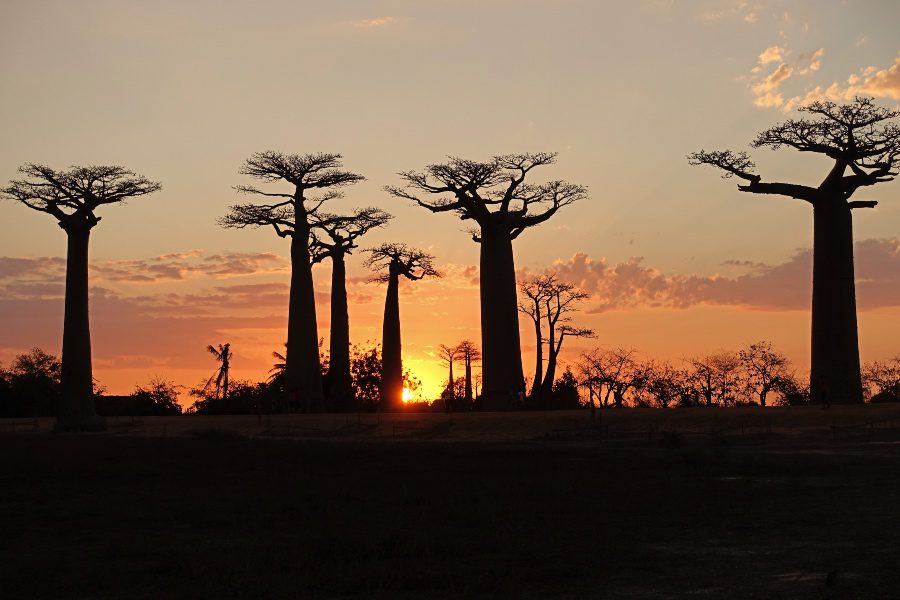
Some of your days will purely be spent just travelling from one place to another as the roads are terrible here and this country is huge.
We had 16 days to spend in Madagascar and we wanted to see as many highlights as possible.
We decided to explore the East and West Coast of Madagascar in two weeks.
Our itinerary was busy, yet we found time to see the major highlights such as the Avenue of the Baobabs, Tsingy National Park, Ill Sainte-Marie Island, and lemurs in Andasibe National Park to name a few.
If you only have time to see Madagascar in two weeks, here is our daily itinerary. This includes some great tips for getting around, where to stay, where to eat, and what things cost.
The currency used in Madagascar is the Malagasy Ariary. At the time of writing, 1 USD = Ar 3,728.
We visited Madagascar in November 2019
Table of Contents
The Perfect Itinerary for Madagascar in Two Weeks
Day 1 – antananarivo.
Our flight arrived at the airport in Antananarivo at 6 pm. In the evening, a taxi from the airport costs Ar 50,000 ($13). There is an ATM in the arrivals hall to withdraw local currency. There are also two places here selling local sim cards. Orange store quoted us Ar 80,000 for a 2GB sim card.
The other place called ‘Telma’ has a sim card for Ar 500 and an additional Ar 25,000 for 2GB data (ours also came with a bonus 2GB data to use between 18:00 – 06:00 only). It took about ten minutes to register, the guy just needed a passport to do so.
We asked our taxi driver to stop at the Cotisse transport office in the city on the way to our hotel. And it was the smart thing to do, as we scored the last two seats to head to Morondava the next morning at 06.30. Tickets cost Ar 45,000 each.
The office in Tana is located here. You will need your passport to book a ticket and make sure you have local currency too. If you don’t get local currency from the ATM at the airport, there is an ATM just across the road from the Cotisse transport office.
Our hotel in the capital city
We stayed at Hotel Tana Jacaranda . This budget hotel is a traveller’s favourite, and rooms are affordable at Ar 57,000 per night (USD 15). The hotel is in a good location in the centre of Tana. The rooms are pretty small, yet clean and comfortable, with a separate private bathroom.
The great service here is why this place is so popular and why it fills up quickly. We ordered some food at the hotel when we arrived as it’s not recommended to walk around in the evening here. We paid Ar 10,000 for a lentil curry with rice which was good.
The hotel booked us a taxi for the following morning too. I’d say that being super organised is the key to enjoying your trip in Madagascar in two weeks.
Day 2 – Antananarivo to Morondava
The taxi picked us up from the hotel at 05.30, the price was Ar 27,000. We checked in at Cotisse Transport at 06:00, they tagged our luggage and we grabbed some simple pastries and coffee from the small cafe attached to the station that was just opening up. It was going to be a long day, so it’s important to have some food or at least have some snacks for the drive.
Cotisse Transport is THE COMPANY that you want to try and travel with as much as possible to get around Madagascar. Especially if you’re backpacking Madagascar and trying to keep the budget down.
The transport is affordable, reliable and they depart and arrive on time. The alternative, unless you have the money to pay for a private driver and car for your trip in Madagascar will be taxi-brousse (shared taxis). These are the opposite of Cotisse Transport and you want to try and avoid using them if you want to maximize your precious time spent in Madagascar.
The journey took 13 hours and 15 min. There were only a few 5-minute stops for a toilet break and one 30min stop at a local restaurant on the way. You can eat a local dish of a mountain of rice and some meat curry for Ar 4000 each.
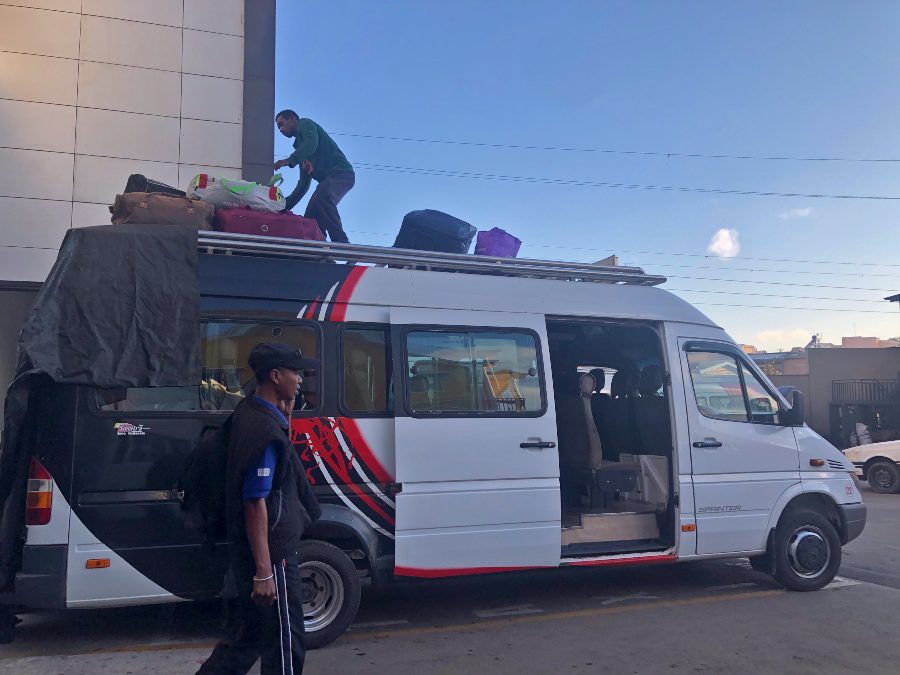
We arrived at 7.45 pm. The Cotisse office is conveniently located right near the beach with a few budget/mid-range hotels close by. We stayed at Jean Rasta (also known as L’Oasis) , a Bob Marley-looking bar/restaurant that has only two small bungalows with fans and a bathroom, it’s about 7 min walk straight down the road from Cotisse Transport office. The price is 50,000 per night (two people).
It’s worth noting that this place has live music from 8 pm each night. The rooms are very close to the bar area, so it’s not a place to get rest. No wifi here either.
Next time, I’d make a reservation at Select Hotel . This new hotel has rooms from USD 30 per night. It has fabulous reviews, and all the amenities you need for a comfortable stay. It is located on the main street (further from the beach).
Once you arrive at the Cotisse transport station, or the shared taxi station, just take a tuk-tuk to Select Hotel for about Ar 4000-6000 (about $1-2), depending on how good your negotiating skills are.
Click here to see the availability of other hotels in Morondava.
We walked for 5 min to a restaurant called Les Bouvillers. They serve decent local Malagasy dishes for Ar 6000. (the zebu coco curry is tasty). They have good wifi and cold beer here too.
You’ll learn to appreciate these things after many long travel days in Madagascar in two weeks. The food we ate during our Madagascar itinerary seemed to get better and better – it may be a surprising highlight for you too.
Day 3 – Morondava
We woke up and enquired at our accommodation about taking a trip to visit Tsingy National Park. We were in luck, as Jean, the guy who ran the accommodation used to be a guide there years ago and he can arrange trips for tourists to visit.
I wrote a detailed post about how to get to Tsingy National Park , so check it out.
We spent the afternoon exploring Morondava and finding some more people to fill our 4WD for the trip to Tsingy. (more about that in the above post) Morondavea is small so it’s easy to find your way around. The main street has small shops, markets, a great bakery where you can buy amazing baguettes and lots of pharmacies too. Once we confirmed a French couple to take the trip to Tsingy with us, we paid for the trip (in EUR or local currency is ok).
We returned to the Cotisse Transport office and booked our return transfer to Tana for 3 days’ time. This is highly recommended as seats fill up very quickly. The cost was Ar 45,000 each and it was going to be another very early departure.

This Madagascar Travel Itinerary in two weeks is busy.
This Madagascar itinerary in two weeks is going to be busy – but the key to making your trip run as smoothly as possible is to be super organised.
At the same time as booking the above tickets, we also booked the next leg of our trip with Cotisse Transport for the day after our arrival into Tana. We were heading to Tamatave for the next morning.
We paid for these tickets, Ar 20,000 each.
Tamatave is a town that breaks the journey – as we wanted to get to the beach, Ill Sainte-Marie for some beach time.
I’d recommend that you buy any food, baguettes, cream cheese, biscuits bananas etc for the trip to Tsingy. There are very few places to get food and snacks and fresh bread is not available anywhere there. Obviously, you can purchase all meals from your accommodation in Tsingy National Park.
TIP: The accommodation isn’t included with the Tsingy trip, so you need to book this separately.
We stayed at a lodge called Tanankoay . We didn’t have a reservation, but we were lucky they were able to offer us a simple bungalow for 15,000 per night (less than EUR 4). They also have upgraded bungalows for 25,000 and more expensive ones too. This is THE place you want to stay at.
Reservations are highly recommended as this place books out regularly with tour providers using it to accommodate small groups. All details, including phone and email information, are available on their website here.
Day 4- Morondava to Tsingy National Park
Our driver arrived at 07.00 and we left soon after. We shared the ride with a young French couple. The journey today is very bumpy and it takes about 9 hours. This includes one long ferry ride (30-40min) and one short one. The 4WD is driven onto a huge wooden raft/ferry placed over motorised boats. It’s quite clever.
In between ferry rides, we stopped for lunch in a town called Bel Sur.
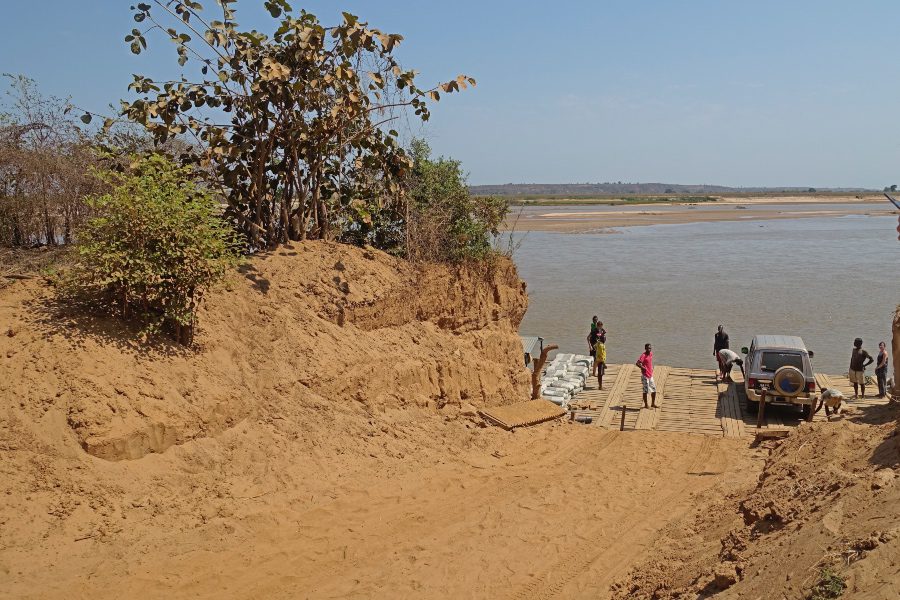
There are lots of places to eat here, tourist restaurants where you can buy an expensive plate of food for Ar 30,000 or you can choose to eat street food for as little as Ar 100- 500 for deep-fried sweet potatoes or small plates of simple noodles. We arrived at the lodge at 4 pm.
We stopped at the entrance to the National Park to pay entrance fees and our guide for the following day. Prices are noted at the end of our detailed post about how to get to Tsingy National Park .
It’s up to you how you spend your time once you reach this lodge. You can relax here or walk back into the small town if you like, it takes about 20 min. This lodge has good wifi between 5.30-9 pm and great food in the evening. They offer a plate of the day for Ar 19,000 and the food is very good.
Day 5- Exploring Grand Tsingy & Small Tsingy
We departed at 07:15 am in a convoy with all the other 4WDs and passengers from our lodge and a few others. We drove for about 45 min – to 1 hour to Grand Tsingy. First, our guide helps us put on our harness, then we walk in. We walk around and explore the forest first, spotting our first lemurs and a mongoose.
Then the fun begins. We enter a small cave and start clipping on /off to ensure our safety. (Exploring Grand Tsingy requires you to climb a protective climbing route called via Ferrata). It is here that you see all the other small groups of people on the route and you must wait for each other to climb safely and clear the route so you can ascend.
I’d say that the climb is a little difficult, yet safe. If you suffer from vertigo, you may not enjoy this activity. The limestone rocks you are climbing are sharp, so it takes quite a bit of concentration.
Epic views from the top !
Once you climb to the top, the view is awesome. There are a few different platforms to look out for these incredible rock formations. You’ll cross a very cool bridge, one person at a time, and see more platforms. Then it’s time to climb down using ladders and lots of clipping on/off for safety. There is a part where you pop down inside a chasm or slim rocks and caves.
There are a couple of different circuits to take to visit Grand Tsingy. We chose Andamozavaky, as it’s the most popular circuit and the one that most visitors take. It is around 4 km long and you will spend approximately 4-5 hours inside the park.
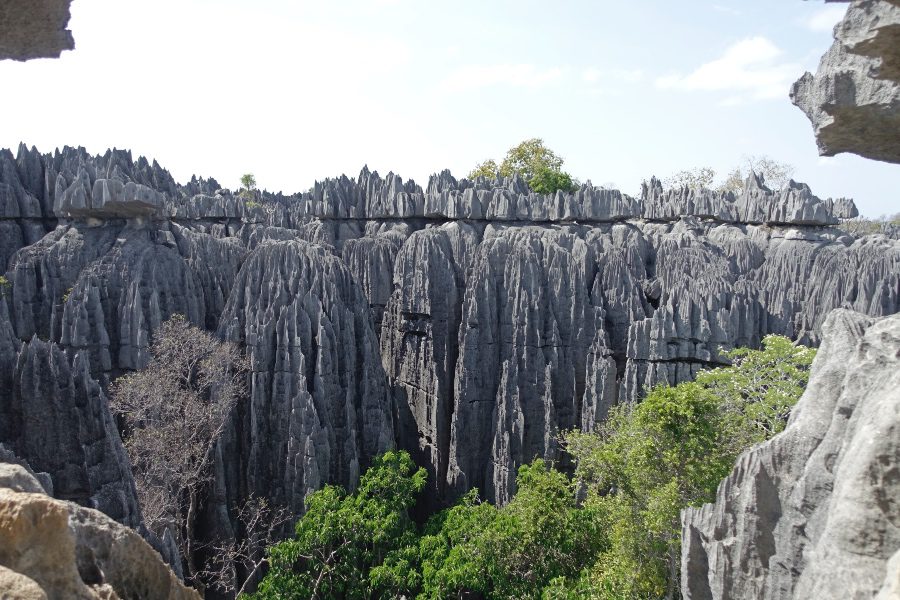
Exploring Grand Tsingy requires you to be climbing over very sharp rocks, so you need to wear good footwear/hiking shoes.
NOTE: The route will take you through some very slim openings in the rocks, therefore it would be difficult for larger people to complete the route.
We returned to the car park (with everyone else) and had half an hour or so to eat lunch. There is an option for the lodge to prepare a pre-packed lunchbox for you to take today for Ar 16,000. You can choose to take your own (baguettes, cheese & jam you bought from Morondava perhaps) or some people return to the lodge to enjoy a hot lunch and take a break there. We drove past the lodge to get to the small Tsingy, so it’s entirely up to you or your group.
We then drove to Small Tsingy. This circuit is a much easier option. If you’re not a very fit person or if you carry a lot of weight, I’d recommend only exploring the Small Tsingy. This route does not require any harness, you won’t be doing any difficult climbs except for a few ladders to reach a couple of great views.
Again, there are a number of different circuits you can do in Small Tsingy. Our circuit was 1.7 km, it took around 1.5 hours. Once we finished, we dropped our guide in town and we returned to camp in the late afternoon. You will definitely need a shower as it is a hot and sweaty day.
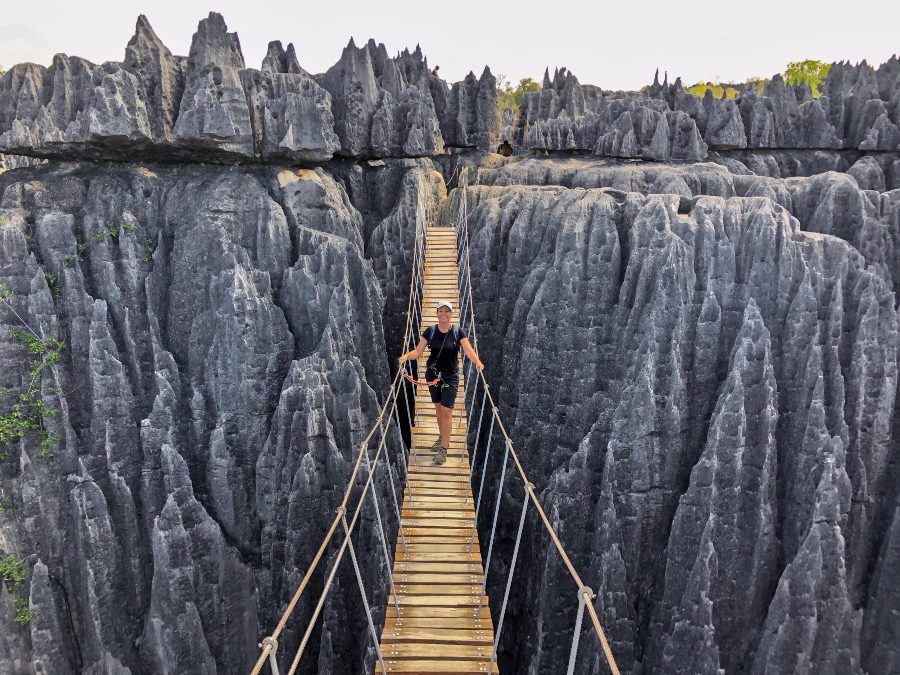
Day 6 – Tsingy to Morondava
Our departure was 07:00 am. We drove back to Morondava today. I noticed again that all the other 4WDs leave at the same time, so you kind of follows each other along the bumpy, dusty tracks. We stopped again for a lunch break in Bel Sur town.
This time I found a local restaurant called ‘Hotel Renala’, with a menu for local plates of food for Ar 6000. It looked good, I’d eat there next time. All other options to eat are expensive and clearly geared at the tourists passing through on tours.
Then we drove towards the big ferry crossing. This took some time today as new people and vehicles are being ferried over and it takes time to fill up the ferry with all the 4WDs on our side. We hung around in the shade for about 1 – 1.5 hours.
The crossing takes about 45 min. Once we unload from the ferry, we continue driving. Around 3.30 pm, we approached the baobabs. First, we stopped to check out a ‘sacred baobab’ and then a ‘love baobab’ on the way.
We arrived at the Avenue of the Baobabs at 4.15 pm. The driver will park and wait for you (and request Ar 4000 from you to pay for the parking fee). Here you can wander down the avenue, take photos and chill out. There is a nice cafe here serving large THB beer for Ar 7000.
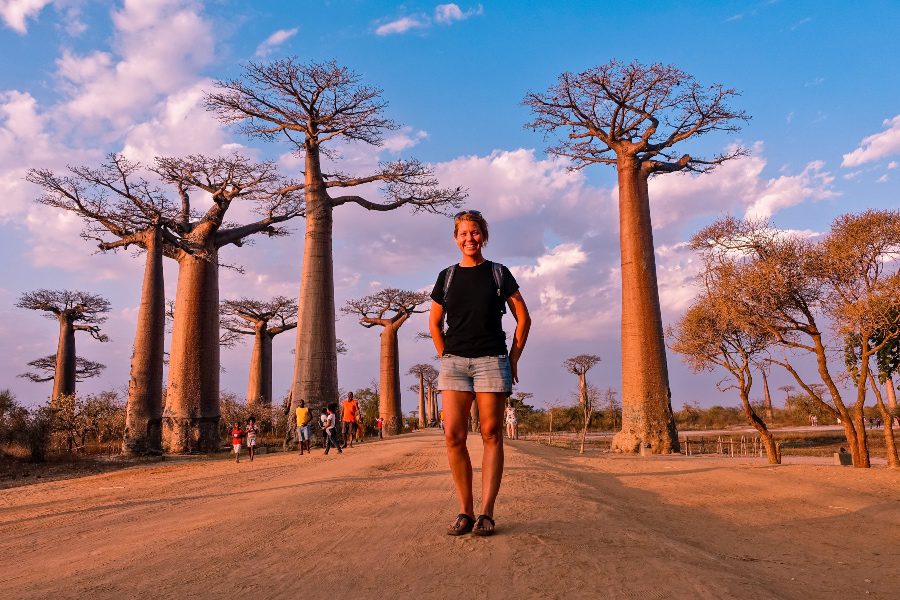
We sat down and enjoyed the moment for a while with a beer, it had been a busy few days. There are lots of people here at this time of the day. The best photos we took are from standing on the opposite side facing the sunset with a line of trees and the sun is setting just behind them. It was a nice moment, except for the 4 drones flying above our heads the entire time.
Our driver dropped us at our accommodation for the night – Select Hotel .
How to get to Tsingy National Park -everything you need to know
Travelling to a country with a different currency? Avoid ATM transaction fees and pay in local currency with a Wise Card . We love this card; it has saved us so much in fees.

Day 7 – Morondava to Antananarivo
An early start again, we checked into the Cotisse Transport office at 05:00 am. Our departure at 05:30 was on time, just as the sun was rising. This was another 14-hour drive day. We stop at a small town where we ate breakfast at a very simple stand serving big sweet bread rolls and small black cups of coffee. Each was only Ar 1000.
Our lunch stop was somewhere in the lush green part of the country for a plate of rice and vegetables. We got back in the van and arrived in Tana at 7.30 pm.
A taxi to our hostel, Madagascar Underground was Ar 15,000.
This time, we booked a private room for Ar 84,000 and ate some dinner upon arrival at the hostel. The staff was very good here and this was one of the most comfortable beds we had during our whole time backpacking Madagascar.
Day 8 – Antananarivo to Tamatave
This morning we took a pre-booked taxi from the hostel at 07:00 am. The cost was Ar 20,000. We checked in at Cotisse Transport again and had our luggage tagged. There’s a small cafe here where we ate some fresh pastries at Ar 1500 each and fresh black coffee for Ar 1000. Our departure at 08:00 to Tamatave was right on time. This drive would take most of the day again.
We stopped at 1 pm for lunch and ordered the standard rice and sautéed vegetables for Ar 4000. You can order meat with rice, but from my experience, you get very little meat in the portion, mostly just bones. This was a nice spot, with tropical surroundings and the food was very good.
On the journey today, we experienced many curving and winding roads. I felt sorry for the small boy sitting across from me that vomited in a bag the entire trip.
We arrived at 5.00 pm. We initially went to the Eden Hotel as it is marked in the guidebooks as a good budget option. I’m sure that this information hasn’t been updated for a very long time because the rooms are very old and tired.
Sure, they’re cheap (Ar 20,000 for a room) or Ar 30,000 with an old shower inside the room, but we just couldn’t do it.
We walked down the road and found the Java Hotel. They offered a room to us for Ar 110,000 per night (USD 30). This hotel is very nice, modern, has a good bed, was clean and the wifi was fantastic (something that is hard to find in Madagascar).
Click here for the best prices and availability for other hotel options in Tamatave.
As we arrived quite late at this hotel and it was also Sunday, so everything was closed. We asked the guys in reception to help us arrange a transfer to get to Ile Sainte-Marie the following morning. They booked us two seats with the company, Cap Sainte Marie. and our pick-up was for 04:00 the next morning. One thing you will get used to when travelling in Madagascar in two weeks is that everything starts super early.
Go and eat dinner at La Terrasse, a restaurant that is about 5 min walk down the road. This place is busy with locals and tourists. They have good food starting from Ar 11,000 mains and the beer is cold and cheap too.
Join the Very Hungry Nomads Newsletter!
Advice & travel tips to visit every country in the world!
Day 9 – Tamatave to Ile Sainte-Marie
We were picked up at 04:15. The van then drove us ten minutes to the Cap Sainte Marie office in Tamatave.
We paid Ar 80,000 each for a one-way ticket. This includes a van transfer to Soanierana – Ivongo, and then a boat transfer from here to Ile Sainte-Marie. The larger minivan was filled with other passengers and we left at 4.45 am.
The roads are dismal along the way, it is very slow going. We got to see the coast and watch the sunrise on the water to our right in between the huge potholes in the road. The very bumpy ride lasts for several hours. Soon it gets a little better and a few small towns and villages pop up amongst the tropical surroundings and vibrant green rice paddies too.
We arrived at Soanierana – Ivongo at 10 am. We had to check in with the guy at the small Cap Sainte Marie office, then show your passport to the Police, just across from this office. I picked up a few baguettes and some bottled water and then headed through the busy little laneway to get on the boat.
Life jackets are provided and I was happy to see that the boat isn’t overcrowded. It fits about 25-30 people. We left at 10.30 am, arrived at 12.30 pm.
When we arrived at the small port, we booked our boat back in a few days to ensure we didn’t miss out. It was the same price, Ar 80,000 each.
Ile Sainte-Marie should definitely be included in your itinerary
Booking.com is an easy-to-use search engine. It offers the best selection of accommodation available all over the world. We find they offer the lowest prices and no fees. Our Tip: Search by price, and filter by best reviews.
To get a bit of a break, we pre-booked our accommodation and stayed at Hotel Paradise Club . We loved our stay here, so quiet and the beach is gorgeous and blue. We paid Ar 130,000 or $30 per night for our stylish bungalow right on the beach.
This place has a French owner, so it is very well run. This is also where we ate some of the best food during our whole time in Madagascar.
The plate of the day (main only) costs Ar 23,000 per person and we enjoyed delicious fish each night. You can also order the complete menu (3 courses) for Ar 50,000 each or $13. The 3-course menu we ate on our first night was something to talk about.
Our starter was a French salad with dressing, the main course was a huge plate of fresh fish brochettes and vegetables. We finished with a dessert of toasted coconut balls with fresh mango.
It was so delicious and then we just wandered back to our beach bungalow to relax with the sound of the waves crashing nearby. Bliss.
There are many fantastic accommodation options at Ile Sainte-Marie. Click here to see rates and availability for some other properties to compare.
Get Connected with eSIM

Get connected easily on your travels—buy an eSIM! It works like an app: buy it, download it, and get connected in minutes! It’s easy, affordable, and convenient. Keep your original phone number, too!
Use our code: RACHEL5045 to get $3 off your first purchase!
Day 10 – Rest day in Ile Sainte- Marie
Today we had our first sleep-in since forever! It was so nice to wake up to the sounds of the ocean and have no plans but to chill! We made our own chilled espresso using our trusty portable coffee machine and sat on our porch overlooking the palm trees for the morning.
It was nice to read our books and take a dip in the blue water just footsteps from our bungalow. In the afternoon we walked through the small village to the main road and checked out some of the island.
It has a nice atmosphere on this island, locals are going about their day, small shops have small fried snacks and fruit for sale, and tuk-tuks and motorbikes whiz past. We walked back to our bungalow before it got too dark and enjoyed another fresh fish dinner at our hotel. We figured the food was too good not to do it again.
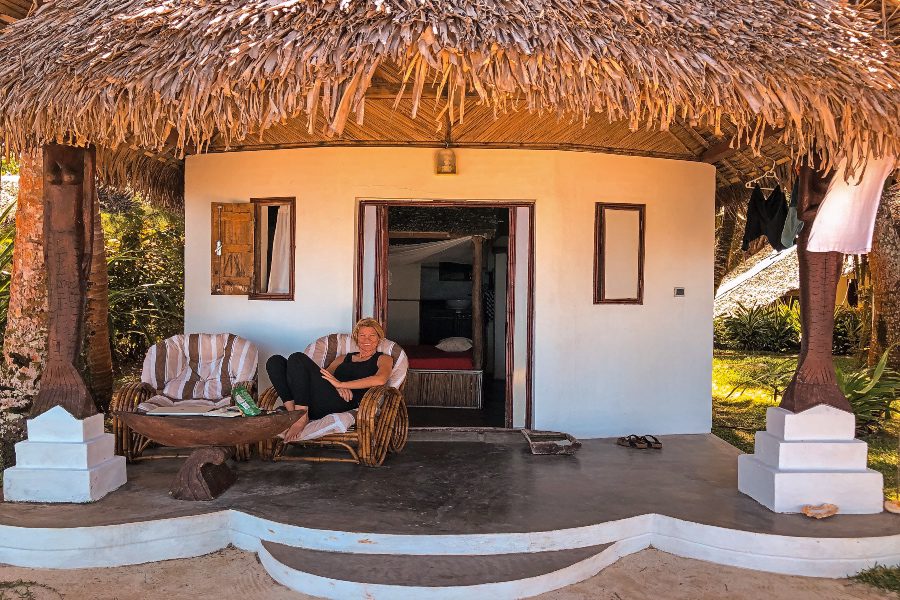
Day 11 – A day trip to Ile Aux Natte
We woke this morning and packed our large bags, checked out, and left them at reception. We flagged down a tuk-tuk to go to the small island of Ile Aux Natte today. The tuk-tuk drops us off around 4km away at the tip of our island.
Here you will find many small pirogue boats that take you across to Aux Nattes for Ar 4000 for a return trip. The island is literally a stone’s throw away – you can also walk or wade across here in low tide, but for a $1 return, it’s a fair deal.
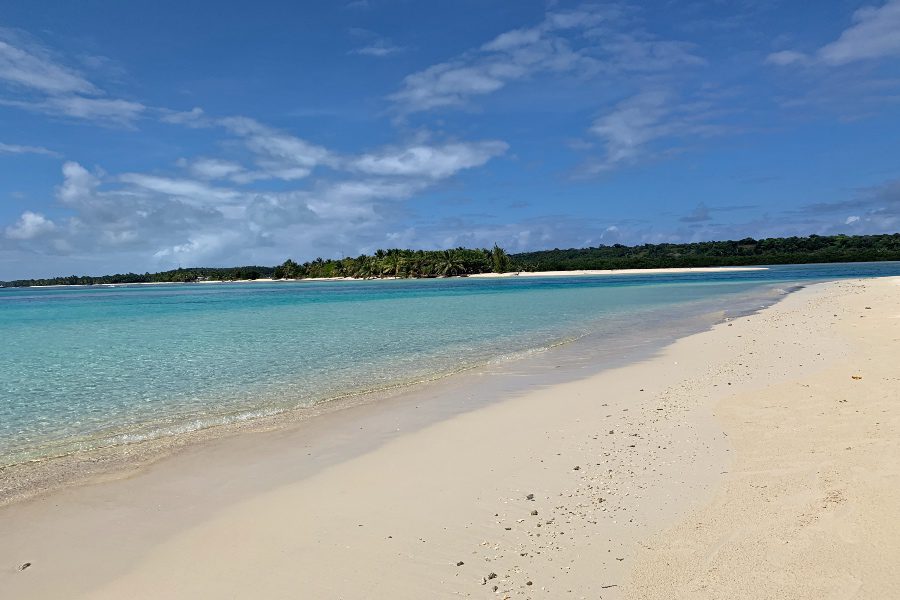
This island is very cute with a really beautiful beach to your right as you’re crossing over. In some parts, you can see that a recent cyclone has hit as some places are cleaning up.
Again, there are a number of good accommodation options for very affordable prices. The most popular options here are:
Baboo Village – A beautiful resort from $27 p/night. They offer a delicious breakfast for $5 and this is the perfect place to relax and get away from it all.
Residence Monique – Beachfront accommodation from $30 p/night.

We walked around the island today, then relaxed and swam in the gorgeous blue water. Later in the afternoon, we caught a pirogue across the water, and negotiated a price of Ar 20,000 for a tuk-tuk to return to Club Paradise to pick up our bags and drop us 10km away in Ile Sainte- Marie town.
The reason we are moving to town and staying the night here is that we needed to check in for our ferry at 04:00 am the following morning and our original hotel is too far. We didn’t want to risk something going wrong at that time in the morning and we needed to be on that boat transfer.
We checked in Hotel Freddy – This place is located two streets back from the main street of Ile Sainte-Marie and only a 7 min walk to the boat port. The rooms are very clean with good beds and a hot water shower for Ar 40,000 p/night. A good deal. We dropped our bags and went to explore the town.
There are a few markets and restaurants where you can get local or Western food. We saw ladies setting up street food on the side of the road, so we decided to try some. We ate small plates of simple noodles with vegetables, mashed potato and mayonnaise (for Ar 500 or 0.15 cents a plate), and some fresh zebu brochettes (small skewers of meat that the lady grills when you order it). These were Ar 400 per piece.
We ordered a cold beer at one of the restaurants/bars on the main road and used their wifi for a while before we returned to our hotel for an early night.
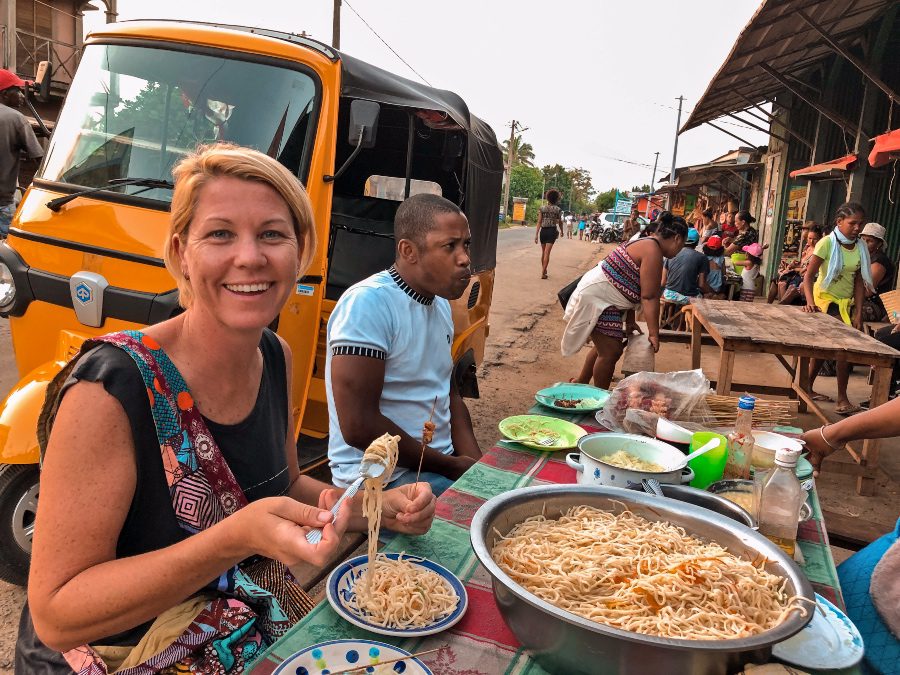
Day 12 – Ile Sainte Marie to Tamatave
We woke up at 3.45 am, then walked down to the port to check in for the boat. It’s already quite busy at this time of the morning. The boat is booked for a 4.30 am departure, we sailed at about 05:00 am. This time the crossing took 1 hr 45 min.
On the other side, we were informed that the half-sized comfortable bus we arrived on had a problem with the brakes, so this vehicle wasn’t working. Instead, we were squashed into quite possibly the oldest and rustiest minivan in Madagascar. Both of us, plus the other 22 passengers. The van had no suspension, no padding on the seats and surprisingly, the windows didn’t open so it was stifling hot.
The next 6 hours driving back to Tamatave on the bumpiest road in the country. We arrived at Tamatave at 1.15 pm.
Our initial plan was to continue on further and try to get to Andisabe National Park today, but it just wasn’t to be. Today was one of those days when you just can’t catch a break. Our visit to Madagascar in two weeks was getting a little tiring from all those early mornings and long drive days.
We searched for another ride to Andisabe or Tana (to get off halfway), but Cotisse Transport was booked out today and all of tomorrow.*sigh*
After asking around, we learned that all of the shared taxis going in that direction weren’t leaving until evening. We walked around in the shared taxi area of Tamatave in the scorching weather, dust, and rubbish for a while. A cycle driver walked us to a small place close to the Cotisse Transport office. Here we spoke to the lady here who said that their van departs for Andisabe today at 6.00 pm.
We booked two seats and decided we needed lunch and a drink, so we took a tuk-tuk to La Terrasse for food. We sat here for a few hours using their wifi and planning our last few days in Madagascar. At 5.45 pm, we returned to catch our van to Andisabe for the 6 pm departure. There was very little movement here. No passengers filling up the van and no sign of it beginning to load with luggage.
This wasn’t a good sign and we knew exactly what was happening here. We got very used to being told these little white lies from our travels in West Africa . This van would depart when enough people arrive to fill it.
We asked the woman in charge why it wasn’t departing at 6.00 pm, then she claims it will leave at 6.30 pm. Then at 6.30 pm and with no movement, we ask her again, and she says maybe 7.00 pm.
We explained to her that we needed to leave earlier and close to 7.00 pm, we requested our money back as we had to try and catch another form of transport that might actually depart in the next hour or so.
She didn’t like this much, but after some more explanation, she returned our cash.
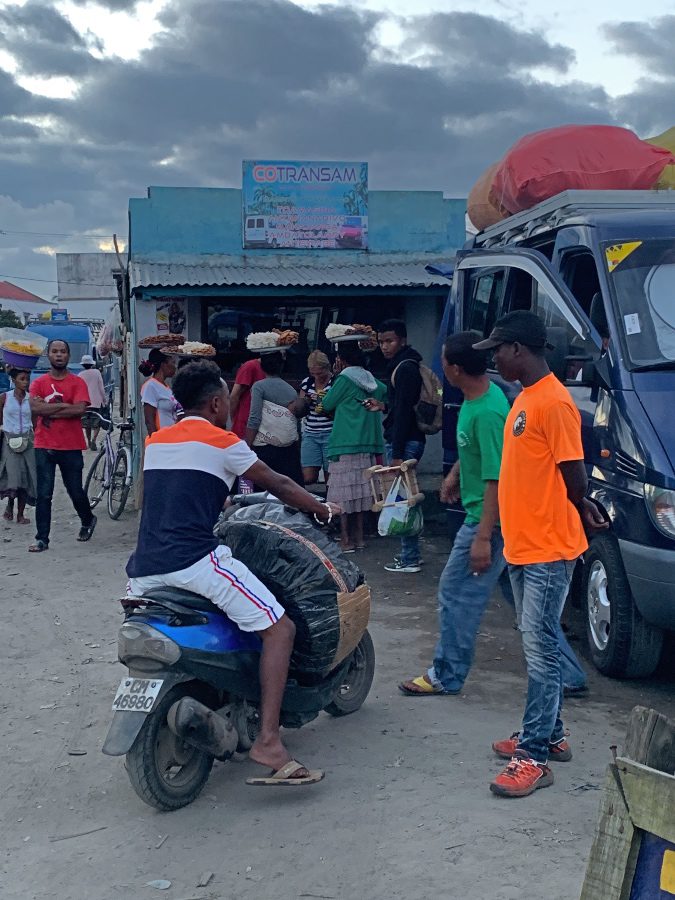
- 🔥 Hot Tip: Book accommodation on Booking.com
- 🎟 Book your tickets online: We use Viator and GetYourGuide
- 🔋 Stay charged: This Belkin Power Bank is essential!
- 📸 Join a Group Tour: View our tours OR search Tourradar
- ✅ Get Connected with eSIM: Easy and affordable! View eSIM
We ran around the corner to the Cotisse Transport office to check if there were any no-show passengers to Tana. We thought it was a chance that two passengers didn’t show. No, the van was full.
After walking around in dark asking if any vans were departing now and everybody giving us random information, we decided we had been defeated. We hailed a tuk-tuk and returned to Java Hotel .
This had been one of the toughest days of travel in Madagascar and we needed a clean and comfortable room to wash the day off and get some rest. The plan was to wake up very early again to return to the taxi station to try and get a ride to Andisabe tomorrow morning.
Want to share the experience? View Group Tours & Trips in Madagascar
Day 13 – Tamatave to Andasibe National Park
We woke at 07:00 am, checked out soon after, and caught a passing tuk-tuk (price is Ar 1000 per person for any ride within the town) to the taxi-brousse station. We were directed to a small office called coTrans in the middle of the chaos that is the taxi-brousse station.
They offer good, reliable sprinter vans to Moramanga (the town is 25km after the turnoff for Andasibes National park, so it’s cheapest to take this route/van).
We arrived around 08:00 am and the lady here said departure for this van is at 8.30 am. The price would be Ar 15,000 each. Great, we thought, but in reality, we should have known better that it wouldn’t leave at this time after our experience last night. We were right, it didn’t. We eventually left around 10.00 am, which wasn’t too bad.
This route has many bad roads and lots of trucks. We arrived at the small turn-off for Andasibes National Park at 4.30 pm, we told our driver earlier that we’d like to get off there.
It’s only a 5 min walk down the road, and you’ll see a few budget hotels right there. Popular choices for many travellers are Maria Guesthouse and Hotel Luc.
We stayed in Feon Ny Ala Hote l. They offer basic bungalows for Ar 50,000 per night and a range of nicer bungalows depending on what you want to pay. It looks like all the tour groups and Europeans stayed here as it was quite busy, yet it was well organised.
If you’d prefer to stay in something a little nicer, I’d recommend this property – Andasibe Lemur’s Lodge. Great service, fantastic food, and very comfortable rooms.

Day 14 – Andasibe National Park
This morning we woke at 07:00 am and we could already hear the call of the Indri (the largest lemurs in Madagascar).
We checked out and ate an average breakfast at our hotel before leaving our bags at reception whilst we went to the park. We walked along the road, about 15 min or 1.5 km to the National Park. It’s busy with people and small groups at this time of the morning.
A guide is compulsory inside the park, so if one approaches you outside (and providing they can speak your language), bring them with you inside to purchase tickets to enter. You’ll need a guide with you to do so, the prices are set.
It’s very busy in the mornings here and there doesn’t seem to be enough guides to fulfill the number of people entering the park, so take a guide when they approach you.
The entrance fee is Ar 45,000 each. Guide for 2 people costs Ar 40,000 total (which you must pay to your guide directly). The price is a bit cheaper if your group is a little larger.
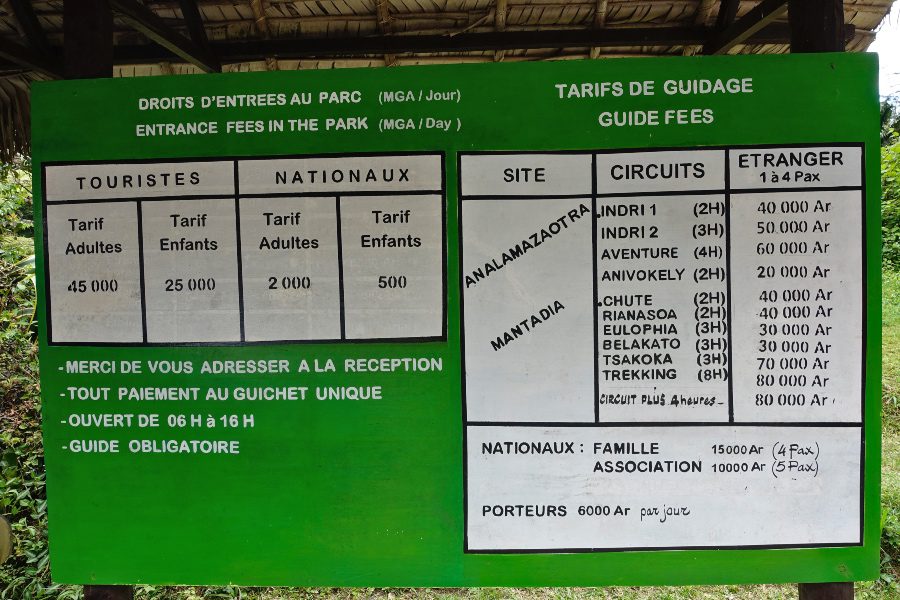
You can choose the circuit that you’d like to do, prices are based on this. We chose the Indri 2 circuit which is about 3 hours long.
Inside the park, we saw three different species of lemurs over the next couple of hours. The Indri lemur, some common brown lemurs with babies, and the Diademed Safika (otherwise known as the dancing lemur).
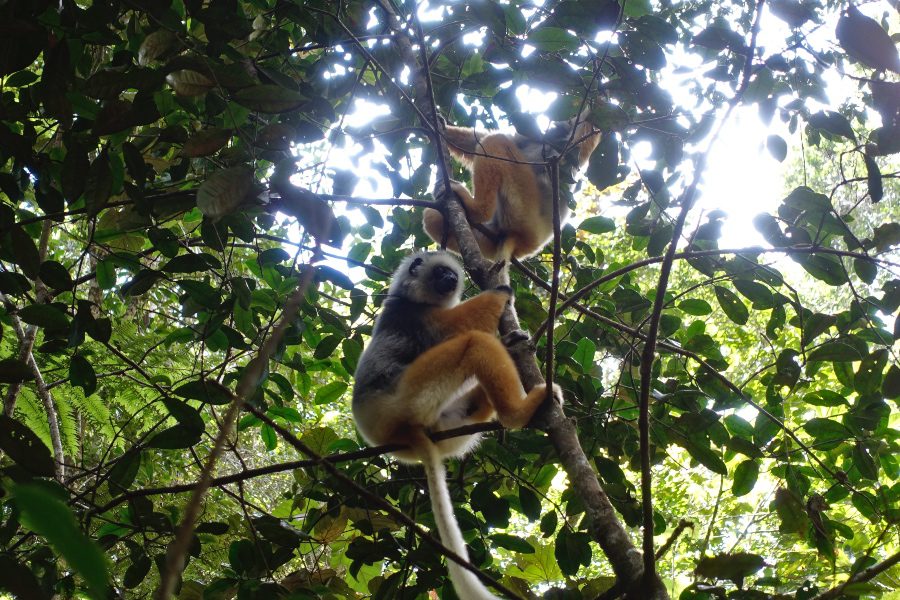
After our tour finished, we walked back to our hotel, collected our backpacks and made our way to the intersection to try and catch a passing van to take us to Antananarivo. The timing was perfect as it was midday and many vans and vehicles were here taking a break for lunch.
After asking around for 15 minutes, we found a nice Sprinter van with two spare seats available, heading directly to Tana. We agreed to pay the driver Ar 10,000 each and we managed to get two of the best seats in the van, right behind the driver.
Only 3.5 hours later, we arrived at Tana. The minivan stopped at a random outdoor bus station and we had to take a taxi from here to our hotel.
We wanted something a little more comfortable for our final two nights in Tana, so we booked a room at Le Manoir .
The rooms are from USD 55, it’s lovely, and it’s in a good location close to the city.
Day 15 – Antananarivo
Today we explored more of Tana. It’s only a 10-15 min walk into the city from our hotel . We stopped at a bakery for coffee and some delicious pastries.
We returned home before dark after exploring the city and some ramen noodles for lunch.
We also recommend this Walking Tour of Antananarivo with a Local.
Day 16 – Departure
We left Tana this morning on an early flight to Mauritius. The taxi to the airport was Ar 50,000 at 04.00 am.
Travel Insurance for Madagascar in two weeks
Make sure you get Travel Insurance before hitting the road. We recommend Heymondo & SafetyWing
Click here and get 5% off Heymondo from us!
If you’re keen to travel West & Central Africa, then it’s worth reading these 17 ESSENTIAL Things to know before travelling to West Africa.
We spent a great deal of time travelling overland in this region on Africa on our journey to visit EVERY country in the world . (We completed our goal in Nov 2022 – read more about it in this article from CNN ).
Honestly, this was one of the most challenging regions of the world to travel independently – but we’ve got some amazing memories.
Travel Tips for Africa
We have many travel guides and tips for Africa – what a massive continent!
Have you ever wondered how many countries in Africa there are? 54 or 55? We cover them in depth in our ultimate Africa bucket list.
There is some delicious cuisine to be enjoyed across Africa, and these ten best African countries for food will inspire your food journey.
Check out how many of these 15 most popular foods you can taste.
If you’re wondering what they eat for breakfast in Africa, check out these 20 popular breakfast foods.
For food lovers, our Food Map of AFRICA lists the quintessential dish you need to eat in every nation!
It’s worth reading these 17 ESSENTIAL Things to know before travelling to West Africa , and our packing list for Africa may be helpful to you.
Don’t miss our recap of our travels across West Africa for even more helpful tips, and try these popular West African dishes ; they’re fantastic!
You’ll need to stay connected while travelling in Africa. We recommend eSIM. It’s easy, reliable and affordable. View eSIMs for individual countries in Africa, or consider a regional eSIM for Africa (which covers 36 countries)
If your travels in Africa are part of a much larger global adventure, then a Global eSIM may be the answer. It connects you in 124 countries, offering data-only eSIM and data/call/text Global eSIM. This eSIM has been a game-changer for us, and we couldn’t imagine travelling without it now.
If you want to travel with like-minded travellers, consider joining a group tour. Check out our Group Tours first for any upcoming departures in Africa, or view Tourradar for deals on group tours in Africa .
Check out our best-ever travel tips compiled from more than twenty years of experience.
Travel Planning Resources
✈️ Flights : We use Skyscanner to book cheap flights worldwide.
🏨 Accommodation : Booking.com is our preferred platform for booking hotels and accommodation. We use Vrbo to book apartments and long-term stays.
🏥 Travel Insurance : We recommend Heymondo ( Get 5% off Heymondo) & SafetyWing
🚌 Transportation : Trainline is the best website to reserve trains. We use Omio to book transport worldwide. For travel in Asia, we use 12Go.
🚘 Car Rental : We use DiscoverCars to book rental cars worldwide.
👫 Group Tours : We now offer Group Trips; check them out here . Alternatively, we recommend G Adventures OR Tourradar .
📸 Day Tours & Trips : GetYourGuide & Viator are the only two platforms you need.
📚 Lonely Planet: The Best Range of Travel Guides & Ebooks , and FREE Shipping! (use code RACHELDAVEY10 for a 10% discount)
🎒 Luggage : Osprey Farpoint 40L Backpack or Samsonite Luggage Range.
🛄 What to Pack: Don’t forget your Universal charger and a good power bank . To help you pack the essentials, here is our ULTIMATE Packing List for all Travellers .
🐶 Become a House Sitter: Join Trusted Housesitters and enjoy FREE accommodation worldwide. Use our invite to receive 25% off your new membership.
💰 Send Money Anywhere: WISE & Revolut are the best online accounts that let you send money, get paid, and spend money internationally. Both are so easy to use and way cheaper than any bank transfer.
📶 Stay Connected: Airalo eSIM allows you to get connected the moment you land at your destination, and you can avoid those expensive data roaming charges. We LOVE this product! Use promo code NOMAD15 for 15% off ALL eSIMs (new Airalo users only) OR use NOMAD10 for 10% off ALL eSIMs (for existing Airalo users)
✅ Check out our Travel Gear and Travel Resources for more valuable tips to save you money!
Tasty Food Adventures
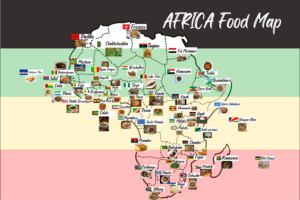
AFRICA Food Map – African Food Guide to 54 Countries

What To Eat In Marrakech (and what to avoid) 2024
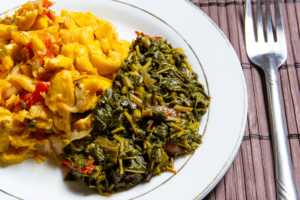
10 Popular Foods From Dominica
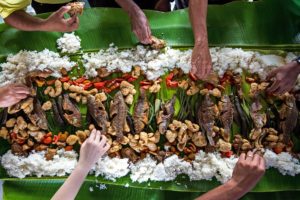
Food in the Philippines – 10 Most Popular Filipino Dishes
See all Food Adventure blogs
Expert Travel Guides
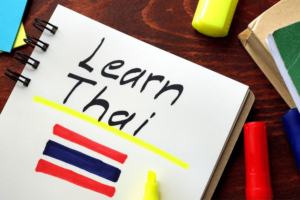
Basic Thailand Expressions To Impress The Locals (2024)
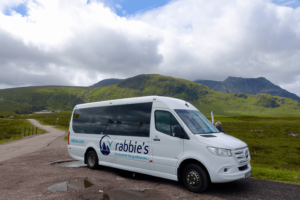
Scotland Tours Rabbies Review – Best Tours to Scotland?
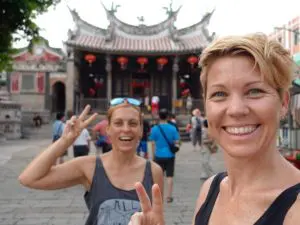
Why You Should Visit Taiwan Islands – 5 Travel Vlogs to Inspire!
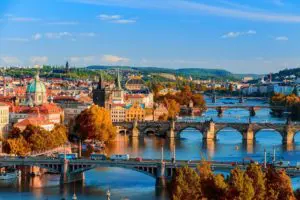
The Perfect 2 Days in Prague Itinerary
See all our Travel Guides
Trusted Hints & Tips

How to Avoid 6 Common Tourist Scams in China
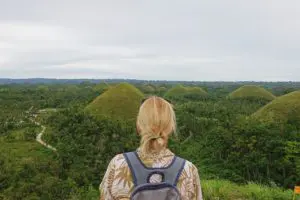
20 Signs You’re Addicted To Travel – How Many Apply To You?

Portable Coffee Machine – Our Essential Travel Gadget (2024)

How to Send the Cheapest International Money Transfers
See all our expert Hints & Tips
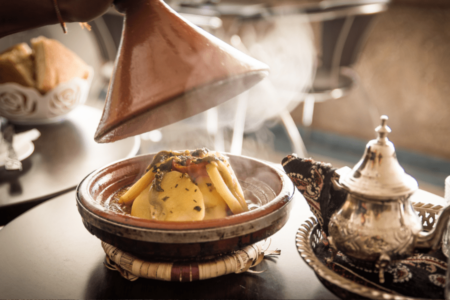
African Food Guide – 10 Best Food Countries in AFRICA
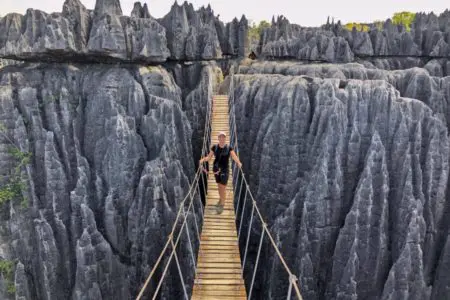
How to Get to Tsingy National Park (2024)
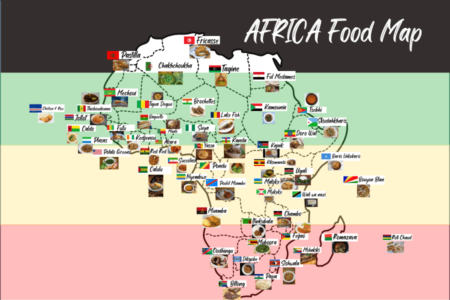
7 Comments . Leave new
What a great piece, so thorough and fun! Seems like you had a wonderful time in those two weeks, I’m inspired to plan my next trip to Madagascar. Happy travelling! 🙂
Thanks, we’re glad you enjoyed it. You’re going to love Madagascar! A beautiful country with some of the nicest people we’ve met in Africa 😉
Thank you very much for the information you shared here with us – travellers planning Madagascar in 2020 🙂 Just a question: when did you visit Madagascar. I didn´t find the month of your trip. Thank you!
Thanks for your comments, Martina. We travelled to Madagascar in November 2019. I’ve updated our post with this info now. Thank you 😉
Hi Rach, I’m looking to do something similar to your trip but with an 8 year old ( and my husband) do you have any thoughts on travelling with a child in Madagascar? Also do you have a rough daily budget? Thank you 🙂
As you could probably tell from our blog post, we really loved Madagascar. The thing we didn’t really love so much was the amount of time we had to spend on public buses, vans etc to get around. We experienced many 12-14 hr journeys on super hot days just getting to the next destination, even for us as adventurous adults – it was tiring at times. If you’re taking your 8-year-old, I’d recommend hiring a private local driver with a 4WD/car to get you around quickly and more comfortable to maximise your time. The going rate is about USD 65 per day (+ fuel) and you could easily find a driver once you arrive in the country (possibly through one of the accommodation places I’ve mentioned).
As for our budget (using public transport and as per the details in the blog), our expenses came in at just under USD $1000 total for two people in 16 days. Incl transport, accommodation, food, activities etc. This also incl our private trip to Tsingy National Park.
Hope this info helps you out 😉
Thank you so much! That is really thorough and very much appreciated!Really enjoying your blog!Happy travels.
Leave a Reply Cancel reply
Your email address will not be published. Required fields are marked *
Post Comment
- Skip to primary navigation
- Skip to main content
- Skip to primary sidebar
- Skip to footer
TravelAwaits
Our mission is to serve the 50+ traveler who's ready to cross a few items off their bucket list.
18 Things I Wish I’d Known Before Visiting Madagascar

Kelly Hayes-Raitt
- Activities and Interests
- Bucket List Trips
- Destinations
- History and Culture
- Types of Travel
For many, Madagascar is a bucket-list destination. An island isolated off the east coast of Africa, 90 percent of its wildlife is found nowhere else on earth. But it’s the cherub-faced lemurs that beckon most tourists to this far-flung destination.
With tourism up 19 percent in the first half of 2019 over the previous year, I thought planning my recent trip would be relatively easy.
However, I was overwhelmed by the many options. Initially, I went through a few of the international tour companies, but I found their non-transparent pricing and communication delays quite frustrating.
Next, I went straight to the on-the-ground guides to avoid the middle-man costs. I scoured Trip Advisor for recommendations and found four guides, all of whom responded to my emails within 24 hours. I chose Arsene from Tour Guide Lovemada , as he responded the fastest and adjusted his proposed itinerary to my interests.
Here’s what I learned are important considerations.

1. Choose Your Guide Wisely
You will need a driver, even if you rent a car. (Car rental companies require you to hire a driver — and you will be glad you did once you see the roads!) Choose a guide who speaks your native language well, is comfortable with translating, is certified as a guide by the Malagasy government, has first aid training, reflects your stated limitations and interests in his recommendations, responds quickly and thoroughly to your emails, has transparent pricing, and drives well!
2. Realize Madagascar Is A Huge Country
It looks tiny perched there in the Indian Ocean next to Africa, but Madagascar is as big as Texas, and much longer from north to south. Compounding that, it’s a volcanic island with dramatic peaks and very winding roads, so getting from destination to destination involves long, arduous drives. And the roads aren’t great: Less than 20 percent of the country’s roads are paved . Let your tour operator know ahead of time if you are prone to car sickness. You might want to confine your trip to one region. Madagascar has much to offer in every part!

3. Communicate Your Interests To Your Tour Operator
Many tours involve moving tourists from national park to national park to hike and spot lemurs. This type of itinerary may involve 6- or 7-hour car rides. I wanted to avoid that — and I also wanted to spend more time in villages meeting people than in forests hiking and lemur-searching. I was rewarded: My guide arranged two overnights in small villages, which were definite highlights!
4. Recognize Your Limits
Madagascar is a challenging country and can offer a variety of boundary-pushing experiences, both physical and cultural. For example, I was scheduled to hike down a high volcanic mountain to a remote village and spend the night. While I was excited about the cultural opportunity, I couldn’t handle the physical climbing and had to beg off. (I was a bit embarrassed, as a 68-year-old village woman followed me, wearing only flip-flops, and scampered over the rocky path like a mountain goat! I was practically on my hands and knees.)
On the other hand, spending the night in a village with no running water or electricity and communicating with the local women provided a welcome challenge: What common references could I find with women who had never seen a movie or read a book and knew almost nothing about the United States? With my guide translating, I asked about their children and their dreams for their daughters. I asked about their impressions of America and what questions they had for me. They wanted to know how I intend to care for myself as I age, since I have no husband or children. They sincerely invited me to live with them in their village, where I’d be cared for in my senior years.

5. Schedule A Trip To A Major Grocery Store Your First Morning
Big grocery stores are found only in Antananarivo, Madagascar’s capital. Stock up on bottled water from a major company (not the national water company, Jirama, which bottles water that is unsafe for foreigners). Pick up wine, if that’s what you drink. (Beer, rum, and vodka are available throughout the countryside.) You might also stock up on shampoo and conditioner, as many of the hotels don’t offer these amenities, munchies for the car rides, and toilet paper for pit stops.
6. Don’t Schedule Your Departing International Flight On The Heels Of A Local Flight
The domestic airlines, Air Madagascar, known as “Air Maybe” by the locals, and Tsradia, its new spin-off, have notorious reputations. My Tsaradia flight time was changed to depart two hours later than scheduled, then took off two hours later than that! Avoid a lot of internal flying if you want to avoid losing travel days to flight delays.

7. Carry A Lot Of Small Bills
Nearly every place you visit will require you to hire a local guide in addition to paying the entrance fee for the park or attraction. The local guides cost 20,000 to 80,000 Ariary. (20,000 Ariary is about $5 or €5). They don’t give change. You can break larger bills in restaurants or at the hotels.
8. Calculate The ATM Limitations
I used my ATM card in the larger cities to get local currency. But be careful! Banks charge a fee for every transaction, regardless of amount withdrawn. BNI Bank limits withdrawals to 400,000 Ariary, whereas BFV Bank’s limit is twice that for roughly the same fee. Credit cards are not widely accepted. Euros are accepted for payments at many hotels.

9. Bring Anti-Diarrheal Medications
Although you can get Flagyl and a few other antibiotics in pharmacies in larger cities, the rural areas have few clinics and pharmacies. Also bring a laxative! Every meal is served with rice and that can wreak havoc on intestines used to a more Western diet.
10. Prepare To Pick Up After Yourself
Note that hotel rooms are not necessarily cleaned daily (unless you specifically request it) when you stay multiple nights.

11. Check Temperatures Of Your Specific Destinations
During my 10-day guided trip, I went from hot-hot to sleeping in my sweats under two heavy quilts. Madagascar’s coasts have a tropical climate, its mountains and high plateaus are chillier and more temperate, and its south has an arid climate.
12. Check Altitudes If You Are Prone To Altitude Sickness
The average elevation is higher than 2,000 feet above sea level, with its highest point ascending to 9,500 feet at Maromokotro in the northern part of the country. Prepare for altitude sickness by packing appropriate medication.

13. Ask Your Tour Guide For Hotel Recommendations
I wanted to book my own hotels through Booking.com, and I’m glad I read the reviews and consulted my guide before booking. The hotels the guides recommend are safe and up to Western-style standards. They also offer free rooms and meals for the guides, which keeps your costs down. I was quite comfortable in hotels in the $20 to $30 USD a night range. They were clean and had strong, plentiful hot water, Western-style toilets, Wi-Fi and good, on-site restaurants. I thought I was saving money booking my own hotels. But had I asked, my guide would have booked all my rooms at no extra charge.
14. Stay Connected!
Check your data plan before you leave and increase it if necessary. I had telephone connection throughout my trip, so I was able to use my data allowance to post on Facebook during the long car rides. Every hotel I stayed in had decent Wi-Fi. Everyone uses WhatsApp. Be sure to bring all the types of phone chargers you have so you can recharge in the car, as well as at the hotel. You’ll need your phone as a flashlight, too, in some of the villages where there is no electricity.

15. Research Your Anti-Malaria Medication Carefully…
And don’t wait until the last minute! Some areas of Africa, including Madagascar, have mosquitoes that are resistant to chloroquine, one of the more common antimalarial medications. Mefloquine, a formerly common antimalarial, has been linked to hallucinations and is difficult to find. Additionally, not all antimalarials are available everywhere. Your pharmacy might need a few weeks to order your desired medication, and you may have to start taking the medication a week or two before you arrive in Madagascar.
16. Budget For Gifts
Madagascar is one of the world’s poorest countries, with 75 percent of its people living on less than $2 per day according to the World Bank. My tour guide recommended that I bring small gifts, such as volleyballs, to the villages where I stayed. These gifts were inexpensive and available, but I was glad I had extra cash, too. And the smiles on the children’s faces were priceless!

17. Consider Volunteering
There are many inspiring opportunities to volunteer in Madagascar. I spent my first week helping Nosy Be Conservation regenerate corals on an island in the northwest corner of Madagascar. My volunteer assignment took me into the water nearly every day to clean the artificial reefs or to gather broken coral that could be transplanted onto existing coral. It was a challenging and soul-satisfying way to give back to this amazing country!
18. Most Importantly, Pack Your Sense Of Humor And Flexibility
Part of the excitement of traveling in Madagascar is the last-minute opportunity to experience the rare and unexpected. My guide, knowing of my interest in seeing an exhumation celebration , scrapped our scheduled itinerary one afternoon so we could join a local community’s exhumation ceremony. What we didn’t realize is that it would take us over an hour of driving over some very rutted and dusty roads to reach the celebration. It took a lot of patience and perseverance to get there, but it was worth it!
Want more bucket-list trip advice? How about planning a girls trip to Machu Picchu: what to know before you go ?

Kelly Hayes-Raitt jokes she sleeps around – usually with animals. As an international petsitter, she’s been traveling full-time for more than a decade. She coaches authors and has written the book How to Become a Housesitter: Insider Tips from the HouseSit Diva , available in soft cover or Kindle at Amazon or as an ebook from her web site, HouseSitDiva .

10 things you need to know before your trip to Madagascar
- annetravelfoodie on January 10, 2019
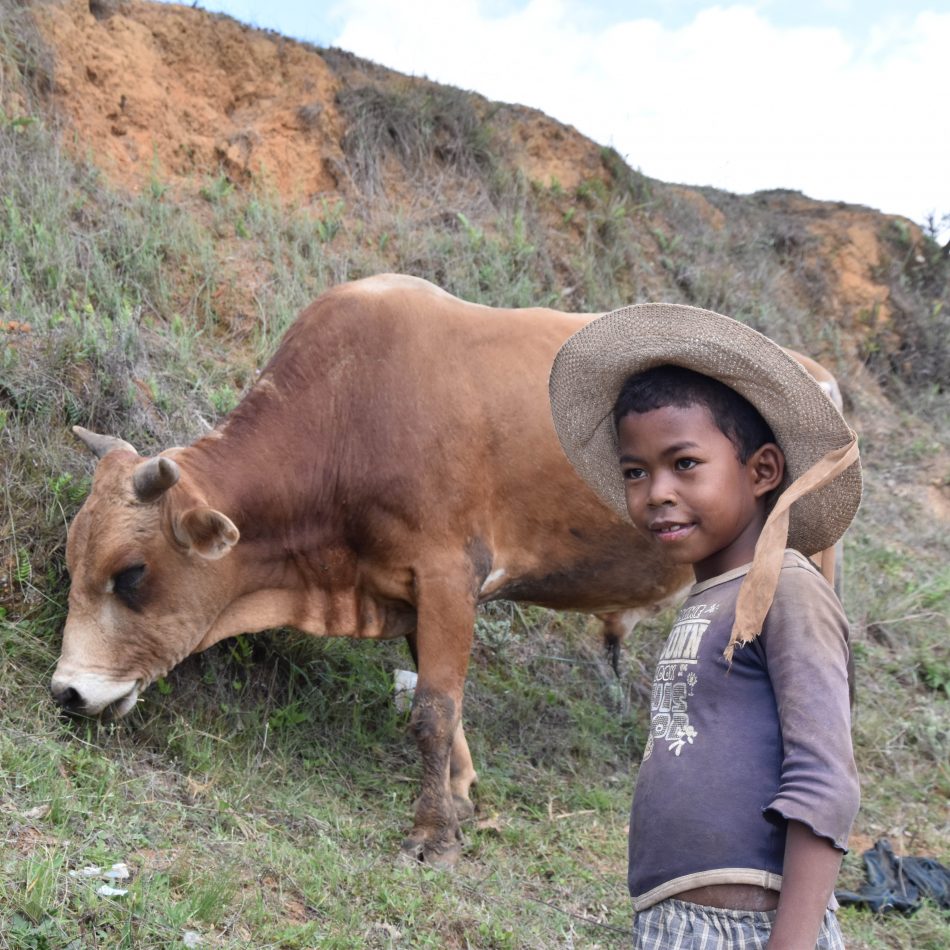
Madagascar is a country that isn’t very touristic. It makes it a great country to visit for more experienced and/or adventurous travellers. I’ve visited over 60 countries and I’m always looking for new countries to explore. To me it didn’t feel like a big deal to travel to Madagascar , but now that I’ve been there I wish I prepared myself a bit better to this trip. So to help you out I’ve made this list with 10 things you need to know before your trip to Madagascar. With these tips you’re better prepared than I was and I’m sure you’ll have a great time on this beautiful African island.
1 Visa A Visa is required for all travelers visiting Madagascar, even if it’s only for a short period of time. You can buy your visa at the airport or arrange it beforehand in your home country. Arranging it beforehand at the embassy is quite expensive, but it’ll give you peace of mind to know that you’re allowed in to the country. Buying your visa to Madagascar at the airport is also possible. You’ll have to cue and officially you could be denied entry but I don’t think that’s very likely for tourists. For both options you’ll need a return ticket, a passport that’s valid for at least another 6 months and a passport picture.
2 Malaria The entire island of Madagascar is a high risk area for Malaria. In the pharmacies in the bigger cities in Madagascar you can buy Malaria pills called Malaron. Unfortunately the side effects of Malaron are severe. It helps to take them in the evening rather than the morning because the heat of the sun will increase the side effects. But even if you take them at night you might get noxious or get diarrhea from the Malaron. For us the side effects were that severe, that we decided to stop taking the Malaria pills. Now I don’t want to bring you into any danger, so I’m not saying this was the wisest choice to make. We did however always covered up in anti-mosqito repellant. Make sure you use the ones with DEET, it might be smart to buy them at home before you leave.
3 Healthcare It’s recommended that you have the standard vaccins before your trip to Madagascar, but Hepatitis A especially.
As you might suspect, personal hygiene can be a problem in Madagascar. The biggest health problem, for the locals as well as the tourists is diarrhea. You’ll most likely get it from unclean water. You can use the following precautions: * always wash your hands with soap, water alone is not enough * never drink tap-water, not even from high-end hotels. * dry your hands with paper, not with a towel that’s been used by many people * avoid ice cubes * only eat fruit that can be pealed * watch out with meat, especially from street vendors
You can buy Imonium at most of the pharmacies in the bigger cities in Madagascar that might help a bit with your stool. Take one pil after each loose stool.
4 Money The local currency in Madagascar is Ariary. When I was there the exchange rate was 4000 Airiary for 1 Euro. Important to know is that you can’t pay with your bankcard/debitcard anywhere in Madagascar. Some bigger hotels and restaurants accept credit card payments but there are no ATMs where you can get money with your bankcard. A credit card is a must in Madagascar! Most banks only accept Visa but the IBN bank (white with green logo) accepts Mastercard as well. You can find an IBN bank in the bigger cities. Always make sure you have enough cash on you as you’d be surprised at how few places you can pay with card. Some big hotels or rental car agencies might accept euros as well. At the airport there are 2 ATM’s in the arrival hall, one where you can get money with Visa and one for Mastercard.
5 Transportation The roads in Madagascar are very bad. There’s one main highway; the RN7 that goes from the capital city Antananarivo to Tulear in the South-West. But even that one is often in bad shape. If you’re short on time (say 10 to 16 days), I’d advise you to just this RN7 highway. It’ll give you a chance to see quite a lot from what the country has to offer in a reasonable amount of time. The best way to do it is to rent a car, we did this as well. Most car-rental agencies will only rent a car including a driver. Although it felt weird for me in the beginning, in retrospect I’m very happy that we did this. We rented our car with Europcar and paid for it in cash Euros. We arranged it online beforehand so we knew we had to bring enough. The advantages of a driver is that he knows the way, he knows the good hotels, he knows local guides that he can call beforehand to guide you in National Parks, it’s less tiring if you don’t have to drive yourself and it gives you a save feeling.
Are you more adventurous? You can also take the local busses ‘bouse bouse’. Don’t expect too much from them though; they’re small vans made to seat about 10 people but often used by 20 at the same time. You’ll often see them on the road, packed with people inside and hanging out and packed with luggage, food and even live animals on the roof. The busses break down frequently and as you can imagine are not very comfortable.
Keep in mind that Madagascar is a very big island (it’s the size of France and Belgium combined), so calculate enough time for driving from one place to another. Also add about 25% to the time that Google maps will tell you and don’t plan your schedule to tight. There are always things that can happen like car trouble, animals on the road or not being able to bypass a slow truck.
6 Language The official language of Madagascar is French, as it was once its colony. But the majority of the inhabitants speak Malagay. This language originated in South-East Asia rather than Africa. It rewards to learn some basic words like ‘Salama’ for hello. Only the educated people speak French. In the tourist industry and hotels everyone will speak good French, but the people in the villages will have difficulties speaking and understanding it. Only very few people speak English. Only the ones who studied either English or tourism. Most of the guides for the national parks do speak good English, although you’ll notice sometimes that they only studied their lines and find it difficult to differ from their text.
7 Poverty Madagascar is one of the poorest countries in the world. As a matter of fact it’s listed number 11 in the world poverty ranking. 92% of the population lives below the poverty border. In Antananarivo you might not notice it, but you’ll definitely see it when you’re travelling outside the capital cities. It’s really helpful to see if there’s anything you can bring with you for them. Maybe some clothes that you’re not wearing anymore or toys for the children. They often don’t even have a simple ball to play with.
You’re practically guaranteed to see lemurs if you visit 2 or 3 national parks during your trip.
9 Electricity and internet The majority of the population of Madagascar, especially those who don’t live in cities, don’t have access to electricity. The hotels do, so you probably won’t have a problem charging your elektronical devices. Although it could be that there’s only one power outlet in your room. In remote areas the power is often only switched on from 6pm to midnight. So recharge your phone and cameras whenever you can. It’s also wise to bring an adapter so you can charge your phone from the cigarette lighter in the car.
Most hotels offer WIFI, but often only in the reception area. If the WIFI is working, you’ll have a very fast connection, especially in the cities. We however have experienced quite a few times that the WIFI wasn’t working, or only worked for a little while. Try not to be too depended from it.
10 Safety Although Madagascar is a relatively safe country to travel around in, there are some safety measures that you should take.
- Never drive after dark. Drivers will refuse to drive in the evenings and if you’re driving yourself, make sure you arrive at your destination before 7pm. There are violent attacks on cars at night sometimes.
- It’s also best not to walk on your own after dark. Use a taxi or pousse-pousse to take you to your restaurant or back to your hotel.
There have been some violent times in Madagascar, during political unstable periods. But tourists are never the target of this. We’ve were in Madagascar for 10 days we never felt unsafe.
Click here to read about our road trip to Madagascar and like my Facebook page to make sure you’re never missing out on a new travel blog.
I’ve created a 2 minute video with the highlights of our trip to Madagascar. You can watch it here.
Related Posts

Isalo National Park is the most visited national park of Madagascar. As Madagascar isn't very touristic, this biggest tourist attraction sees 'only' 3o.000 visitors a year. In comparison; over 6…

Anja Community Reserve, or Reserve d'Anja, is a relatively small park in Madagascar. Despite it's size, it's definitely worth a visit. The main attraction: the many ring-tailed lemurs that inhabit…
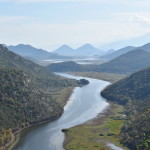
I just came back from a lovely road trip in Montenegro. My boyfriend and I flew to Podgorica and with a rental car we explored places like Kotor, Budva en…

Pingback: My trips of 2019 - Anne Travel Foodie
Leave a Comment Cancel reply
Your email address will not be published. Required fields are marked *
Don't Miss! random posts ..

- annetravelfoodie

Check out my Instagram account for new pictures every day!

- Australia and New Zealand
- North and South America
- Breakfast and lunch
- Healthy Dinner
- Healthy Sweets
- Special Occasions
- Sugar Sunday
- Restaurants
Cookies on GOV.UK
We use some essential cookies to make this website work.
We’d like to set additional cookies to understand how you use GOV.UK, remember your settings and improve government services.
We also use cookies set by other sites to help us deliver content from their services.
You have accepted additional cookies. You can change your cookie settings at any time.
You have rejected additional cookies. You can change your cookie settings at any time.
Warnings and insurance
Before you travel .
No travel can be guaranteed safe. Read all the advice in this guide. You may also find it helpful to:
- see general advice for women travellers
- read our guide on disability and travel abroad
- see general advice for LGBT+ travellers
- read about safety for solo and independent travel
- see advice on volunteering and adventure travel abroad
Travel insurance
If you choose to travel, research your destinations and get appropriate travel insurance . Insurance should cover your itinerary, planned activities and expenses in an emergency.
About FCDO travel advice
The Foreign, Commonwealth & Development Office ( FCDO ) provides advice about risks of travel to help you make informed decisions. Find out more about FCDO travel advice .
Follow and contact FCDO travel on Twitter , Facebook and Instagram . You can also sign up to get email notifications when this advice is updated.
Related content
Is this page useful.
- Yes this page is useful
- No this page is not useful
Help us improve GOV.UK
Don’t include personal or financial information like your National Insurance number or credit card details.
To help us improve GOV.UK, we’d like to know more about your visit today. Please fill in this survey (opens in a new tab) .
Madagascar Tours & Vacations

Madagascar showcases the very best of our wild, weird but oh so wonderful world.
With biodiversity to rival the Galapagos Islands, towns of historical significance, beautiful beaches of golden sand and a remarkable culture influenced by Europe, Africa and the East, Madagascar's rare riches are well worth discovering. Venture into national parks to experience profound moments in nature, mellow out on idyllic islands, stroll through heritage towns and spot quirky wildlife not found anywhere else on this earth.
Our Madagascar trips
Let's create an exclusive trip for your group.
Madagascar tour reviews
Filter by rating
Madagascar Baobabs & Beyond
Madagascar Adventure
Articles of Madagascar
Galapagos or Madagascar? Which unique destination should be at the top of your travel list?
8 reasons why your next adventure should be in Madagascar
9 alternative travel spots for 2018
Wellness Travel in Madagascar. It’s now a thing
Madagascar at a glance
Capital city.
Antananarivo
29.5 million
French, Malagasy
(GMT+03:00) Nairobi
CALLING CODE
Electricity.
Type C (European 2-pin) Type D (Old British 3-pin) Type E (French 2-pin, female earth) Type J (Swiss 3-pin) Type K (Danish 3-pin)
Learn more about Madagascar
Best time to visit.
With such a unique ecosystem and environment, going on holiday to Madagascar at different times of the year offers a variety of challenges and benefits. September to November is considered one of the best times to visit, as these months sit right in between the cool, dry winter and the hot, rainy season. This time is also considered the best time to view birdlife.
July to August offers cooler temperatures and the best chances for whale watching on the coast.
January to March is cyclone season, but this is also the best time to see flowering orchids.
Learn more about the best time to visit Madagascar.
Culture and customs
Madagascar is a relatively young nation with inhabitants only traced back 1,300 years. Throughout its history, multiple nations and peoples have influenced the culture and customs of modern-day Madagascar. While some of this history can only be speculated, it's known that much of it has come from Indonesian origins, alongside neighboring African and Arab cultures.
The official languages of Madagascar are Malagasy and French. French is still widely spoken across the country due to the nation being a former French colony.
Today, about 90% of the population identifies as Malagasy, further split into 20 ethnic groups. The largest of these groups is known as the Merina, who lived on the plateau. The country's religious practices are split between Christian and the traditional beliefs of the Malagasy people.
Geography and environment
This iconic island nation sitting off the coast of East Africa in the Indian Ocean, is home to one of the most precious and unique natural environments in the world. Its isolated location means that a distinct variety of animal and plant species have been able to thrive without outside genetic influences.
Possessing extinct volcanoes, hidden waterfalls, cool highlands, grassy plains, pristine beaches, and islands, Madagascar was once completely covered in forest - but due to high levels of deforestation, most forest cover has been lost. Some tracts of rainforest do endure today, but it's estimated that the current level of forest cover is only 1-2 percent of what it once was. Despite this loss, hundreds of species of plants and trees thrive all over the island, from huge, ancient baobab trees to thorny cacti and resplendent ferns.
Eating and drinking
Malagasy cuisine is highlighted by its fresh and tasty homegrown exotic produce alongside its unique local livestock, such as the zebu (a species of cow), and a variety of seafood. Many cultures across the world have contributed to the Malagasy cuisine of today including French, Indonesian, Indian, and nearby African nations.
Food to try in Madagascar
This national dish is made of cubed zebu meat (a local type of cow) and served with a light broth, tomato sauce, and rice. With all the bright colors, it resembles the Malagasy flag.
2. Henakisoa sy Ravitoto
This dish is made up of braised pork and pounded cassava leaves with an assortment of spices.
3. Malagasy chocolate
Because of the unique environment it's created in, Madagascan chocolate has a unique fruity, citrusy, and even forest flavor profile.
4.Henakisoa sy Amalona
One of the seven royal dishes, this traditional meal is made of pork and eel. While an unusual duo to most, this dish is a delicacy in Madagascar.
5.Tsaramaso Malagasy
A slow-cooked white bean and tomato dish cooked with zebu or pork as a stew.
Top things to do in Madagascar
Avenue of the baobabs.
Arguably one of Madagascar's most famous icons is the baobab tree. Walk under the towering trunks of the Adansonia Grandidieri variety, the tallest of the species, at the Avenue of the Baobabs found near the coastal town of Morondava.
Take a sunset stroll under these magnificent trees on our 11 days Madagascar Baobabs & Beyond tour.
Andasibe National Park
If you were hoping to see lemurs in Madagascar, Andasibe National Park is the place to be. Home to 11 species of lemur alongside many other native birds, reptiles, and frogs, the park feels alive with activity.
Enjoy Andasibe National Park by day and night on our 14 day Madagascar Adventure
The Small Tsingy and Great Tsingy
Come across the forest of rocks known as the Tsingys, roughly translated to ‘place where one cannot walk barefoot,' and you can definitely see why. Found in the Bemaraha National Park, these spiky natural limestone formations jut out from the ground. But don't worry; there are rope bridges to get you through.
Trek through and wander over the Big and Small Tsingy on our 24 day Madagascar in Depth adventure
Ranomafana National Park
A government-protected park, the Ranomafana is home to a huge variety of wildlife, from the world's smallest chameleon and striped civet to the famous golden bamboo lemur. Alongside the rare species, walk among stunning forestry and even some carnivorous plants.
Explore the Anja Community Reserve, Ranomafana, and Andasibe National Parks on a 14 day Madagascar Wildlife Adventure
Stop by the country's arts and crafts capital to see the beautiful creations handmade by the local people. See a woodcarver demonstration when you stop by a workshop to learn more about the region's crafts.
Meet the people and learn about their incredible craft during an Ambositra village visit when on our 24 day Madagascar in Depth tour
Chocolate making demonstration
Learn the secrets to the famous Madagascan chocolate during a hands-on demonstration class led by a local chef in Antananarivo.
What a perfect way to finish off your 14 day Madagascar Adventure than with a chocolate class.
Festivals and events
Public holidays that may impact travel:.
Martyrs' Day
Ascension Day
Whit Sunday
Whit Monday
Independence Day
Assumption Day
All Saints' Day
Please note Madagascar public holidays may vary.
Madagascar is popular around the world for its specialty produce items such as coffee, chocolate, and vanilla, but there are many other unique souvenirs to find while on the Great Red Island.
It's also a good idea to check with your local customs officials to ensure that you are able to bring certain items back into your home country. Australia and New Zealand generally have strict quarantine laws.
Things to buy in Madagascar
Vanilla is arguably one of the most famous exports to come out of Madagascar. Shop around for vanilla beans, paste, essence, and more.
Silk shawls (lambas)
Silk weaving is an important part of culture, especially in certain parts of Madagascar. In Sandrandahy villages, generations of mothers have passed the craft of making lambas to their daughters.
Wood carvings
Madagascan wood carvers are known for their woodwork. Find artwork, chess sets, wooden figures, and more.
Madagascan chocolate is shipped all over the world due to its rich and flavourful profile.
Just like chocolate, Madagascan coffee is world-famous and highly sought after.
Further reading
Similar destinations.
Thinking about a Madagascan adventure but still looking at other destinations? See below some of our wildlife-filled African destination tours .
Botswana Tours
Comoros Islands
Comoros Island Tours
- Tanzania Tours
- Galapagos or Madagascar?
Madagascar travel FAQs
Do i need a visa to travel to madagascar.
If you are visiting Madagascar as a tourist for over 15 days, you will need to purchase a visa. A 30 or 60 day tourist visa can be purchased at the Antananarivo airport on arrival. You may also be able to apply in advance at your nearest Madagascan Embassy.
You may be asked to provide evidence of onward travel or a return ticket.
If you are visiting Madagascar for less than 15 days, you may not need to purchase a visa, however, you will still need to pay a border control administration fee. If you wish to extend your tourist visa, you can apply to the immigration service to extend it for up to 90 days.
- 15 days or less: approximately 10 Euros (48,299 MGA)
- 30 day traveller visa: approximately 35 Euros (169,043 MGA)
- 60 day traveller visa: approximately 40 Euros (193,192 MGA)
The page is for general information only and may be subject to change. It is your responsibility to obtain relevant visa and travel information required for entry, departure, and travel to each country or region you visit on your trip. You should confirm these with the relevant embassies and/or consulates.
Last updated: 06/11/2023
Is tipping customary in Madagascar?
Tipping isn’t mandatory, but a little generosity will be received positively especially when considering the low wages that most service workers are typically paid. Setting aside a small amount for porters, guides and drivers is wise, as is leaving spare change or rounding up the bill at restaurants.
What is the internet access like in Madagascar?
Cyber cafes are found in some of the larger cities like Antsirabe, Fianarantsoa and Antananarivo. Smaller towns and remote areas will have far less access, so prepare to disconnect when traveling out of urban centers.
Can I use my cell phone while in Madagascar?
Cell phone coverage is generally good in Madagascar's large cities and towns, but less so in rural areas and on remote islands. Ensure you have global roaming activated before leaving home if you wish to use your phone.
What are the toilets like in Madagascar?
Squat/pit toilets are the standard in Madagascar except for western-style flushable toilets that are sometimes available in large hotels and other modern buildings. Carry your own supply of soap and toilet paper, as this is rarely provided.
Can I drink the water in Madagascar?
Drinking tap water isn't recommended in Madagascar. For environmental reasons, try to avoid buying bottled water. Fill a reusable water bottle or canteen with filtered water. Ask your leader where filtered water can be found, some hotels we stay in may have drinking water available. It's also advisable to avoid ice in drinks and peel fruit and vegetables before eating.
Are credit cards accepted widely in Madagascar?
Major credit cards like Visa are usually accepted by large hotels and western-style restaurants in the capital but not by smaller vendors. Ensure you have adequate cash to cover purchases not able to be made on credit.
What is ATM access like in Madagascar?
ATMs that accept foreign cards can be found in large cities and the airport, although they're often unreliable or out of service. Be sure to carry a back-up method of payment in case ATM access becomes difficult.
Madagascar safe destination for LGBTQIA+ travellers?
Discretion is advised for LGBTQIA+ travellers in Madagascar. While same-sex relationships are legal, public attitudes in Madagascar are not widely accepting of LGBTQIA+ people. The age of consent for same-sex relations is 21. Same-sex marriage is not recognised. It is advised to be discreet and avoid public displays of affection.
For more detailed and up-to-date advice, we recommend visiting Equaldex or ILGA before you travel.
If you are travelling solo on an Intrepid group tour, you will share accommodation with a passenger of the same gender as per your passport information. If you don’t identify with the gender assigned on your passport, please let us know at the time of booking and we’ll arrange the rooming configuration accordingly. A single supplement is available on some tours for travellers who do not wish to share a room.
Does my trip support The Intrepid Foundation?
Yes, all Intrepid trips support the Intrepid Foundation. Trips to this country directly support our global Intrepid Foundation partners, Eden Reforestation Projects and World Bicycle Relief. Intrepid will double the impact by dollar-matching all post-trip donations made to The Intrepid Foundation.
Eden Reforestation Projects
Eden Reforestation Projects are helping to mitigate climate change by restoring forests worldwide; they also hire locally and create job opportunities within vulnerable communities. Donations from our trips support restoration across planting sites in 10 countries around the globe. Find out more or make a donation World Bicycle Relief
World Bicycle Relief provides people in low-income communities with bicycles to mobilize school kids, health workers, and farmers in far-out areas – giving them access to vital education, healthcare, and income. Donations help provide Buffalo Bicycles – specifically designed to withstand the rugged terrain and harsh environment of rural regions – to those who need them most. Find out more or make a donation
How do I stay safe and healthy while traveling?
From Australia?
Go to: Smart Traveller
From Canada?
Go to: Canada Travel Information
From the UK?
Go to: UK Foreign Travel Advice
From New Zealand?
Go to: Safe Travel
From the US?
Go to: US Department of State
The World Health Organisation also provides useful health information.
Do I need to purchase travel insurance before traveling?
Absolutely. All passengers traveling with Intrepid are required to purchase travel insurance before the start of their trip. Your travel insurance details will be recorded by your leader on the first day of the trip. Due to the varying nature, availability and cost of health care around the world, travel insurance is very much an essential and necessary part of every journey.
For more information on insurance, please go to: Travel Insurance

Search Smartraveller

Latest update
Exercise a high degree of caution in Madagascar due to the threat of crime and risk of natural disasters and disease outbreaks.
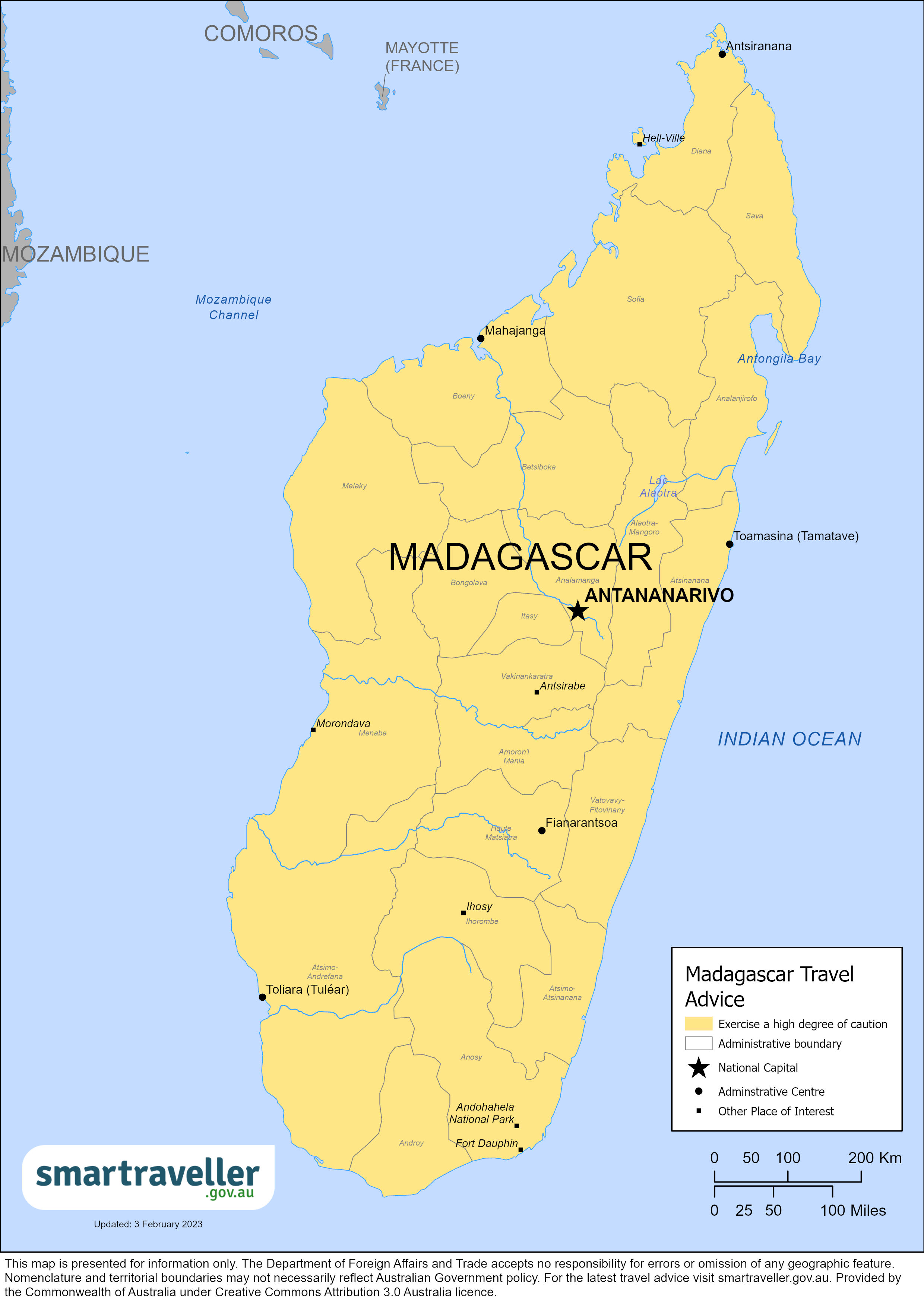
Madagascar (PDF 242.25 KB)
Africa (PDF 1.76 MB)
Local emergency contacts
Police - responsible for security within cities.
Call 117 or visit the nearest police station.
National gendarmerie - responsible for security outside cities
Fire and rescue services, medical emergencies.
Call 117 or go direct to a hospital.
Advice levels
Exercise a high degree of caution in Madagascar.
Exercise a high degree of caution in Madagascar due to the threat of crime and risk of natural disasters and disease outbreaks.
- Crime, including violent crime, is widespread in Madagascar. Crimes include armed robberies, muggings, theft, carjacking and kidnappings. Avoid travelling alone and at night and seek local security advice before travelling to regional areas, particularly in the south.
- Civil unrest including demonstrations and protests is common. They can turn violent quickly, and security forces may respond with force. Avoid demonstrations and large public gatherings. Monitor local media and follow instructions from local authorities.
- The cyclone season is from November to April, but severe weather events can still occur at other times. Heavy rain, flooding, strong winds, landslides and rough seas may occur. Coastal areas are particularly affected. Expect disruptions to essential services, transport options and medical services. Monitor weather alerts and follow instructions from local authorities, know your accommodation or cruise ship's evacuation plans.
- Madagascar can experience tsunamis. Know the warning signs and move immediately to high ground. Don't wait for official alerts. Follow the advice of local authorities and monitor media for updates.
Full travel advice: Safety
- Medical facilities in Madagascar are limited. Private clinics require up-front payments. You're likely to need medical evacuation if you're ill or injured.
- Bubonic plague, pneumonic plague and HIV/AIDS are widespread, and measles outbreaks can occur. If you have flu-like symptoms, visit a doctor right away. Make sure your vaccinations are up to date and take precautions if you're taking part in high-risk activities.
- Insect-borne diseases (including malaria, dengue and chikungunya) are common. Ensure your accommodation is insect-proof and use insect repellent.
- Foodborne, waterborne and other infectious diseases (including cholera, hepatitis and schistosomiasis) are common. Drink only boiled or bottled water. Avoid raw or undercooked food. Don't swim in freshwater.
Full travel advice: Health
- Don't use or carry illegal drugs. Penalties are severe and include prison sentences.
- Always carry original photo identification. Police may ask you for it, especially if you're out late at night.
- Know and follow local laws. It's illegal to take photos of military installations or wear military-style clothing. There are strict laws around exporting protected plants or animals, gemstones and vanilla.
- Same-sex relationships are legal, but not widely accepted in Malagasy society. The age of consent for same-sex relations is 21. Avoid public displays of affection.
Full travel advice: Local laws
- You'll need a visa to enter Madagascar. If you're a tourist, this can be completed on arrival at the airport. If you're not a tourist, you'll need to apply for a visa before arriving.
- If you’ve come from a country affected by cholera, you will be subject to additional sanitation measures and asked to take an antibiotic (Doxycycline) or other medication.
- You may need to provide a valid yellow fever vaccination certificate if you have arrived from a country where yellow fever is widespread.
Full travel advice: Travel
Local contacts
- The Consular Services Charter details what the Australian Government can and can't do to help you overseas.
- Australia has a consulate in Antananarivo, Madagascar. It provides limited consular and passport services. The consulate is open to the public via appointment only. See ' Consular Contacts '.
- For full consular assistance, contact the Australian Embassy in Mauritius .
- Follow the Embassy’s social media accounts to stay up to date with local information. See ' Consular Contacts '.
Full travel advice: Local contacts
Full advice
Crime, including violent crime, is a serious issue in Madagascar. Crime rates are significantly higher than in Australia.
Crime in Madagascar includes:
- armed robbery , mugging and theft
- home invasions
Foreigners have been the target of armed robberies, muggings and theft.
Petty crimes, such as bag-snatching, pick-pocketing and other crimes, happen across the country.
To protect yourself:
- be vigilant in tourist and transport locations
- don't go out alone after dark especially on foot
- don't leave luggage and valuables unattended
- don't display cash or valuables
- always keep your vehicle and accommodation locked
- always use authorised adn experienced guides and tour operators
If you're attacked or robbed, don't resist. Criminals are often armed, and you can be seriously injured or killed. Stay calm and consider surrendering a small sum of money.
Avoid actions that might antagonise security personnel, such as taking photos of them. They could respond with excessive force. Some individuals have been known to falsely claim they are from the police. If you're stopped by the police, stay calm and show respect. Ask for identification to confirm who they are without antagonising them.
Police resources are stretched, and you may not get the level of service you would in Australia, especially for less serious petty crimes.
Regional crime
There have been reports of violent clashes and crimes, resulting in deaths, across all regions of Madagascar. Some regions include:
- Northern Madagascar: in the beach and crowded areas of Nosy Be, Ankify Port and Ambanja
- Western Madagascar: on National Routes around Besalampy, Morombe, Tsiroanomandidy and Maintirano
- Southern Madagascar: in the Southern triangle between Ihosy, Toliara and Fort-Dauphin
Seek local security advice before travelling to regional areas.
Don't visit national parks alone. Be alert to your surroundings and circumstances.
'Smash and grab' thefts from vehicles and carjacking are common. This includes taxi bes (urban minibuses), taxi brousses (rural minibuses), and river ferries. This is particularly prevalent:
- on national routes
- at major intersections
- during traffic congestion
To prevent theft when travelling by car:
- keep doors locked and windows up, even when driving
- keep valuables out of sight
- avoid driving after dark
Kidnapping for ransom is a risk in Madagascar. This includes foreign nationals and expatriates working for international companies. Monitor the local news. If risks elevate, take extra precautions. Maintain a high level of vigilance. Watch for suspicious or unusual activity.
The Australian Government's longstanding policy is that it doesn't make payments or concessions to kidnappers.
More information:
Cyber security
You may be at risk of cyber-based threats during overseas travel to any country. Digital identity theft is a growing concern. Your devices and personal data can be compromised, especially if you're connecting to Wi-Fi, using or connecting to shared or public computers, or to Bluetooth.
Social media can also be risky in destinations where there are social or political tensions or laws that may seem unreasonable by Australian standards. Travellers have been arrested for things they have said on social media. Don't comment on local or political events on your social media.
More information:
- Cyber security when travelling overseas
Civil unrest and political tension
Civil unrest, including demonstrations and protests, is common in Madagascar.
Politically motivated protests and events, especially those that attract large numbers of people, can turn violent with little or no warning. Security forces may respond with force. Deaths have occurred at previous protests.
Avoid large gatherings and political demonstrations. Roads may be closed. Monitor local media and follow the instructions of local authorities.
Violent incidents have been reported in the capital Antananarivo, around government buildings, the national stadium, historical monuments, and military installations.
To stay safe during periods of unrest:
- avoid demonstrations and other large public gatherings
- watch for planned and possible civil unrest
- avoid affected areas
- monitor local news
- follow the instructions of local authorities.
- Demonstrations and civil unrest
Bombs and grenades
Small bombs and grenades have been found in Antananarivo, with reported deaths and injuries.
Climate and natural disasters
Madagascar experiences natural disasters and severe weather , including:
- cyclones and storms
Consider weather conditions when planning your travel and stay up-to-date on weather forecasts, natural disaster watches and warnings before and during your stay. Monitor local and regional weather and disaster sites and plan accordingly.
If a natural disaster occurs:
- secure your passport in a safe, waterproof place
- monitor local weather and news reports
- follow the advice of local authorities
- keep friends and family up to date on your safety
- Cooperative Institute for Meteorological Satellite Studies (Tropical Cyclones)
- World Meteorological Organization Severe Weather Information Centre
- Global Disaster Alert and Coordination System
Cyclones and storms
The cyclone season is from November to April. However, storms and cyclones may occur at other times. Storms and cyclones can cause:
- Flash flooding
- Torrential rain
- Storm surges
- Winds up to 300km/h
The direction and strength of cyclones can change without warning.
Cyclones have caused significant flooding, landslides/mudslides, and damage to buildings, roads, bridges and communication services across Madagascar. This includes the capital Antananarivo in the Analamanga region.
If there's a cyclone or other severe weather event:
- you may get stuck where you are
- flights could be delayed, suspended or may fill quickly
- the storm may affect access to seaports
- safe shelter may not be available
- medical facilities may not be available
To prepare for a cyclone or storm:
- know the evacuation plan for your hotel, cruise ship, or other accommodation
- identify your local shelter
- follow the instructions of local authorities
Tsunamis can occur in Madagascar. These are caused by an undersea earthquake, landslide, or volcanic eruption.
A tsunami can arrive within minutes of a nearby tremor or earthquake. It can also occur if no earthquake is felt.
Register with the Global Disaster Alert and Coordination System to receive tsunami alerts.
Move immediately to high ground if advised by local or regional authorities or if you:
- feel a strong earthquake that makes it hard to stand up
- feel a weak, rolling earthquake that lasts a minute or more
- see a sudden rise or fall in sea level
- hear loud and unusual noises from the sea
Don't wait for official warnings. Once you get to high ground, monitor local media.
Tours and adventure activities
Tour operators don't always follow safety and maintenance standards. If you plan to do a tour or adventure activity:
- check if your travel insurance policy covers it
- ask about and insist on minimum safety requirements
- always use available safety gear, such as life jackets or seatbelts
If proper safety equipment isn't available, use another provider.
Terrorism is a threat worldwide.
Travel insurance
Get comprehensive travel insurance before you leave.
Your policy needs to cover all overseas medical costs, including medical evacuation. The Australian Government won't pay for these costs.
If you can't afford travel insurance, you can't afford to travel. This applies to everyone, no matter how healthy and fit you are.
If you're not insured, you may have to pay many thousands of dollars up-front for medical care.
- what activities and care your policy covers
- your insurance covers you for the whole time you'll be away (including if stopovers on the way to your destination are covered)
Physical and mental health
Consider your physical and mental health before you travel, especially if you have an existing medical condition.
See your doctor or travel clinic to:
- have a basic health check-up
- ask if your travel plans may affect your health
- plan any vaccinations you need
Do this at least 8 weeks before you leave.
If you have immediate concerns for your welfare or the welfare of another Australian, call the 24-hour Consular Emergency Centre in Australia on +61 2 6261 3305 or contact your nearest Australian Embassy, High Commission or Consulate to discuss counselling hotlines and services available in your location.
- General health advice
- Healthy holiday tips (HealthDirect Australia)
Not all medication available over the counter or by prescription in Australia is available in other countries. Some may even be considered illegal or a controlled substance, even if prescribed by an Australian doctor.
If you plan to bring medication, check if it's legal in Madagascar. Take enough legal medicine for your trip.
Carry a copy of your prescription or a letter from your doctor stating:
- what the medication is
- your required dosage
- that it's for personal use
Health risks
Insect-borne diseases.
Bubonic plague is widespread in Madagascar. It is caused by the bite of an infected flea. You're most at risk in the wet season from October to February. The Bubonic plague can be successfully treated with antibiotics, but it is crucial to seek medical treatment immediately if you experience any plague signs or symptoms.
Malaria is widespread in Madagascar. Deaths due to malaria have been recorded in Madagascar.
Dengue is a risk in the northeast of Madagascar, around Antalaha and Sambava.
Serious outbreaks of other insect-borne diseases have occurred, including:
- Chikungunya
- Rift Valley Fever
To protect yourself from insect-borne diseases:
- make sure your accommodation is insect-proof
- use insect repellent
- wear long, loose, light-coloured clothing
- talk to your doctor about vaccinations and medications
If you have a fever, muscle pain, a rash or a bad headache, seek medical advice.
- Infectious diseases
The risk of polio still exists in Madagascar.
Check your vaccination status for polio . Do this at least 8 weeks before you travel.
If you aren't vaccinated, complete the full course of vaccinations before you leave. If you've been vaccinated in the past, get a booster dose if needed.
- Australian Immunisation Handbook (Department of Health and Aged Care)
HIV/AIDS is widespread.
Take precautions if you engage in activities that expose you to the risk of infection.
Measles outbreaks can occur in Madagascar.
Make sure your vaccinations are up to date before you travel.
Other health risks
Outbreaks of waterborne, foodborne and other infectious diseases occur. These include:
- schistosomiasis
- tuberculosis
To protect yourself from illness:
- wash and sanitise your hands regularly
- drink boiled water or bottled water with sealed lids
- avoid ice cubes
- avoid raw and undercooked food, such as salads
- don't swim in fresh water
- avoid contact with dogs and other mammals
If you're bitten or scratched by an animal, get medical help straight away.
Get medical advice if you have a fever or diarrhoea.
- WHO Madagascar (French)
Medical care
Madagascar's standard of medical facilities is basic, with only routine medical operations possible. Facilities are limited in Antananarivo and extremely limited in rural areas.
Only some doctors will speak English.
Most travellers attend private clinics, which can be expensive. Most will require an upfront payment before admitting you.
Regular outbreaks of insect-borne diseases, plagues and natural disasters impact healthcare services and hospital capacity, including ambulance services and accident and emergency care.
You'll need to be evacuated if you become seriously ill or injured. Medical evacuation can be very expensive.
There's no shared healthcare agreement between Australia and Madagascar. Check your insurance covers hospital stays and evacuation.
There are no decompression chambers in Madagascar. If you're scuba diving:
- dive within safety limits
- check your insurance policy covers diving and medical evacuation
You're subject to all local laws and penalties, including those that may appear harsh by Australian standards. Research local laws before travelling.
If you're arrested or jailed, the Australian Government will do what it can to help you under our Consular Services Charter . But we can't get you out of trouble or out of jail.
- Arrested or jailed
Penalties for drug offences are severe and include prison sentences.
- Carrying or using drugs
You must always carry an original photo ID, such as a passport or driver's licence. Police may ask you for it, especially if you're out late at night.
In Madagascar, it's illegal to:
- take photos of military installations or airports
- wear military-style clothing
- export protected plants or animals without approval
- export gemstones or vanilla for a commercial purpose without a permit
Same-sex relationships are legal but are not widely accepted in Madagascar. Avoid public displays of affection.
The age of consent for same-sex couples is 21. Same-sex marriage isn't recognised.
There are no anti-discrimination protections for LGBTQIA+ travellers.
- Advice for LGBTQIA+ travellers
Australian laws
Some Australian criminal laws still apply when you're overseas. If you break these laws, you may face prosecution in Australia.
- Staying within the law and respecting customs
Dual citizenship
Madagascar recognises dual nationality.
- Dual nationals
Visas and border measures
Every country or territory decides who can enter or leave through its borders. For specific information about the evidence you'll need to enter a foreign destination, check with the nearest embassy, consulate or immigration department of the destination you're entering.
You need a visa to enter Madagascar.
If you're a tourist, you can get a 30 or 60-day visa for single entry to Madagascar on arrival at the airport. Fees are payable in euros, US dollars or Malagasy ariary. Visa fees are not applicable if you stay for less than 15 days, but you'll have to pay a 10 euro administrative fee for border control formalities. You must have proof of onward travel. Tourist visas can be extended up to 90 days.
In other situations, you'll need to apply for a visa at the nearest Embassy or Consulate of Madagascar before you travel.
Entry and exit conditions can change at short notice. You should contact the nearest embassy or consulate of Madagascar for the latest details.
- Ministry of Tourism in Madagascar (English, French)
- Embassy or Consulate of Madagascar
Border measures
If you’re arriving from a country affected by cholera, you'll need to undertake additional sanitary controls and asked to take an antibiotic (Doxycycline).
You may be offered alternative medication if you:
- are pregnant
- are under 8 years old
- have a pre existing medical condition.
You may also need to provide contact details so health authorities can follow up for 3 – 5 days.
If you arrive from a country where yellow fever is widespread, you may need a valid yellow fever vaccination certificate to enter Madagascar. Some airlines may want to see one when you leave.
Find out about returning to Australia after exposure to yellow fever .
- Yellow Fever
- Countries with a risk of yellow fever (PDF 152KB)
Other formalities
Minors travelling alone or with only one parent may need to show proof the other parent has approved the travel. Carry a signed letter or custody order showing both parents approve the travel.
- Advice for people travelling with children
Some countries won't let you enter unless your passport is valid for 6 months after you plan to leave that country. This can apply even if you're just transiting or stopping over.
Some foreign governments and airlines apply the rule inconsistently. Travellers can receive conflicting advice from different sources.
You can end up stranded if your passport is not valid for more than 6 months.
The Australian Government does not set these rules. Check your passport's expiry date before you travel. If you're not sure it'll be valid for long enough, consider getting a new passport .
Lost or stolen passport
Your passport is a valuable document. It's attractive to people who may try to use your identity to commit crimes.
Some people may try to trick you into giving them your passport. Always keep it in a safe place.
If your passport is lost or stolen, tell the Australian Government as soon as possible:
- In Australia, contact the Australian Passport Information Service
- If you're overseas, contact the nearest Australian embassy or consulate
Passport with ‘X’ gender identifier
Although Australian passports comply with international standards for sex and gender, we can’t guarantee that a passport showing 'X' in the sex field will be accepted for entry or transit by another country. Contact the nearest embassy, high commission or consulate of your destination before you arrive at the border to confirm if authorities will accept passports with 'X' gender markers.
- LGBTQIA+ travellers
The local currency is the Malagasy Ariary (MGA).
Some hotels and restaurants accept euros.
Some stores, hotels and banks in Antananarivo and in other major cities accept traveller's cheques.
Credit cards aren't widely used. Ask your bank if your cards will work in Madagascar.
Local travel
Driving permit.
You can drive in Madagascar with either:
- a valid Australian driver's licence, or
- an International Driving Permit (IDP)
You must get your IDP before leaving Australia. If you're staying in Madagascar for a long time, you can use your IDP to apply for a local licence at the Ministry of Interior. You have a period of one year to convert your licence to a local one from the moment you obtain a resident permit.
The minimum driving age is 18 years old.
If you plan on driving in Madagascar:
- carry photo identity and vehicle registration documents, as you may be stopped by police
- check you have enough insurance cover before driving
- check local traffic laws and practices before driving
- drive carefully and legally
- be aware of potential dangers on the roads
- avoid remote roads, particularly at night
- don't drink and drive
Road travel
You're more likely to die in a motor vehicle accident in Madagascar than in Australia.
Common hazards include:
- poorly maintained roads and vehicles
- poor or insufficient street lighting
- people and animals roaming on roads
Carjacking, armed robberies and other crimes are a high risk when travelling by road. Be especially vigilant when travelling on National Routes at night. See Safety
Motorcycles
Check if your travel insurance policy covers you for riding a motorbike, quad bike or similar vehicle.
Always wear a helmet.
- Driving or riding
Only use hire cars and limousines from providers with a good reputation.
Avoid taxis, as these are regularly attacked by armed bandits. This is especially the case for taxi bes (urban minibuses) and taxi brousses (rural minibuses).
Public transport
Avoid public transport due to the lack of safety and crime risk.
Public buses are not well-maintained, and serious accidents have occurred.
Protect your belongings, especially when travelling overnight.
- Transport and getting around safe
Boat travel
Boat travel may be dangerous.
Piracy occurs in the coastal areas of northern Madagascar. Reduce the risk of piracy by adjusting your route if required, and monitoring piracy reports from the International Maritime Bureau .
Several ferries and rivercraft operate in Madagascar. These may be overloaded, poorly maintained and lack life-saving equipment. A lack of navigation skills and unexpected storms have contributed to boating accidents.
To stay safe on the water:
- check safety standards are in place
- check there is enough safety equipment for everyone
- wear your like jacket
- avoid travelling after dark
- don't get on overcrowded boats
- Travelling by boat
- Going on a cruise
DFAT doesn't provide information on the safety of individual commercial airlines or flight paths.
Check Madagascar's air safety profile with the Aviation Safety Network.
Emergencies
Depending on what you need, contact your:
- family and friends
- travel agent
- insurance provider
Call 18 or 118.
Call 117 or go directly to a hospital.
Call 17 or 117 (mobile phone) or 020 22 220 17 (landline) or visit the nearest police station.
Gendarmerie – responsible for security outside cities
Call 19 or 119 (mobile phone) or 020 22 223 02 (landline).
Emergency phone lines may not have English-speaking operators.
Response times may be longer than in Australia.
Always get a police report when you report a crime.
Your insurer should have a 24-hour emergency number.
Consular contacts
Read the Consular Services Charter for what the Australian Government can and can't do to help you overseas.
Australia's consulate in Madagascar provides limited consular services. The consulate in Antananarivo is open to the public via appointment only (see contact details below).
For full consular and passport services while in Madagascar, contact the Australian Embassy (based in Mauritius) via email (see contact details below).
Australian Consulate, Antananarivo
Building C1 (AMCHAM Office), Explorer Business Park Ankorondrano Antananarivo, Madagascar e mail: [email protected]
Australian Embassy, Mauritius
2nd Floor, Rogers House 5 President John Kennedy Street Port Louis, Mauritius Phone: +230 202 0160 General enquiries email: [email protected] Consular enquiries email: [email protected]
Passport enquiries: [email protected]
Website: mauritius.highcommission.gov.au Facebook: Australia in Mauritius, Seychelles, Madagascar and Comoros Twitter: @AusHC_MU
The website will provide details about opening hours, any temporary closures to the public, and services offered.
24-hour Consular Emergency Centre
In a consular emergency, if you can't contact the embassy, call the 24-hour Consular Emergency Centre on:
- +61 2 6261 3305 from overseas
- 1300 555 135 in Australia

Travelling to Madagascar?
Sign up to get the latest travel advice updates..
Be the first to know official government advice when travelling.
Security Alert May 17, 2024
Worldwide caution.
- Travel Advisories |
- Contact Us |
- MyTravelGov |
Find U.S. Embassies & Consulates
Travel.state.gov, congressional liaison, special issuance agency, u.s. passports, international travel, intercountry adoption, international parental child abduction, records and authentications, popular links, travel advisories, mytravelgov, stay connected, legal resources, legal information, info for u.s. law enforcement, replace or certify documents.
Before You Go
Learn About Your Destination
While Abroad
Emergencies
Share this page:
Travel Advisory July 31, 2023
Madagascar - level 2: exercise increased caution.
Reissued with obsolete COVID-19 page links removed, and updates to crime information in the Tsaratanana, Tsiroanomandidy, Maintirano, and Betroka areas.
Exercise increased caution in Madagascar due to crime and civil unrest. Some areas have increased risk. Read the entire Travel Advisory.
Reconsider travel to the following areas due to violent crime and banditry:
- The area in and around the city of Tsaratanana in the Betsiboka Region;
- The area along the unnamed road connecting the city of Tsiroanomandidy in the Bongolava Region with the coastal city of Maintirano in the Melaky Region; and
- The area in and around the city of Betroka in the Anosy Region.
Country Summary : Most criminal activity is non-violent petty theft, pickpocketing, and other crimes of opportunity predominately in urban areas and in crowded markets. Violent crime, such as armed robbery and assault, occurs throughout Madagascar, particularly after dark, in remote areas, and along major national roads in the south and western areas of the country.
Read the country information page for additional information on travel to Madagascar.
If you decide to travel to Madagascar:
- Avoid walking alone, especially after dark.
- Do not travel on the roads between cities after dark. [SJ3]
- Be aware of your surroundings. Thefts of items from vehicles is common and may involve ruses or distraction, particularly when stuck in traffic.
- Stay alert in locations frequented by tourists.
- Do not display signs of wealth, such as wearing expensive jewelry or watches.
- Enroll in the Smart Traveler Enrollment Program ( STEP ) to receive Alerts and make it easier to locate you in an emergency.
- Follow the Department of State on Facebook and Twitter .
- Review the Country Security Report for Madagascar.
- U.S. citizens who travel abroad should always have a contingency plan for emergency situations. Review the Traveler’s Checklist .
- Visit the CDC page for the latest Travel Health Information related to your travel.
Mid-Sized Urban Areas – Level 3: Reconsider Travel
Violent crime, such as armed carjacking, banditry, mugging, home invasion, and kidnapping can occur at any time. Local police often lack the resources and training to respond effectively to serious criminal incidents in these areas:
Visit our website for Travel to High-Risk Areas .
Embassy Messages
View Alerts and Messages Archive
Quick Facts
6 months at the time of entry
Yes, available upon arrival
Yellow fever, if traveler has been in a yellow fever endemic country within 6 months of arrival
Embassies and Consulates
U.s. embassy antananarivo.
Lot 207 A, Point Liberty Andranoro, Antehiroka 105 Antananarivo Madagascar Telephone: +(261) (20) 23-480-00 (Monday through Thursday from 7:30 a.m. to 5:00 p.m. and Friday from 7:30 a.m. to 1:30 p.m.) Emergency After-Hours Telephone: +(261) (20) 23-480-00 Fax: +(261) (20) 23-480-35 Email: [email protected]
Destination Description
Learn about the U.S. relationship to countries around the world.
Entry, Exit and Visa Requirements
Requirements for Entry:
- Passport, valid for six months from your date of entry and with three blank pages
- Visa, obtain before traveling, or purchase at port of entry if staying less than three months. Visas may be purchased with U.S. dollars, euros, or Malagasy ariary, but credit cards are not accepted.
- Evidence of onward/return travel
- Proof of sufficient funds
- World Health Organization (WHO) card with yellow fever vaccination if traveler has been in a yellow fever endemic area within six months of arrival
Visit the Embassy of Madagascar website or the nearest Malagasy embassy or consulate for visa information, including how to obtain a visa before traveling if you will stay longer than three months, and documents required for visa extensions. The U.S. Embassy in Antananarivo cannot help you extend your visa.
Screening for Ebola infection may be conducted at the airports.
The U.S. Department of State is unaware of any HIV/AIDS entry restrictions for visitors to or foreign residents of Madagascar.
Minor children:
According to Malagasy law, residents of Madagascar with minor children traveling without both parents are required to have a notarized letter of consent to travel from the absent parent, preferably in French. This requirement does not apply to tourists visiting Madagascar. Please check neighboring countries’ country information for requirements for traveling with minor children.
Find information on dual nationality , prevention of international child abduction , and customs information on our websites.
Special Note: Overseas departments and territories of France (e.g., Mayotte) are not included in the Schengen Agreement. See the Embassy of France website for further information.
Safety and Security
Civil unrest, such as protests, is common in Madagascar. Be especially vigilant in the vicinity of downtown Antananarivo especially near government buildings, the national stadium, and historical monuments, where violent incidents have occurred.
Violent confrontations between the dahalo (criminal gangs that steal cattle) and security forces have increased in several regions of Madagascar, particularly in areas south and west of the capital.
Often precipitated by rumors or allegations of injuries to local citizens especially in areas where there are minimal security forces, mob violence and “popular justice” continues but is rarely directed toward foreign nationals. Street altercations and traffic accidents often quickly draw large and sometimes unruly crowds. Exercise caution and remain calm if you find yourself in a dispute, particularly in a public place. If you feel threatened by large crowds, immediately leave the scene, seek the direct intervention of local law enforcement, and contact the U.S. Embassy.
The cyclone season in Madagascar occurs between December and April. Please monitor media reports, the RSMC Tropical Cyclone Center , and follow all official instructions.
Exercise Increased Caution Due to Possible Protests and Civil Unrest Related to Presidential Election
The official campaign season for Madagascar’s presidential election has begun. The first round of voting is scheduled for November 16. A second round, if necessary, is scheduled for December 20. Opposition candidates have already called for and staged large-scale protests in the capital, Antananarivo, resulting in violent confrontations with law enforcement. Such protests may continue throughout the election period and may escalate and expand geographically as the candidates begin to campaign throughout the country. Given the increased possibility of protests and civil unrest, we urge U.S. citizens to exercise increased caution and enroll in STEP to ensure access to security alerts sent by the Embassy.
We also advise U.S. citizens that domestic flights in Madagascar are frequently subject to last-minute cancellations that can leave travelers stranded in remote areas without assistance. Tsaradia, Madagascar’s state-owned domestic airline, has a monopoly on domestic commercial flights and is notorious for last-minute cancellations and rescheduling, with no recourse for stranded travelers. Those who book Tsaradia flights through a third-party may not receive any advance notice of such cancellations and rescheduling. Regional airports in Madagascar receive little traffic and will close completely if the Tsaradia flight(s) for the day is cancelled. In such an event, there are no airline personnel present to assist stranded travelers. We recommend that travelers make contingency plans for lodging and local transportation in case their flight is cancelled or rescheduled at the last minute.
CRIME: Petty crime in Madagascar is common in urban areas. Skilled pickpockets are very active in downtown Antananarivo, and they primarily target jewelry, purses, and mobile phones. Additionally, criminals have stolen luggage from baggage claim areas at Antananarivo’s Ivato International Airport by simply grabbing items off the conveyor belt and exiting the airport.
Serious crimes, including home invasions, armed attacks, robberies, and assaults, are common in Madagascar. U.S. Embassy personnel are instructed not to use taxi-bes (minibuses which operate within urban centers) and taxi-brousses (which travel to outlying regions) due to the risk of carjacking and highway robbery. The majority of reported crimes were directed at Malagasy nationals but Westerners have likewise been targeted.
- Avoid walking alone especially after dark.
- Do not display cash and valuables.
- Drive with doors locked and windows closed.
- Always carry a color photocopy of your U.S. passport and visa. Keep original documents in a secure location. Most Malagasy authorities will accept a color photo copy, but you may be requested to present the original.
Violent crime, such as armed robbery and assaults, is common in:
- Toamasina and Mahajanga
- Ankarana and Montagne d’Ambre National Parks adjacent to Diego
- area surrounding Tolagnaro (Ft. Dauphin)
- Batteie Beach, north of Toliara (Tuléar)
Visiting remote sites: While the government has increased the number of dedicated police units at popular tourist sites, only visit remote sites in large groups guided by reputable tour operators.
Exercise caution when traveling through these designated areas due to violent highway robberies:
- The general area south of the National Route (RN) 7 and RN 27 including the RN 10, RN 13, and the surrounding areas. Except the tourist area on the coastal roads between Ambovombe and Farafangana, including Fort Dauphin/Tolagnaro area.
- The RN 1B, which is located to the west of Antananarivo between Tsiroanomandidy and Maintirano.
See the Department of State and the FBI pages for information on scams.
Victims of Crime:
Report crimes to the local police at 117, 22-227-35, or 22-357-09/10. U.S. citizens can also call the U.S. Embassy at (261) 20-23-480-00 if assistance is needed in communicating with law enforcement officials.
Remember that local authorities are responsible for investigating and prosecuting the crime.
See our webpage on help for U.S. victims of crime overseas .
- help you find appropriate medical care
- assist you in reporting a crime to the police
- contact relatives or friends with your written consent
- explain the local criminal justice process in general terms
- provide a list of local attorneys
- provide our information on victim’s compensation programs in the U.S.
- provide an emergency loan for repatriation to the United States and/or limited medical support in cases of destitution
- help you find accommodation and arrange flights home
- replace a stolen or lost passport
Domestic Violence: U.S. citizen victims of domestic violence may contact the Embassy for assistance.
Tourism : The tourism industry is unevenly regulated, and safety inspections for equipment and facilities do not commonly occur. Hazardous areas/activities are not always identified with appropriate signage, and staff may not be trained or certified either by the host government or by recognized authorities in the field. In the event of an injury, appropriate medical treatment is typically available only in/near major cities. First responders are generally unable to access areas outside of major cities and to provide urgent medical treatment. U.S. citizens are encouraged to purchase medical evacuation insurance. See our webpage for more information on insurance providers for overseas coverage.
Local Laws & Special Circumstances
Criminal Penalties: You are subject to local laws. If you violate local laws, even unknowingly, you may be expelled, arrested, or imprisoned.
Furthermore, some laws are also prosecutable in the U.S., regardless of local law. For examples, see our website on crimes against minors abroad and the Department of Justice website.
Arrest Notification: If you are arrested or detained, ask police or prison officials to notify the U.S. Embassy immediately. See our webpage for further information.
Drugs: Penalties for possession, use, or trafficking in illegal drugs in Madagascar are severe, and convicted offenders can expect long jail sentences and heavy fines.
Visa overstays are a violation of local laws and U.S. citizens who overstay their visas will be subject to fines and potential prosecution.
Exporting Gemstones/Precious Materials: The Government of Madagascar restricts the export of precious gems. Before purchasing or transporting gemstones, seek clarification of the applicable laws. Any precious materials should be accompanied by a certificate of authenticity and a certificate to allow for exportation from Madagascar.
Currency: Madagascar is primarily a cash economy. Although some high-end establishments accept credit cards (normally only Visa-network cards), most shops and restaurants are cash only.
Although the government changed the local currency from the Malagasy franc (FMG) to the ariary in 2005, many Malagasy still think in terms of FMG. When discussing prices, you should quantify whether the price is in ariary or FMG (1 Ariary = 5 FMG). ATMs, which generally accept Visa-network cards only, are available in large cities. Dollars are not widely accepted, and $100 bills are frequently refused at banks and local businesses.
Faith-Based Travelers: See our following webpages for details:
- Faith-Based Travel Information
- International Religious Freedom Report – see country reports
- Human Rights Report – see country reports
- Hajj Fact Sheet for Travelers
- Best Practices for Volunteering Abroad
LGBTI Travelers: Consensual same-sex sexual relations are criminalized in Madagascar with and between persons under the age of 21, and Malagasy law contains no anti-discrimination protections for LGBTI persons. Penalties can include imprisonment and fines.
See our LGBTI Travel Information page and section 6 of our Human Rights report for further details.
Travelers Who Require Accessibility Assistance: There is ample public transportation, but entering and exiting vehicles is precarious, and they are not equipped to accommodate passengers with disabilities. Vehicles are often still in motion as passengers enter and exit. There are no sidewalks in the vast majority of the country, and the roads are hazardous for foot travel with swerving vehicles and uneven surfaces. There are no pedestrian crossing signs or designated pathways, and crossing any street involves an element of risk. Pedestrian injuries are common. Public spaces are not wheelchair-accessible.
Students: See our Students Abroad page and FBI travel tips .
Women Travelers: See our travel tips for Women Travelers .
Consult the CDC website for Madagascar prior to travel.
Plague is endemic on the island, where outbreaks have resurfaced nearly every year since 1980. U.S. citizens visiting Madagascar are urged to monitor public health announcements from the Ministry of Public Health and the World Health Organization, and to follow public health guidelines and recommendations. Plague can be successfully treated with antibiotics, but it is crucial to seek medical treatment immediately, if you experience any plague signs or symptoms.
See the List of Health Care Providers on the Embassy Antananarivo web page.
You are responsible for all medical costs. U.S. Medicare does not cover you overseas.
Medical Insurance: If your health insurance plan does not provide coverage overseas, we strongly recommend supplemental medical insurance and medical evacuation plans .
Carry prescription medication in original packaging, along with your doctor’s prescription.
The following diseases are prevalent:
- Dengue Fever
- Chikungunya
- Diarrheal illness
- Tuberculosis
Vaccinations: Be up-to-date on all vaccinations recommended by the U.S. Centers for Disease Control and Prevention.
Further health information:
- World Health Organization
- U.S. Centers for Disease Control and Prevention (CDC)
Travel and Transportation
Road Conditions and Safety: Road conditions range from minimally acceptable to very poor. There are few pedestrian crosswalks and no working traffic signals.
U.S. Embassy personnel are prohibited from driving outside of major cities after dark. Certain roads in Antananarivo have restrictions on tractor trailers during the day, so trucks use the roads at night and do not always follow the traffic rules. Street lighting is limited, and it is difficult to see pedestrians, carts, and livestock. Additional risks include excessive speeding and drivers that do not use headlights
There are random police vehicle checkpoints throughout Madagascar, so carry photo identification (residency card, U.S. passport) in the event of police questioning. These checkpoints are routine in nature and should not result in vehicle and/or person searches as long as valid identification and visas are shown. However, travelers have reported harassment and bribe solicitation.
If you are stopped at a checkpoint:
- Comply with the officers’ requests. Remain courteous and calm.
- Stay inside your vehicle with doors locked and open the window slightly to communicate. Turn on your interior vehicle light at night.
- Tell the officer you are a U.S. citizen and display your U.S. passport color photo copy through the window.
- Do not leave until instructed to do so.
- Report harassment to the U.S. Embassy.
Please note:
- Local practice is to blow the horn before going around a curve, to let others know of one's presence.
- Seatbelt use is mandatory.
- The use of cell phones while driving, even with a hands-free attachment, is illegal.
- Child safety seats are not mandatory, but highly recommended.
- You are required to wear a helmet when on a motorcycle.
Public Transportation: Public transportation is unreliable and vehicles are poorly maintained. Rail services are extremely limited and unreliable.
Domestic and international air services operate regularly but are subject to delays and occasional breakdowns. Air Madagascar often changes in-country flight schedules based on demand; flights that are not full may be cancelled with little or no prior warning to passengers. Overbooking is also common. Reconfirmation of tickets prior to flight day is recommended, especially when flying from provincial airports.
See our Road Safety page for more information. The Ministry of Public Works, telephone (20) 22-318-02, is responsible for road safety.
Aviation Safety Oversight: As there is no direct commercial air service to the United States by carriers registered in Madagascar, the U.S. Federal Aviation Administration (FAA) has not assessed the Government of Madagascar’s Civil Aviation Authority for compliance with International Civil Aviation Organization (ICAO) aviation safety standards. Further information may be found on the FAA's safety assessment page .
Maritime Travel: Mariners planning travel to Madagascar should check for U.S. maritime advisories and alerts at the U.S. Department of Transportation’s Maritime Security Communications with Industry WebPortal . Information may also be posted to the U.S. Coast Guard homeport website and as a broadcast warning on the National Geospatial-Intelligence Agency’s website .
Port Security: The Commandant of the Coast Guard has determined that effective anti-terrorism measures are not in place in Madagascar ports and has imposed conditions of entry on vessels that arrive in U.S. ports having visited ports in Madagascar. Mariners and passengers on commercial vessels traveling through the ports of Madagascar should exercise increased caution.
For additional travel information
- Enroll in the Smart Traveler Enrollment Program (STEP) to receive security messages and make it easier to locate you in an emergency.
- Call us in Washington, D.C. at 1-888-407-4747 (toll-free in the United States and Canada) or 1-202-501-4444 (from all other countries) from 8:00 a.m. to 8:00 p.m., Eastern Standard Time, Monday through Friday (except U.S. federal holidays).
- See the State Department’s travel website for the Worldwide Caution and Travel Advisories .
- Follow us on X (formerly known as "Twitter") and Facebook .
- See traveling safely abroad for useful travel tips.
For additional IPCA-related information, please see the International Child Abduction Prevention and Return Act (ICAPRA) report.
Travel Advisory Levels
Assistance for u.s. citizens, madagascar map, learn about your destination, enroll in step.

Subscribe to get up-to-date safety and security information and help us reach you in an emergency abroad.
Recommended Web Browsers: Microsoft Edge or Google Chrome.
Check passport expiration dates carefully for all travelers! Children’s passports are issued for 5 years, adult passports for 10 years.
Afghanistan
Antigua and Barbuda
Bonaire, Sint Eustatius, and Saba
Bosnia and Herzegovina
British Virgin Islands
Burkina Faso
Burma (Myanmar)
Cayman Islands
Central African Republic
Cote d Ivoire
Czech Republic
Democratic Republic of the Congo
Dominican Republic
El Salvador
Equatorial Guinea
Eswatini (Swaziland)
Falkland Islands
France (includes Monaco)
French Guiana
French Polynesia
French West Indies
Guadeloupe, Martinique, Saint Martin, and Saint Barthélemy (French West Indies)
Guinea-Bissau
Isle of Man
Israel, The West Bank and Gaza
Liechtenstein
Marshall Islands
Netherlands
New Caledonia
New Zealand
North Korea (Democratic People's Republic of Korea)
Papua New Guinea
Philippines
Republic of North Macedonia
Republic of the Congo
Saint Kitts and Nevis
Saint Lucia
Saint Vincent and the Grenadines
Sao Tome and Principe
Saudi Arabia
Sierra Leone
Sint Maarten
Solomon Islands
South Africa
South Korea
South Sudan
Switzerland
The Bahamas
Timor-Leste
Trinidad and Tobago
Turkmenistan
Turks and Caicos Islands
United Arab Emirates
United Kingdom
Vatican City (Holy See)
External Link
You are about to leave travel.state.gov for an external website that is not maintained by the U.S. Department of State.
Links to external websites are provided as a convenience and should not be construed as an endorsement by the U.S. Department of State of the views or products contained therein. If you wish to remain on travel.state.gov, click the "cancel" message.
You are about to visit:
You are using an outdated browser. Upgrade your browser today or install Google Chrome Frame to better experience this site.
Madagascar Traveler View
Travel health notices, vaccines and medicines, non-vaccine-preventable diseases, stay healthy and safe.
- Packing List
After Your Trip
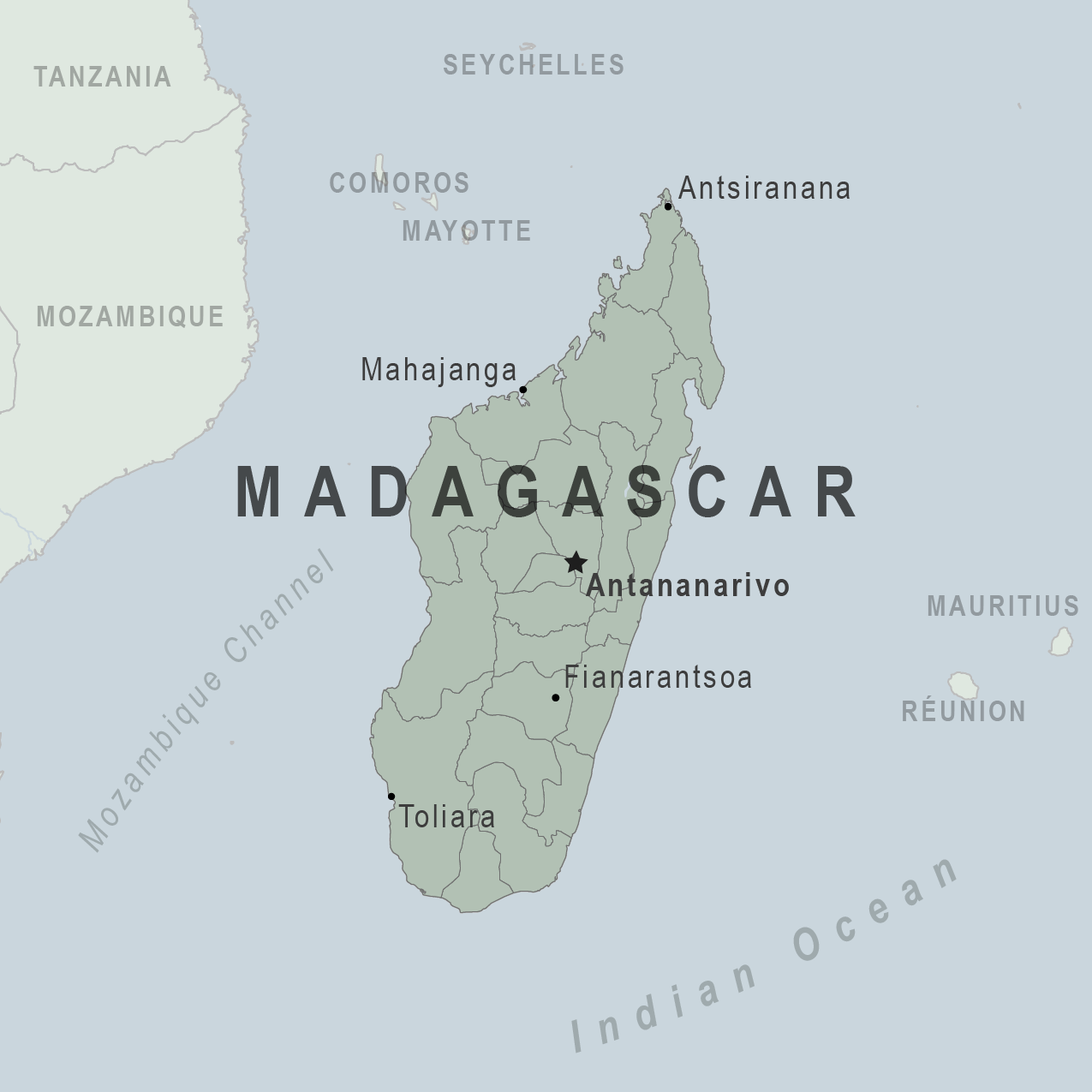
Be aware of current health issues in Madagascar. Learn how to protect yourself.
Level 2 Practice Enhanced Precautions
- Updated Global Polio August 20, 2024 Some international destinations have circulating poliovirus. Before any international travel, make sure you are up to date on your polio vaccines. Destination List: Afghanistan, Algeria, Angola, Benin, Botswana, Burkina Faso, Burundi, Cameroon, Central African Republic, Chad, Côte d'Ivoire (Ivory Coast), Democratic Republic of the Congo, Egypt, Ethiopia, Guinea, Indonesia, Kenya, Liberia, Madagascar, Mali, Mauritania, Mozambique, Niger, Nigeria, Pakistan, Republic of South Sudan, Republic of the Congo, Senegal, Sierra Leone, Somalia, Sudan, Tanzania, including Zanzibar, The Gambia, Uganda, Yemen, Zambia, Zimbabwe
⇧ Top
Check the vaccines and medicines list and visit your doctor at least a month before your trip to get vaccines or medicines you may need. If you or your doctor need help finding a location that provides certain vaccines or medicines, visit the Find a Clinic page.
Avoid contaminated water
Leptospirosis
How most people get sick (most common modes of transmission)
- Touching urine or other body fluids from an animal infected with leptospirosis
- Swimming or wading in urine-contaminated fresh water, or contact with urine-contaminated mud
- Drinking water or eating food contaminated with animal urine
- Avoid contaminated water and soil
- Avoid floodwater
Clinical Guidance
Avoid bug bites, african tick-bite fever.
- Avoid Bug Bites
African Tick-bite fever
Chikungunya
- Mosquito bite
Crimean-Congo Hemorrhagic fever
- Tick bite
- Touching the body fluids of a person or animal infected with CCHF
- Mosquito bite
Plague (Bubonic, Pneumonic, Septicemic)
- Contact with infected people (pneumonic) or animals
- Avoid sick animals and people
- Avoid animals
Rift Valley Fever
- Touching blood, body fluids, or tissue of infected livestock
Rift Valley fever
Airborne & droplet
- Breathing in air or accidentally eating food contaminated with the urine, droppings, or saliva of infected rodents
- Bite from an infected rodent
- Less commonly, being around someone sick with hantavirus (only occurs with Andes virus)
- Avoid rodents and areas where they live
- Avoid sick people
Tuberculosis (TB)
- Breathe in TB bacteria that is in the air from an infected and contagious person coughing, speaking, or singing.
Learn actions you can take to stay healthy and safe on your trip. Vaccines cannot protect you from many diseases in Madagascar, so your behaviors are important.
Eat and drink safely
Food and water standards around the world vary based on the destination. Standards may also differ within a country and risk may change depending on activity type (e.g., hiking versus business trip). You can learn more about safe food and drink choices when traveling by accessing the resources below.
- Choose Safe Food and Drinks When Traveling
- Water Treatment Options When Hiking, Camping or Traveling
- Global Water, Sanitation and Hygiene (WASH)
- Avoid Contaminated Water During Travel
You can also visit the Department of State Country Information Pages for additional information about food and water safety.
Prevent bug bites
Bugs (like mosquitoes, ticks, and fleas) can spread a number of diseases in Madagascar. Many of these diseases cannot be prevented with a vaccine or medicine. You can reduce your risk by taking steps to prevent bug bites.
What can I do to prevent bug bites?
- Cover exposed skin by wearing long-sleeved shirts, long pants, and hats.
- Use an appropriate insect repellent (see below).
- Use permethrin-treated clothing and gear (such as boots, pants, socks, and tents). Do not use permethrin directly on skin.
- Stay and sleep in air-conditioned or screened rooms.
- Use a bed net if the area where you are sleeping is exposed to the outdoors.
What type of insect repellent should I use?
- FOR PROTECTION AGAINST TICKS AND MOSQUITOES: Use a repellent that contains 20% or more DEET for protection that lasts up to several hours.
- Picaridin (also known as KBR 3023, Bayrepel, and icaridin)
- Oil of lemon eucalyptus (OLE) or para-menthane-diol (PMD)
- 2-undecanone
- Always use insect repellent as directed.
What should I do if I am bitten by bugs?
- Avoid scratching bug bites, and apply hydrocortisone cream or calamine lotion to reduce the itching.
- Check your entire body for ticks after outdoor activity. Be sure to remove ticks properly.
What can I do to avoid bed bugs?
Although bed bugs do not carry disease, they are an annoyance. See our information page about avoiding bug bites for some easy tips to avoid them. For more information on bed bugs, see Bed Bugs .
For more detailed information on avoiding bug bites, see Avoid Bug Bites .
Stay safe outdoors
If your travel plans in Madagascar include outdoor activities, take these steps to stay safe and healthy during your trip.
- Stay alert to changing weather conditions and adjust your plans if conditions become unsafe.
- Prepare for activities by wearing the right clothes and packing protective items, such as bug spray, sunscreen, and a basic first aid kit.
- Consider learning basic first aid and CPR before travel. Bring a travel health kit with items appropriate for your activities.
- If you are outside for many hours in heat, eat salty snacks and drink water to stay hydrated and replace salt lost through sweating.
- Protect yourself from UV radiation : use sunscreen with an SPF of at least 15, wear protective clothing, and seek shade during the hottest time of day (10 a.m.–4 p.m.).
- Be especially careful during summer months and at high elevation. Because sunlight reflects off snow, sand, and water, sun exposure may be increased during activities like skiing, swimming, and sailing.
- Very cold temperatures can be dangerous. Dress in layers and cover heads, hands, and feet properly if you are visiting a cold location.
Stay safe around water
- Swim only in designated swimming areas. Obey lifeguards and warning flags on beaches.
- Practice safe boating—follow all boating safety laws, do not drink alcohol if driving a boat, and always wear a life jacket.
- Do not dive into shallow water.
- Do not swim in freshwater in developing areas or where sanitation is poor.
- Avoid swallowing water when swimming. Untreated water can carry germs that make you sick.
- To prevent infections, wear shoes on beaches where there may be animal waste.
Schistosomiasis, a parasitic infection that can be spread in fresh water, is found in Madagascar. Avoid swimming in fresh, unchlorinated water, such as lakes, ponds, or rivers.
Keep away from animals
Most animals avoid people, but they may attack if they feel threatened, are protecting their young or territory, or if they are injured or ill. Animal bites and scratches can lead to serious diseases such as rabies.
Follow these tips to protect yourself:
- Do not touch or feed any animals you do not know.
- Do not allow animals to lick open wounds, and do not get animal saliva in your eyes or mouth.
- Avoid rodents and their urine and feces.
- Traveling pets should be supervised closely and not allowed to come in contact with local animals.
- If you wake in a room with a bat, seek medical care immediately. Bat bites may be hard to see.
All animals can pose a threat, but be extra careful around dogs, bats, monkeys, sea animals such as jellyfish, and snakes. If you are bitten or scratched by an animal, immediately:
- Wash the wound with soap and clean water.
- Go to a doctor right away.
- Tell your doctor about your injury when you get back to the United States.
Consider buying medical evacuation insurance. Rabies is a deadly disease that must be treated quickly, and treatment may not be available in some countries.
Reduce your exposure to germs
Follow these tips to avoid getting sick or spreading illness to others while traveling:
- Wash your hands often, especially before eating.
- If soap and water aren’t available, clean hands with hand sanitizer (containing at least 60% alcohol).
- Don’t touch your eyes, nose, or mouth. If you need to touch your face, make sure your hands are clean.
- Cover your mouth and nose with a tissue or your sleeve (not your hands) when coughing or sneezing.
- Try to avoid contact with people who are sick.
- If you are sick, stay home or in your hotel room, unless you need medical care.
Avoid sharing body fluids
Diseases can be spread through body fluids, such as saliva, blood, vomit, and semen.
Protect yourself:
- Use latex condoms correctly.
- Do not inject drugs.
- Limit alcohol consumption. People take more risks when intoxicated.
- Do not share needles or any devices that can break the skin. That includes needles for tattoos, piercings, and acupuncture.
- If you receive medical or dental care, make sure the equipment is disinfected or sanitized.
Know how to get medical care while traveling
Plan for how you will get health care during your trip, should the need arise:
- Carry a list of local doctors and hospitals at your destination.
- Review your health insurance plan to determine what medical services it would cover during your trip. Consider purchasing travel health and medical evacuation insurance.
- Carry a card that identifies, in the local language, your blood type, chronic conditions or serious allergies, and the generic names of any medications you take.
- Some prescription drugs may be illegal in other countries. Call Madagascar’s embassy to verify that all of your prescription(s) are legal to bring with you.
- Bring all the medicines (including over-the-counter medicines) you think you might need during your trip, including extra in case of travel delays. Ask your doctor to help you get prescriptions filled early if you need to.
Many foreign hospitals and clinics are accredited by the Joint Commission International. A list of accredited facilities is available at their website ( www.jointcommissioninternational.org ).
In some countries, medicine (prescription and over-the-counter) may be substandard or counterfeit. Bring the medicines you will need from the United States to avoid having to buy them at your destination.
Malaria is a risk in Madagascar. Fill your malaria prescription before you leave and take enough with you for the entire length of your trip. Follow your doctor’s instructions for taking the pills; some need to be started before you leave.
Select safe transportation
Motor vehicle crashes are the #1 killer of healthy US citizens in foreign countries.
In many places cars, buses, large trucks, rickshaws, bikes, people on foot, and even animals share the same lanes of traffic, increasing the risk for crashes.
Be smart when you are traveling on foot.
- Use sidewalks and marked crosswalks.
- Pay attention to the traffic around you, especially in crowded areas.
- Remember, people on foot do not always have the right of way in other countries.
Riding/Driving
Choose a safe vehicle.
- Choose official taxis or public transportation, such as trains and buses.
- Ride only in cars that have seatbelts.
- Avoid overcrowded, overloaded, top-heavy buses and minivans.
- Avoid riding on motorcycles or motorbikes, especially motorbike taxis. (Many crashes are caused by inexperienced motorbike drivers.)
- Choose newer vehicles—they may have more safety features, such as airbags, and be more reliable.
- Choose larger vehicles, which may provide more protection in crashes.
Think about the driver.
- Do not drive after drinking alcohol or ride with someone who has been drinking.
- Consider hiring a licensed, trained driver familiar with the area.
- Arrange payment before departing.
Follow basic safety tips.
- Wear a seatbelt at all times.
- Sit in the back seat of cars and taxis.
- When on motorbikes or bicycles, always wear a helmet. (Bring a helmet from home, if needed.)
- Avoid driving at night; street lighting in certain parts of Madagascar may be poor.
- Do not use a cell phone or text while driving (illegal in many countries).
- Travel during daylight hours only, especially in rural areas.
- If you choose to drive a vehicle in Madagascar, learn the local traffic laws and have the proper paperwork.
- Get any driving permits and insurance you may need. Get an International Driving Permit (IDP). Carry the IDP and a US-issued driver's license at all times.
- Check with your auto insurance policy's international coverage, and get more coverage if needed. Make sure you have liability insurance.
- Avoid using local, unscheduled aircraft.
- If possible, fly on larger planes (more than 30 seats); larger airplanes are more likely to have regular safety inspections.
- Try to schedule flights during daylight hours and in good weather.
Medical Evacuation Insurance
If you are seriously injured, emergency care may not be available or may not meet US standards. Trauma care centers are uncommon outside urban areas. Having medical evacuation insurance can be helpful for these reasons.
Helpful Resources
Road Safety Overseas (Information from the US Department of State): Includes tips on driving in other countries, International Driving Permits, auto insurance, and other resources.
The Association for International Road Travel has country-specific Road Travel Reports available for most countries for a minimal fee.
Maintain personal security
Use the same common sense traveling overseas that you would at home, and always stay alert and aware of your surroundings.
Before you leave
- Research your destination(s), including local laws, customs, and culture.
- Monitor travel advisories and alerts and read travel tips from the US Department of State.
- Enroll in the Smart Traveler Enrollment Program (STEP) .
- Leave a copy of your itinerary, contact information, credit cards, and passport with someone at home.
- Pack as light as possible, and leave at home any item you could not replace.
While at your destination(s)
- Carry contact information for the nearest US embassy or consulate .
- Carry a photocopy of your passport and entry stamp; leave the actual passport securely in your hotel.
- Follow all local laws and social customs.
- Do not wear expensive clothing or jewelry.
- Always keep hotel doors locked, and store valuables in secure areas.
- If possible, choose hotel rooms between the 2nd and 6th floors.
Healthy Travel Packing List
Use the Healthy Travel Packing List for Madagascar for a list of health-related items to consider packing for your trip. Talk to your doctor about which items are most important for you.
Why does CDC recommend packing these health-related items?
It’s best to be prepared to prevent and treat common illnesses and injuries. Some supplies and medicines may be difficult to find at your destination, may have different names, or may have different ingredients than what you normally use.
If you are not feeling well after your trip, you may need to see a doctor. If you need help finding a travel medicine specialist, see Find a Clinic . Be sure to tell your doctor about your travel, including where you went and what you did on your trip. Also tell your doctor if you were bitten or scratched by an animal while traveling.
If your doctor prescribed antimalarial medicine for your trip, keep taking the rest of your pills after you return home. If you stop taking your medicine too soon, you could still get sick.
Malaria is always a serious disease and may be a deadly illness. If you become ill with a fever either while traveling in a malaria-risk area or after you return home (for up to 1 year), you should seek immediate medical attention and should tell the doctor about your travel history.
For more information on what to do if you are sick after your trip, see Getting Sick after Travel .
Map Disclaimer - The boundaries and names shown and the designations used on maps do not imply the expression of any opinion whatsoever on the part of the Centers for Disease Control and Prevention concerning the legal status of any country, territory, city or area or of its authorities, or concerning the delimitation of its frontiers or boundaries. Approximate border lines for which there may not yet be full agreement are generally marked.
Other Destinations
If you need help finding travel information:
Message & data rates may apply. CDC Privacy Policy
File Formats Help:
- Adobe PDF file
- Microsoft PowerPoint file
- Microsoft Word file
- Microsoft Excel file
- Audio/Video file
- Apple Quicktime file
- RealPlayer file
- Zip Archive file

Travelling to Madagascar
Corona rules.
Reopening of Madagascar’s borders Madagascar is open From June 2023, all airlines will fly with the same frequencies per week to Madagascar as before the pandemic, Air France and Ethiopian Airlines will even increase the frequencies from June 2023. Since 11 August 2022, the entry requirements have changed, there are no test required anymore, neither before arrival nor at arrival. We strongly recommend that tourists coming to Madagascar take out a good insurance, which covers the reimbursement of the cancellation fees, if they should be ill before departure from home.
ENTRY FORMALITIES
A visa is required to enter the territory of Madagascar: you can get a visa at the Consulate of Madagascar in your country, or easier, upon arrival at the international airports of Madagascar. Please check if your passport is still valid. You can easily obtain a visa at arrival at the international airports in Madagascar (Antananarivo, Nosy Be, Majunga, Diego Suarez, Tamatave) with a valid passport (must be valid 6 months beyond the traveling date) and a valid return flight ticket. Please note that to get a visa at the airport, you do not need to bring photographs. The fees are as follows The fees are as follows :
For a stay less than 15 days: 10 € for a stay of up to 30 days: 35 € for a stay of 31 to 60 days: 40 €
E-visa : you can now apply on the website https://evisamada-mg.com/en/home for the visa up to 60 days stay, but please note that online payment is only possible with Visa and Master Credit cards, and it may take up to 72 hours until you’ll get the voucher for the Visa. The arrival visa is still possible, in the arrival hall when coming from the plane, follow the signs: get visa. Please note that you’ll still need to fill in the immigration form which you’ll get either on the airplane or after arrival at the airport. If you prefer to get the visa before arrival, please check on this website, which Malagasy embassy or consulate is near you: http://www.madagascar-consulate.org/embassies-world.html But very probably, the visa costs will be higher there. For cruiseship passengers, who stay less than 24 hours in the port, the visa is for free. But if you or your clients will be arriving on a cruiseship, please check with us before, since this can change.
Please note that there are at least one fake E-visa website online , https://www.e-visa-madagascar.com and if you apply and pay there, you’ll have to pay again when you arrive, and will loose the money you’ve paid online, so please be aware of that Website!
Import and export of hard currency such as Euro or USD or other, and of local currency Ariary, please see below under “Money”.
After arrival and the health check and visa formalities, you can reclaim your luggage on the luggage belt. If you want, you can make use of the service of a porter, you’ll have to buy a chip costing 1 €/USD or 4000 Ariary, and give it to the porter as payment. But you can of course also use one of the free of charge luggage trolleys and bring the luggage to your car or bus. Once you have reclaimed your luggage and come out into the public area, your driver or guide will wait for you either inside the building or right outside. We recommend that you change some money at the airport, and perhaps buy a local SIM card, please also see below.
DEPARTURE FORMALITIES
You should be at the airport of Antananarivo Ivato and do the check in 3 hours prior to departure time for long haul flights (to Europe and Asia), and 2 hours prior to departure time for regional flights (to Mauritius, Reunion, Johannesburg, Nairobi etc.), and the latest 2 hours prior to departure for domestic flights. When checking in for the long haul flight, the airline should give you a little emigration sheet that you have to fill in, with your name, flight and passport details, and address. You’ll have to give this, together with your passport, at the counter when you enter the departure area (duty free area). Once you have entered the departure area, you can’t go out anymore and have to stay there until the plane leaves. You can’t go to the restaurants in the public area anymore. So if you want to use up your last Ariary (local currency), you’ll have to do it before check in. There’s a kiosk in the departure area (duty free area) with drinks and some small snacks, but you have to pay there in USD or Euro, and there’ll be a restaurant opening soon. There’s a free WiFi zone in the duty free area. Please note that you can’t take wooden objects in your hand luggage, please put them in your luggage for check in. Please be aware of the porters at the airport, if you can carry or pull your own luggage to the check in, politely refuse their services if they want to carry your luggage, because if you use their services, they’ll expect money, and some of them are not satisfied with some small change.
PLEASE CHECK THE COVID RULES FOR RETURN INTO YOUR COUNTRY, and if YOU NEED A PCR TEST BEFORE RETURNING, please let us know early so we can clarify how to organise this, it may then need an adjustment to your tour.
In Madagascar, it is forbidden to export rough gemstones, protected endemic plants or animals and valuable cultural monuments or woods. It is possible to get official export permit for some polished gemstones and some plants but it may take a few days to get it. So if you want to buy polished ammonites, fossilized wood, solitary games or other similar items, it is highly recommended to ask for export papers or at least an official invoice when you buy it at the handicraft market to avoid any problem with customs. And as said above, please note that you can’t take wooden objects in your hand luggage, please put them in your luggage for check in.
Ariary (AR) is now the local money being used here in Madagascar, in the place of «Franc Malgache» (FMG). But many people still pronounce Franc Malagasy (FMG) when selling or buying something as they are used to it, but all payment must be done in Ariary (1 AR = 5 FMG). You can import and export Ariary to a max. value of 400’000 Ariary per person, but it can be used and bought only in Madagascar. It can’t be used in the duty free area, so better use up your money before checking in for the flight back home. The Ariary can be changed back into hard currency at the money exchange at the international and national airport in Tana, or if you leave the country from another city, better change only what you can use up. We estimate that clients who are on CP base (room and breakfast), will need around 30 to 35 Euro /day for the other meals, small tipps and drinks, if clients drink imported drinks like wine or whisky, they’ll need more. We recommend that you change around 150 to 200 € or 200 to 250 USD into local currency upon arrival, you should then have enough local money for a week or longer. The exchange rate at the airport in Antananarivo is usually better than the one at the banks downtown. Please note that it is difficult or impossible to change other currencies than Euro or USD, and when changing USD, the bills must be no older than around 5 years. Swiss Francs are accepted at banks in Tana, but not in the provincial towns. To check the updated rates, please have a look at the official website of the Central Bank of Madagascar: www.banky-foibe.mg , but at public banks, you’ll get the buying rate which is lower than the middle exchange rate. Upon arrival, it is recommended to change money at the money changer office, or take money out at the ATM machine, both at the airport. They are normally always open at each international flight arrival and their rates are similar to the rates of the banks in town. After changing into Ariary, count the banknotes right there at the counter , there have been cases where some notes were missing, and don’t let the banknotes out of sight (for example, when the person behind the desk proposes you to put the notes in an envelope), as there have been cases where some notes were missing after that. The Central bank of Madagascar has introduced in July 2017 new bills, the largest bill is now worth 20’000 Ar, and there are other bills with a value of 10’000, 5’000, 2’000, 1’000, 500, 200 and 100 Ar, and you’ll hardly see coins anymore. The old bills will still be valid for some years, you can find them here: hier www.banky-foibe.mg/billets-de-banque-ayant-cours-legale
Credit cards ( the most useful credit card is VISA CARD and Master card, American Express and Diners card are hardly accepted anywhere in Madagascar ) are only accepted in big hotels , restaurants and some shops mainly in Antananarivo. In the other big cities, you can get cash from Automatic Cash Machines (ATM) only with VISA CARDS and now at some machines of the CA/BNI bank also with Master Card. The Société Générale bank and Access bank also accept Union Pay credit cards. There’s also an ATM at the airport in Antananarivo, accepting Visa and Master Card and an ATM from Société Générale bank accepting also Union Pay Credit cards. Don’t rely on ATM machines only, they are often out of order, keep some cash in Euro or US Dollar for emergency on you. Maestro or EC cards are not accepted in Madagascar!
Import and export of hard currency such as Euro or USD or other, and of local currency: please note that the local currency Ariary can’t be converted abroad, you can only use it and exchange it in Madagascar. You are allowed to import and export the maximum amount of 400’000 Ariary (AR), which is worth around 100 €. About import and export of hard currency, the ministry of finance of Madagascar has recently introduced new rules: if you want to bring with you more than 1000 € per person cash, and you might re-export more than 1000 € after your trip, you’ll have to declare it at the customs when you enter the country (for example you’ll arrive with 5000 € cash because you want to buy some sapphires in Madagascar, but then you didn’t find what you were looking for, and you’ll take the money that you haven’t used on your trip, for example 4000 €, out of the country again. In this case, you better declare the 5000 € when you enter the country. Because now, hard currency of more than 1000 € which will be exported from Madagascar needs a receipt that you’ve bought it in an official exchange office in Madagascar, unless you’ve brought it in with you. The amount you can re-export is limited to 10’000 €. This won’t concern many tourists, since most will bring only little cash and perhaps credit cards, but we thought we better mention it, just in case. You can find the original text of this new rule here http://www.tresorpublic.mg/tresorpublic/wp-content/uploads/2021/07/circulaire_devises_voyageurs.pdf .
HEALTH AND HYGIEN
There is a risk of catching Malaria in Madagascar. So it is highly recommended to ask your doctor’s advice about any drug against Malaria before leaving your country. Anyway, you should know the symptoms of Malaria. And bring a good mosquito repellent with you! Please also bring a suncream to avoid sunburn, the sun is very strong here. When going to Madagascar, you do not need any vaccination except for those who have been to some African countries (where there is a yellow fever), vaccination against yellow fever is compulsory. You don’t need a Yellow fever vaccination, when you are only transiting in a Yellow fever country, and stay there at the airport less than 12 hours. We also recommend the vaccination against Hepatitis A, as you can catch it also through for ex. a dirty drinking glass. And since there has been an epidemic of the measles in Madagascar since the end of 2018, we recommend the vaccination against this illness, if you haven’t already been vaccinated. This vaccination consists of two doses, which you should get with a space of minimum one month between the two doses, but we recommend that you consult your doctor in case of doubt. As medical cures and medicines are only available at hospitals in big cities , you are invited to bring your own medical stuff with you. We also recommend that you make a good travel insurance, which will also cover the costs of flying you home or to better equipped hospitals on Reunion, Mauritius or Southafrica in an emergency. Tourism in Madagascar is still at its early stage! About food, do not eat raw vegetables and do not drink unstamped bottles of water. Please protect your head and skin against sun burn: use sun blockers.
Madagascar is safer than some other countries, but unfortunately, crime has increased a little bit lately. Especially in the city center of Antananarivo, mind the thieves and pickpockets. Leave your valuable belongings in your safe at the hotel, or put them in your suitcase in your hotel room and lock it with a padlock. You better leave your precious jewelry, necklaces etc. at home. Mind the fake porters at the airport and near some hotels. Keep an eye on your luggage and only give it to your driver or to official porters in uniform. Put a locker on your luggage that you’ll drop off at check in for a flight, and keep all valuables in the hand luggage, also camera etc. If you want to go out, take a taxi to the restaurant or discotheque or go there with your reliable driver. Also mind the thieves in Tana, who profit from traffic jams and steal mobile phones, cameras or bags through the windows of cars.
TIME DIFFERENCE
Adjust your clock upon arrival at the airport: add 2 hours during summer time and 3 hours during winter time to GMT.
WEATHER AND SEASONS
There are only two seasons in Madagascar : Dry season and wet season. Wet season lasts in most areas a it more than 4 months ( from late December to April). In eastern Madagascar, it rains quite often all year long whereas it rarely rains in western Madagascar. On the central parts of Madagascar, winter nights are so cold that the temperature may go down to +5°C. It may even go down to around freezing point in Antsirabe. So please bring warm clothes if you travel to Madagascar from May till September. From November till March, it is hot in southern and western Madagascar. The temperature in the coastal regions is generally higher than that in Antananarivo, which is situated on around 1400 m above sea level.
COMMUNICATION
In the cities, there are some people offering their phone for calls for relatively cheap rates, they are called taxi-phone. Besides, most cities are now covered by mobile phone network and even some small towns like Moramanga and a small island like Tsarabanjina in the north western Madagascar are also covered. There are so far three mobile phone operators here in Madagascar : ORANGE (dial 032, former Antaris), Airtel (dial 033, former Zain, Madacom and Celtel) and TELMA (dial 034, Malagasy Telecom). So if you want to bring your own cell phone , of course with roaming option , you can always be reached whenever you are in the big cities of Madagascar. But from some reason, sending SMS from /to Madagascar sometimes doesn’t work. It is also a good idea to buy a local SIM card, as it is not expensive (less than 1 Euro), at some shops or Supermarkets or at the airport. The local SIM cards all permit Internet access with your smartphone, but if you want to use the internet on your mobile device, we strongly recommend to buy a flat rate, as the tariff per second is rather expensive, the rates vary according to the different providers. In Madagascar, communication by phone is relatively expensive and its quality is sometimes worse than in other countries.
Cybercafé / Internet
There are now some Cybercafés in every big city of Madagascar. Also many hotels in the cities offer now free WiFi. The Paositra Malagasy (Malagasy Post) also offers internet connection at their offices. It is very cheap but the connection speed is low, unless you are lucky and find one of the few places which offer ADSL. Even ADSL is in most cases slow compared what you are used to in Europe, but in some areas, they now have a fiber optic cable and fast connection. There’s a WiFi zone in the duty free area at the airport of Tana, please also see above under departure formailities.
It may happen that your luggage gets lost in the airport of Paris or other airports during transit flight luggage handling. If this should happen, your bags or suitcases will arrive in Madagascar a few days later. So it is recommended to put your very important stuff and some clothes and perhaps pyjamas in your hand luggage. Please also put all your personally needed medicaments in your hand luggage, if necessary with an attestation of your doctor, as if your checked in luggage get’s lost in Paris or somewhere, it can take up to 5 days or more until you’ll receive it, when you are already in the provinces. And worldwide, 1,3 Million pieces of luggage per year get lost forever. From Paris or other transit airports and on your connecting flights, you are sometimes allowed to have 30 kg of luggage allowance and some airlines give now 2 x 23 kg per person. But be cautious: Sometimes the airlines allow only 20 kg sharply. We recommend to review it on your flight ticket. Be careful with your hand luggage in transit. According to our info, if your transit time in Addis Abeba is less than 12 hours, you don’t need a Yellow fever vaccination.
The luggage allowance on domestic flights is also 20 kg only (or 30 kg in the Privilege class (15 kg on Twin Otter flights, and 22 kg with Madagasikara Airways). Put a locker on your luggage that you’ll drop off at check in for a flight, and keep all valuables in the hand luggage, also camera etc. Hand luggage allowance is 5 kg on domestic flights (10 kg in Privilege class), 7 to 12 kg on international flights. . Please note that you can’t take wooden objects in your hand luggage, please put them in your luggage for check in.
TRAVEL DOCUMENTS
Please make sure that you have put your air tickets, money and Credit card and all the other travel document in your hand luggage or carry it on you. It can also be a good idea to have a copy of your travel documents somewhere in your main luggage. Your passport must be valid six months beyond the traveling date.
During winter time, warm clothes and windcheaters are recommended especially in the Highlands, whereas light clothes made of cotton are needed all year long in the western Madagascar and during hot season. But you should always bring raincoats when visiting the humid eastern Madagascar and its rainforests.
Light mountain boots are recommended when visiting national parks, especially the rainforest parks. Waterproof sandals are recommended for beaches. In other places, you can wear other comfortable shoes.
VERY IMPORTANT
Do not forget to bring a torch for nocturnal visits of parks and for any electricity cut-off.
FILMS AND PHOTOGRAPHY
Films, battery and photography kit are expensive in Madagascar and specific films like APS or slide films are very rare. So you should buy them in your country. Bring enough memory cards and batteries for your digital cameras. Please also note the info below regarding Electricity, this can influence also the recharging of your batteries for the camera or video camera. Some hotels powered by own generators don’t have electricity plugs in the rooms, you can deposit your recharger and batteries at the reception. Very useful are additional battery packs and power banks.
ELECTRICITY
In Madagascar, the two pole plug and the French standard socket are the most used with a tension of 220 volts ( but it may go down to 160 volts in some areas at peak times ) The European plugs with two slightly flexible pins (as on for ex. Electric shavers) can be used in Madagascar. Power cuts can happen often, and some of the hotels you might stay at, will produce their own electricity, and will possibly switch off electricity at night and sometimes also for some hours during day time, so recharge your devices as soon as you check into your room. Some hotels perhaps don’t have electricity sockets in the rooms, but you can leave your devices there overnight at reception and they’ll get charged there. And then regarding adaptor for electricity sockets/outlets, none of the hotels are providing adaptors, so you must bring your own adaptor. In Madagascar, there are mainly the French type sockets Type E https://www.worldstandards.eu/electricity/plug-voltage-by-country/madagascar/ , but often, they use a version without the ground pin, similar to type C. If your charger for mobile phone or batteries or your shaver has a plug similar to the one on the picture at type C, then you’ll be fine in Madagascar. If you want o bring a hair dryer, please ask at each hotel if you can use it, because some have electricity wiring or supply which doesn’t allow the use of hair dryers. We strongly recommend you to bring power banks, it’ll provide power to your mobile devices if there’s no possibility to recharge them. Please bring a good torch / flashlight with you!
BEHAVIOUR AND TABOO
Gratuities..
It has become a habit to tip someone who served you but it is not obligatory. Here are some ideas of gratuities which are expected: – Around 7,50 € per day ( about 30’000 Ariary ) for a driver, and 15 € per day (60’000 Ar) for a guide (if traveling in a group, we’d recommend to give about 2 Euro/day/person for the guide, and 1 Euro /day/person for the driver) – Around 5 € in total ( about 20000 Ariary ) for a park guide , depending on your satisfaction. – Around 0,5 to 1 € ( about 2000 – 4000 Ariary ) per day for the chambermaid – Around 5% of the bill at the restaurant – 1000 Ariary per bag for a porter. Airport porters have now a fixed price
As Euro or Dollar coins cannot be changed into local money here in Madagascar, it is advisable to tip in Ariary.
If you want to go out in the evening for dining or to go to a bar or disco, you must always have your passport with you (this is requested by the local authorities), and keep a copy of it, also from the visa stamp, also in your luggage at the hotel. We also strongly recommend to use a taxi from door to door when going out in the evening, ask the hotel to recommend you a taxi. Please also look under “security”.
There are some beggars in some villages and mainly in the big cities, especially in Antananarivo. If you do not want to give something to them, neither talk nor look at them. But if you wish to give something to beggars (particularly to very old or disabled people), you can give them a little money, but better buy something to eat for the children than giving them money. Please never buy any sweets, since dentists are rare and expensive. For mothers, you can also give them little hotel soaps which you’ll find in your hotel bath room. There can also be beggars along the road in some areas, and they may be quite aggressive. We recommend that you don’t give them anything.
In Madagascar, there are different local beliefs and taboos, known as «Fady», related mainly to tombs or some places. So please respect those sacred places or tombs: your driver or guide will instruct you on what you should not do and respect during your trip.
Sex tourism
It is forbidden in Madagascar for tourists to have sex with prostitutes, you can be punished for this with a fine and/ or imprisonment. Travelers who abuse children sexually will be punished according to the laws in their own country. Our company Le Voyageur is strictly against child abuse and we are also member of www.thecode.org , who are active in the fight against sexual child abuse, the Code also co-operates for this with ECPAT (End child prostitution and trafficking of children for sexual purposes). You can help us in this fight against child abuse if you report us and/or via the local phone number 147 if you should notice during your Madagascar tour a case of child abuse or a strong suspicion of this.

IMAGES
COMMENTS
The author has been travelling to Madagascar for over 30 years! The Lonely Planet - Madagascar: 8 th Edition is also quite thorough. Online Info on Travel in Madagascar; While this article provides a comprehensive list, you can't fit everything into a single post!
I think that many younger travelers stay away because getting to the country or booking a tour is so expensive. Plus, there's just not much free information available on Madagascar. But let's change that and talk about how to visit the country. Organized Tours. A 14-day tour costs around $2,200-3,600 USD.
Africa. Lemurs, baobabs, rainforest, desert, hiking and diving: Madagascar is a dream destination for outdoors enthusiasts - half the fun is getting to all these incredible attractions. Attractions.
Located 400 kilometers (250 miles) off the eastern coast of Africa, Madagascar is nearly the size of France and is the fourth largest in the world. It has a population of over 20 million but sees only 300,000 tourists a year. While traveling Madagascar is challenging, it's also incredibly rewarding. The travel trail here isn't well-worn ...
Tour guides generally expect 10,000 to 20,000 Malagasy ariary (or $3 to $6) per day, and you should allot about 5,000 to 10,000 Malagasy ariary (or $1.50 to $3) per day for drivers. Home to 18 ...
Madagascar travel guide. The best time to visit Madagascar is during the dry season, between April and November. During the dry season you can enjoy comfortable temperatures of an average of 20 to 25 Celsius, and most important avoid heavy rains. During this season the roads are more accessible, and daylight is longer.
Madagascar's weather changes dramatically from region to region. The east coast is tropical, with hot temperatures and plenty of rain. The highlands of the central interior are cooler and less humid, while the south is the driest region of all. Generally speaking, Madagascar has a cool, dry season (May to October) and a hot, rainy season ...
Visit this Madagascar travel guide for everything you need for an epic […] Explore the Beauty of Madagascar, the Great Red Island - Usturiun Luxury Travel. June 28, 2024 / 2:52 am Reply […] footprints are the only ones on the sand—this is the reality in parts of Madagascar. Places like Constance Tsarabanjina offer an intimate island ...
Isalo National Park. One of the best places to travel in southern Madagascar is Parc National d'Isalo. Midway between Fianarantsoa and Tuléar, this 810-square-kilometre sandstone plateau is a dramatic spectacle; its towering mesas and sculpted pillars creating a Monument Valley-style landscape.
The indri is the largest primate in Madagascar (the giant lemur, the size of a silverback gorilla, has been extinct for some 600 years). Up to 70 family groups live in Andasibe-Mantadia National Park, and the rainforest regularly sings with their territorial calls, the sound travelling for more than a mile.
Visa For Visiting Madagascar. Visas are required for everyone visiting Madagascar. You can obtain a 30 days or 60 days visa at all international airports. Despite what the guidebooks say, the 30-day visa is NOT FREE. A 90-day visa is no longer available! 30 days 35 Euro / 37 USD. 60 days 40 Euro / 45 USD.
26 Cheap Beach Vacations for Travelers on a Budget. Ranking of the top 10 things to do in Madagascar. Travelers favorites include #1 Tsingy de Bemaraha Strict Nature Reserve, #2 Avenue of the ...
Table of Contents. The Perfect Itinerary for Madagascar in Two Weeks. Day 1 - Antananarivo. Day 2 - Antananarivo to Morondava. Day 3 - Morondava. Day 4- Morondava to Tsingy National Park. Day 5- Exploring Grand Tsingy & Small Tsingy. Day 6 - Tsingy to Morondava. Day 7 - Morondava to Antananarivo.
16. Budget For Gifts. Madagascar is one of the world's poorest countries, with 75 percent of its people living on less than $2 per day according to the World Bank. My tour guide recommended that I bring small gifts, such as volleyballs, to the villages where I stayed.
Tsingy Stone Forest. Ranomafana National Park. Isalo National Park. Andasibe National Park. Ile Sainte Marie & Ile Aux Nattes. If these sights are on your list and you have about a month for your visit, this post is for you! This itinerary can easily be tailored for a two week or three week Madagascar itinerary.
At the airport there are 2 ATM's in the arrival hall, one where you can get money with Visa and one for Mastercard. 5 Transportation. The roads in Madagascar are very bad. There's one main highway; the RN7 that goes from the capital city Antananarivo to Tulear in the South-West. But even that one is often in bad shape.
FCDO travel advice for Madagascar. Includes safety and security, insurance, entry requirements and legal differences.
Brian · Traveled July 2024. Madagascar is such a unique country with its exciting wildlife and jaw dropping landscape. Amazing local people where everyone is always singing and dancing. Fast paced trip with lots of activities, scenic adventurous driving, amazing local accommodations and top-class guides. This is the trip of a lifetime, so just go!
Safety. Crime, including violent crime, is widespread in Madagascar. Crimes include armed robberies, muggings, theft, carjacking and kidnappings. Avoid travelling alone and at night and seek local security advice before travelling to regional areas, particularly in the south. Civil unrest including demonstrations and protests is common.
Violent crime, such as armed robbery and assault, occurs throughout Madagascar, particularly after dark, in remote areas, and along major national roads in the south and western areas of the country. for additional information on travel to Madagascar. Do not travel on the roads between cities after dark. Be aware of your surroundings.
If your travel plans in Madagascar include outdoor activities, take these steps to stay safe and healthy during your trip. Stay alert to changing weather conditions and adjust your plans if conditions become unsafe. Prepare for activities by wearing the right clothes and packing protective items, such as bug spray, sunscreen, and a basic first ...
Travelling to Madagascar CORONA RULES Reopening of Madagascar's bordersMadagascar is openFrom June 2023, all airlines will fly with the same frequencies per week to Madagascar as before the pandemic, Air France and Ethiopian Airlines will even increase the frequencies from June 2023.Since 11 August 2022, the entry requirements have changed, there are no test required anymore, neither before ...
10 Amazing Places to Visit in Madagascar - Travel Video ️ Travel to our subscribe button for more video's about the best places to travel and never miss out ...
The bottle is available in various sizes including 100 ml full size and 10 ml travel size perfume. Top notes - Bitter almond essence ... - Infusion of premium Madagascar vanilla pod: The infusion of Premium Madagascar Vanilla Pod in Afternoon Delight Eau de Toilette adds a touch of gourmand delight to the fragrance. Its delectable aroma is both ...